D Link AP3320A1 Wireless PoE Access Point User Manual
D Link Corporation Wireless PoE Access Point
D Link >
User Manual
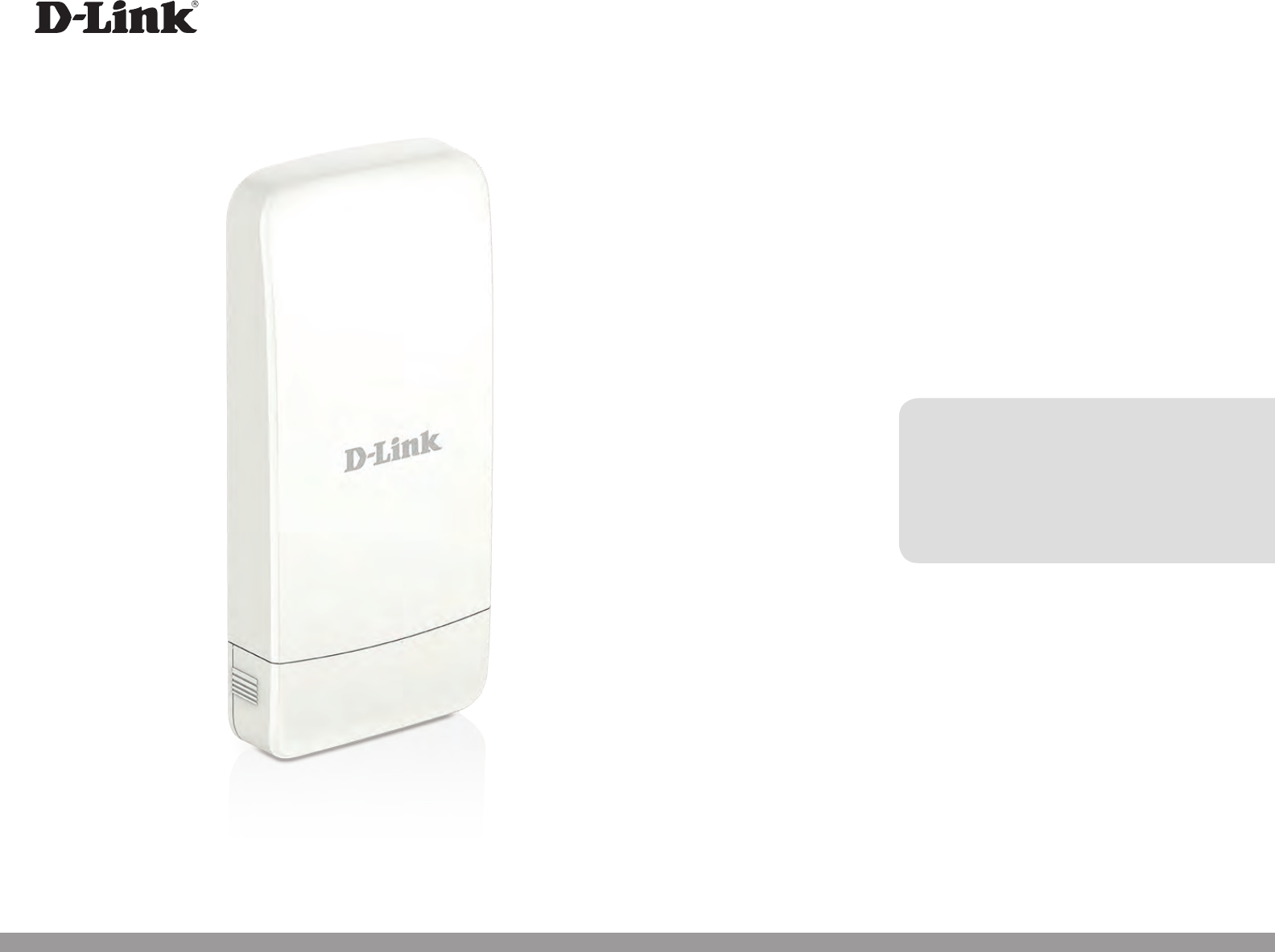
User Manual
Version 1.0 | 05/12/2015
DAP-3320
Wireless PoE Outdoor Access point

2D-Link DAP-3320 User Manual
Table of Contents
Product Overview .............................................................. 4
Package Contents .........................................................................4
System Requirements ................................................................. 5
Introduction ................................................................................... 6
Features ............................................................................................8
Hardware Overview .....................................................................9
Connections ...........................................................................9
Installation .......................................................................10
Wireless Installation Considerations ....................................12
Conguration ...................................................................13
Web-based Conguration Utility ..........................................13
Wireless Settings .................................................................14
LAN Settings .........................................................................19
Advanced Settings ............................................................20
Performance .........................................................................20
Multi-SSID ..............................................................................24
VLAN ........................................................................................25
Add/Edit VLAN ................................................................26
DHCP Server .........................................................................27
Dynamic Pool Settings ................................................. 27
Static Pool Settings .......................................................29
Current IP List ..................................................................30
Filter .........................................................................................31
Schedule ................................................................................32
Maintenance ................................................................................34
Administration Settings ...................................................34
Firmware and SSL Certication Upload ......................37
Conguration File ...............................................................38
Time and Date ...................................................................... 39
Status ..............................................................................................40
Device Information ............................................................40
Client Information ..............................................................41
Ethernet Information ......................................................... 42
WLAN Information .............................................................43
Conguration ...............................................................................44
Save and Active ..............................................................44
Discard Changes ............................................................45
System ............................................................................................46
Help .................................................................................................47
Wireless Security .............................................................48
What is WEP? ................................................................................49
Congure WEP .............................................................................50
What is WPA? ................................................................................51
Congure WPA/WPA2 Personal .............................................52
Congure WPA/WPA2 Enterprise ..........................................53
Connect to a Wireless Network ....................................... 54
Using Windows® XP ....................................................................54
Congure WPA-PSK .................................................................... 55
Using Windows Vista® ...............................................................57
Congure WPA-PSK .................................................................... 59
Using Windows® 7 .......................................................................60
Table of Contents

3D-Link DAP-3320 User Manual
Table of Contents
Troubleshooting ..............................................................63
Wireless Basics .................................................................67
What is Wireless? ......................................................................... 68
Tips ...................................................................................................70
Wireless Modes ............................................................................71
Networking Basics ...........................................................72
Check your IP address ...............................................................72
Statically Assign an IP address ...............................................73
Technical Specications .................................................. 74
Warranty ...........................................................................75

4D-Link DAP-3320 User Manual
Section 1 - Product Overview
Note: Using a power supply with a dierent voltage rating or PoE injector than the one included with the DAP-3320 will cause
damage and void the warranty for this product.
Package Contents
DAP-3320 Wireless PoE Outdoor Access point
Quick Installation Guide
Grounding Wire
Power Over Ethernet Injector
Power Adapter
Wall Mount

5D-Link DAP-3320 User Manual
Section 1 - Product Overview
System Requirements
Network Requirements
• An Ethernet-based Network
• IEEE 802.11n/g wireless clients (AP Mode)
• IEEE 802.11n/g wireless network (AP Mode)
Web-based Conguration
Utility Requirements
Computer with the following:
• Windows®, Macintosh, or Linux-based operating system
• An installed Ethernet adapter
Browser Requirements:
• Internet Explorer® 7 and higher
• Mozilla Firefox 12.0 and higher
• Google™ Chrome 20.0 and higher
• Apple Safari 4 and higher
Windows® Users: Make sure you have the latest version of Java installed.
Visit www.java.com to download the latest version.

6D-Link DAP-3320 User Manual
Section 1 - Product Overview
Introduction
D-Link, an industry leader in networking, introduces the new D-Link DAP-3320 Wireless PoE outdoor Access Point. With the
ability to transfer les with a maximum wireless signal rate of up to 300 Mbps, the DAP-3320 gives you ability to add high-
speed wireless hotspot network access to places outside of your internal networking environment.
The DAP-3320 features Wi-Fi Protected Access (WPA-PSK/WPA2-PSK) to provide an enhanced level of security for wireless data
communications. The DAP-3320 also includes additional security features to keep your wireless hotspot connection safe from
unauthorized access.

7D-Link DAP-3320 User Manual
Section 1 - Product Overview
Ultimate Performance
The D-Link Wireless PoE Outdoor Access point (DAP-3320) is an 802.11n compliant device that delivers real world performance of up
to 300 Mbps2, much faster than an 802.11g wireless connection (also faster than a 100 Mbps wired Ethernet connection). Create a
secure wireless network to share photos, les, music, video, printers, and network storage outside of your normal internal networking
environment. Built to withstand harsh environments, the DAP-3320 also excels in connecting separate networks that cannot be joined
physically using traditional medium. The built-in 10dBi sector antenna is designed to deliver high powered performance, ensuring
that wireless coverage will cover even hard to reach locations.
Multiple Operation Modes
The DAP-3320 features seven dierent operation modes, allowing it to adapt to any situation. As a standard wireless access
point (AP) the DAP-3320 can connect to a wide range of devices that are 802.11 n/g/b compliant. In wireless distribution system
(WDS) mode it can expand current wireless coverage without the need for a wired backbone link. As a wireless client it can
connect to an existing AP, and expand the network physically with the built-in 10/100 Ethernet ports.
Total Security
The DAP-3320 supports 64/128-bit WEP data encryption and WPA/WPA2 security functions. In addition, it provides MAC Address
Filtering to control user access, and the Disable SSID Broadcast function to limit unauthorized access to the internal network.
Network administrators have multiple options for managing the DAP-3320, including Web (HTTP) or Secured Web (HTTPS).
For advanced network management, administrators can use SNMP v1, v2c, v3 to congure and manage access points.
2 Maximum wireless signal rate derived from IEEE Standard 802.11g and 802.11n specications. Actual data throughput will vary. Network conditions and environmental factors,
including volume of network trac, building materials and construction, and network overhead, lower actual data throughput rate. Environmental conditions will adversely
aect wireless signal range.

8D-Link DAP-3320 User Manual
Section 1 - Product Overview
• Faster Wireless Networking - The DAP-3320 provides an up to 300 Mbps* wireless connection with other 802.11n
wireless clients. This capability allows users to participate in real-time activities online, such as video streaming, online
gaming, and real-time audio.
• Compatible with IEEE802.11g Devices - The DAP-3320 is still fully compatible with the 802.11g standards, so it can
connect with existing 802.11g adapters.
• Power of Ethernet - The DAP-3320 supports IEEE 802.3af PoE (Power over Ethernet) which enables it to be supplied
with Ethernet over a power cable or IEEE 802.3af PoE switch.
• Convenient Installation - The DAP-3320 features a wall/pole mount in the rear for easy setup on poles or walls.
• Weather Resistance - The DAP-3320 is built to withstand harsh environment, and it compliant with IP55 Dust/Water-
proof standard.
Features
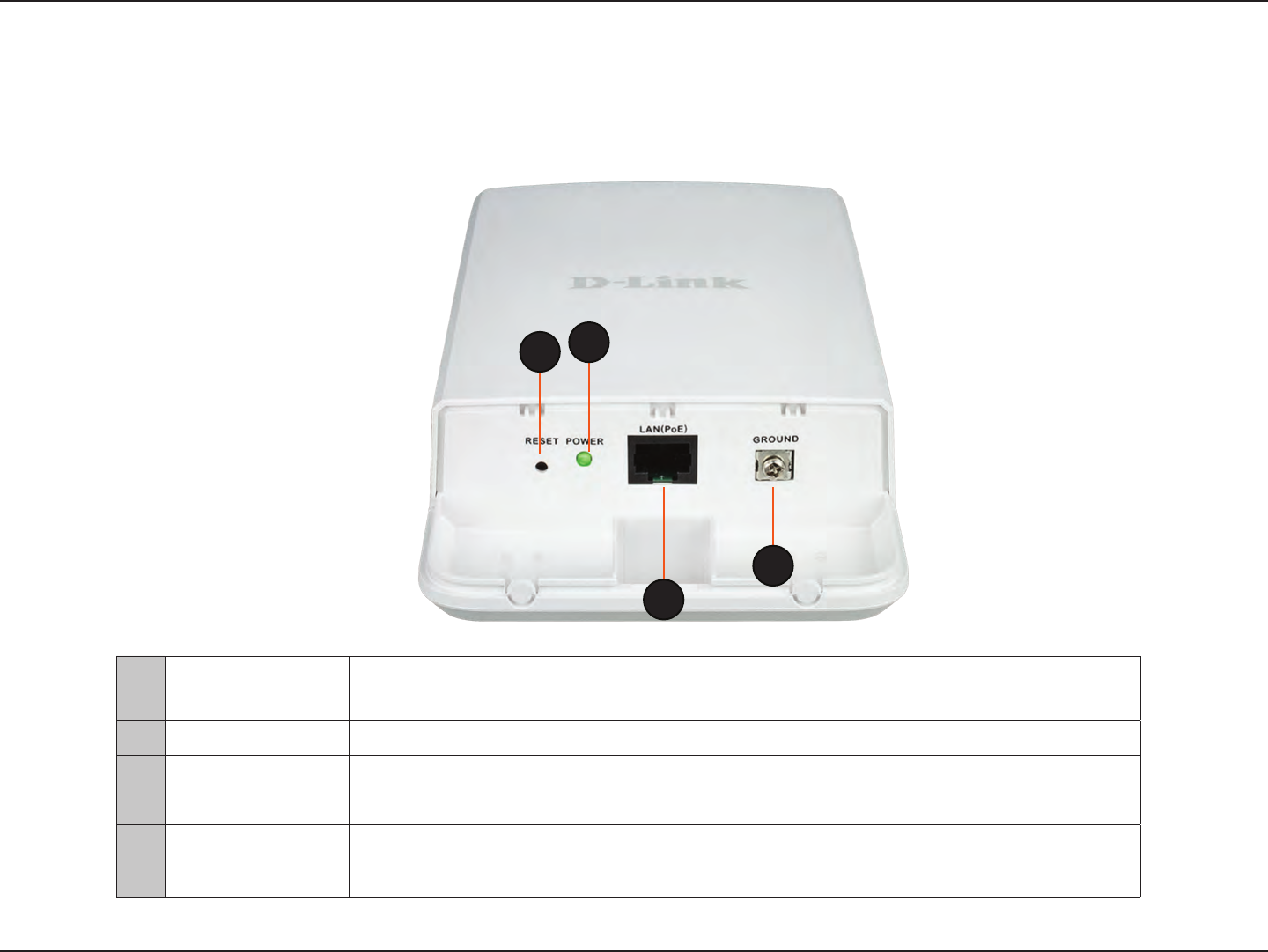
9D-Link DAP-3320 User Manual
Section 1 - Product Overview
Hardware Overview
Connections
1 Reset button Hold the reset button for at least 5 seconds to reset the device back to the factory default
settings. All the LEDs will turn on for 2 second and then begin the reboot process.
2 LED A solid green light indicates the device is powered and ready.
3Reset LAN (PoE)
port
Power is supplied through the LAN cable connected in this port via the Power over Ethernet
Injector.
4Grounding Wire
Connector
Connects to a grounding wire.
12
3
4

10D-Link DAP-3320 User Manual
Section 2 - Installation
Installation
First, you will need to congure the DAP-3320 with a computer connected directly to the unit. The following pages explains
how to set up the DAP-3320 in order to be properly congured and then tested to work as desired.
The DAP-3320 acts as a central connection point for any device (client) that has a 802.11n or backward-compatible 802.11g
wireless network interface and is within range of the AP. Clients must use the same SSID (wireless network name) and channel
as the AP in order to connect. If wireless security is enabled on the AP, the client will need to enter a password to connect to
the AP. In Access Point mode, multiple clients can connect to the AP at the same time.
STEP 1: Connect an Ethernet Cable to the LAN (PoE) Port on the AP.
The port connection cover can be removed using a a small amount of force so that it pops o. It can be reattached by snapping it back into place.
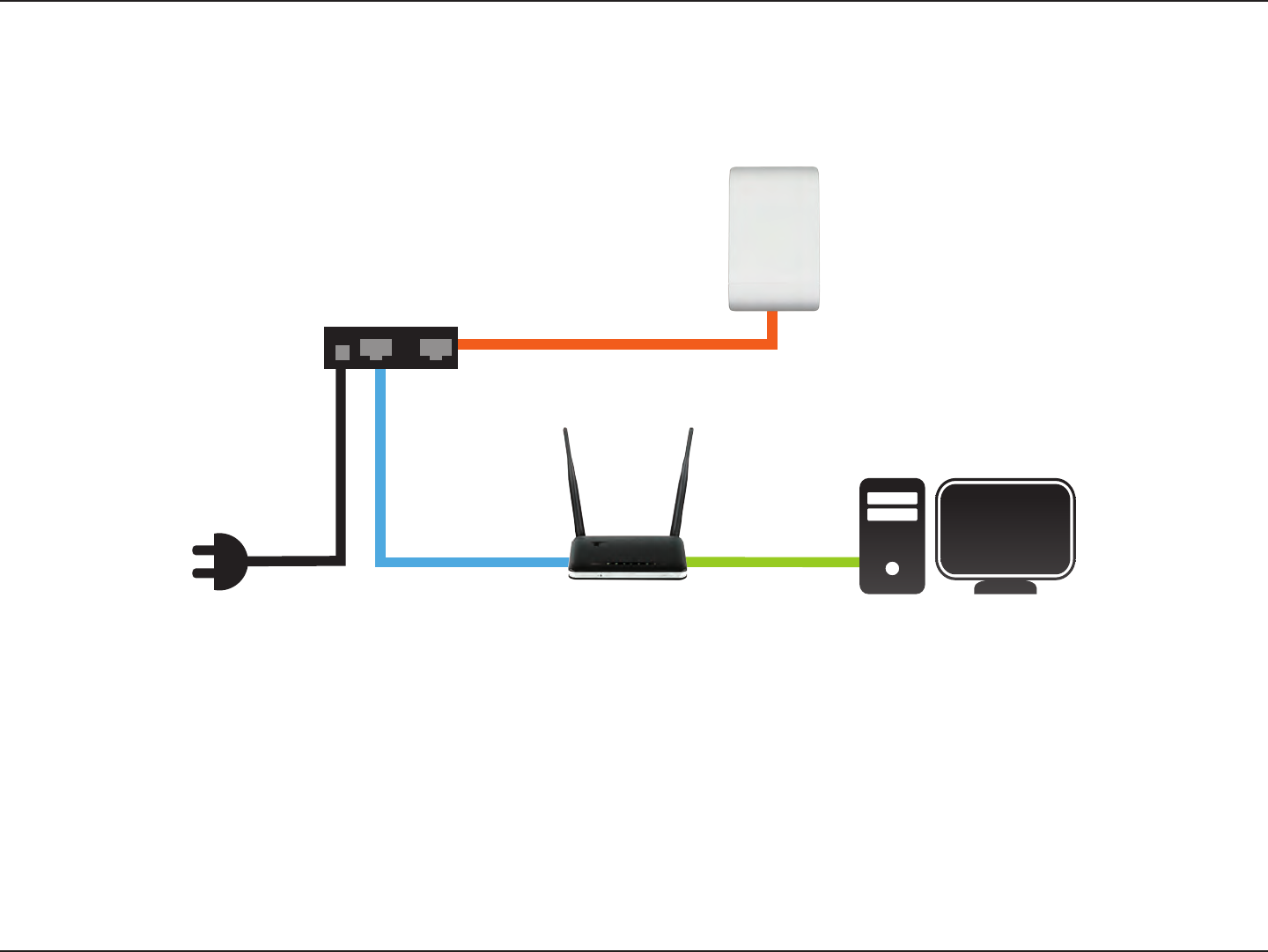
11D-Link DAP-3320 User Manual
Section 2 - Installation
A. Connect the Ethernet cable (connected to the AP in STEP 1) from the AP to the “P+DATA OUT” port on the
PoE Injector.
B. Connect an Ethernet cable from a router/switch or PC to the “DATA IN” port on the PoE Injector.
C. Attach the power adapter to the connector labeled “POWER IN” on the PoE Injector, and attach it into an
electrical outlet.
P+DATA OUT
DATA IN
PoE Injector A
CB
AP
STEP 2: Connect the AP to Your Network
Power

12D-Link DAP-3320 User Manual
Section 2 - Installation
Wireless Installation Considerations
The D-Link Wireless PoE Outdoor Access point lets you access your network using a wireless connection from virtually anywhere
within the operating range of your wireless network. Keep in mind, however, that the number, thickness and location of walls,
ceilings, or other objects that the wireless signals must pass through, may limit the range. Typical ranges vary depending on
the types of materials and background RF (radio frequency) noise in your home or business. The key to maximizing wireless
range is to follow these basic guidelines:
1. Keep the number of walls and ceilings between the D-Link access point and other network devices to a minimum.
Each wall or ceiling can reduce your adapter’s range from 3-90 feet (1-30 meters). Position your devices so that
the number of walls or ceilings is minimized.
2. Be aware of the direct line between network devices. A wall that is 1.5 feet thick (.5 meters), at a 45-degree
angle appears to be almost 3 feet (1 meter) thick. At a 2-degree angle it looks over 42 feet (14 meters) thick!
Position devices so that the signal will travel straight through a wall or ceiling (instead of at an angle) for better
reception.
3. Building materials make a dierence. A solid metal door or aluminum studs may have a negative eect on
range. Try to position access points, wireless access points, and computers so that the signal passes through
drywall or open doorways. Materials and objects such as glass, steel, metal, walls with insulation, water (sh
tanks), mirrors, le cabinets, brick, and concrete will degrade your wireless signal.
4. Keep your product away (at least 3-6 feet or 1-2 meters) from electrical devices or appliances that generate RF
noise.
5. If you are using 2.4GHz cordless phones or X-10 (wireless products such as ceiling fans, lights, and home security
systems), your wireless connection may degrade dramatically or drop completely. Make sure your 2.4 Hz phone
base is as far away from your wireless devices as possible. The base transmits a signal even if the phone is not
in use.
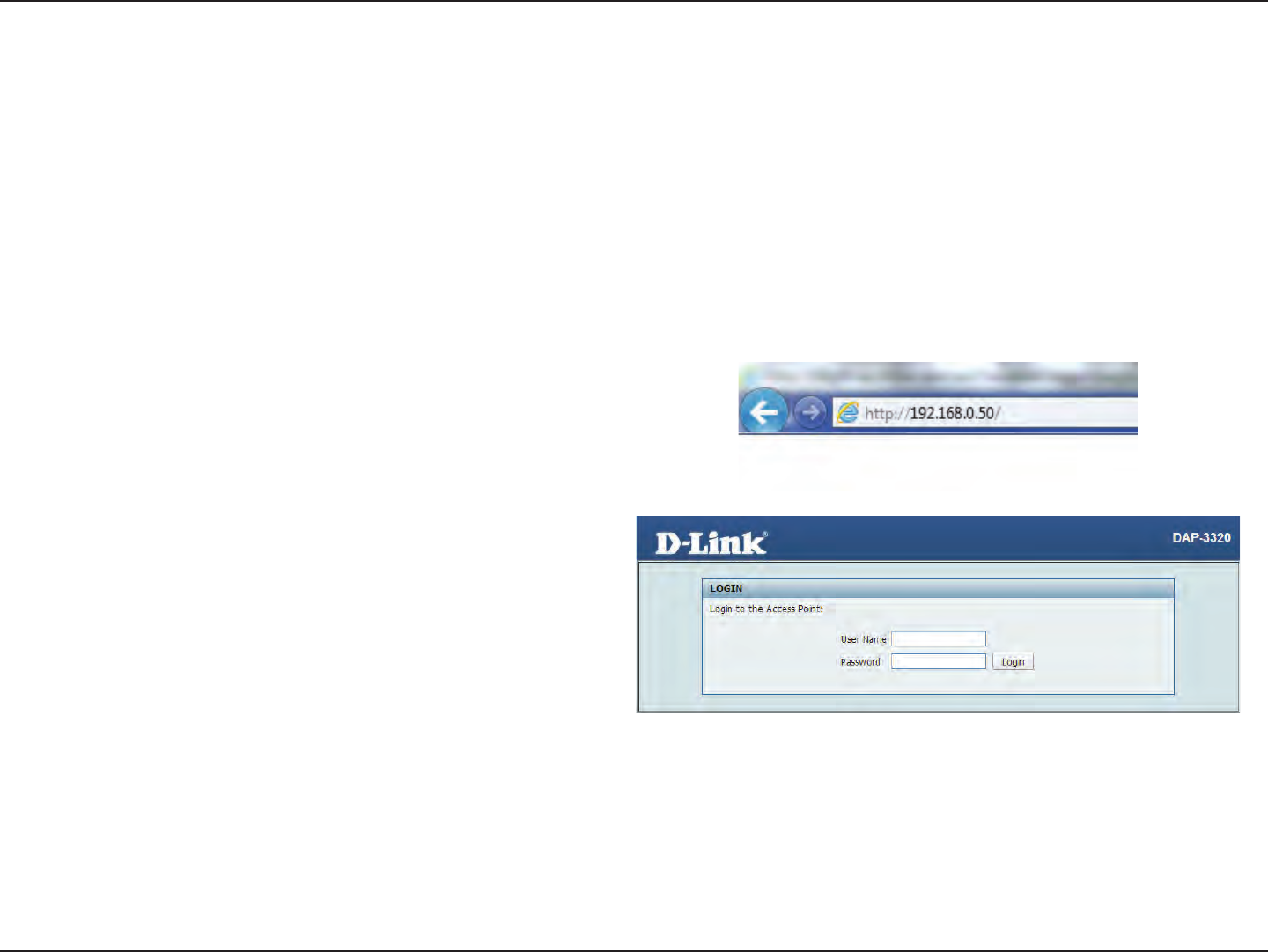
13D-Link DAP-3320 User Manual
Section 3 - Conguration
Conguration
This section will show you how to congure your new D-Link Wireless PoE Outdoor Access point using the web-based
conguration utility.
Web-based Conguration Utility
If you wish to change the default settings or optimise the
performance of the DAP-3320, you may use the web-based
conguration utility.
To access the conguration utility, open a web browser
such as Internet Explorer and enter http://192.168.0.50
Select admin and then enter your password. Leave the
password blank by default.
If you get a Page Cannot be Displayed error, please refer to
“Troubleshooting” on page 63 for assistance.
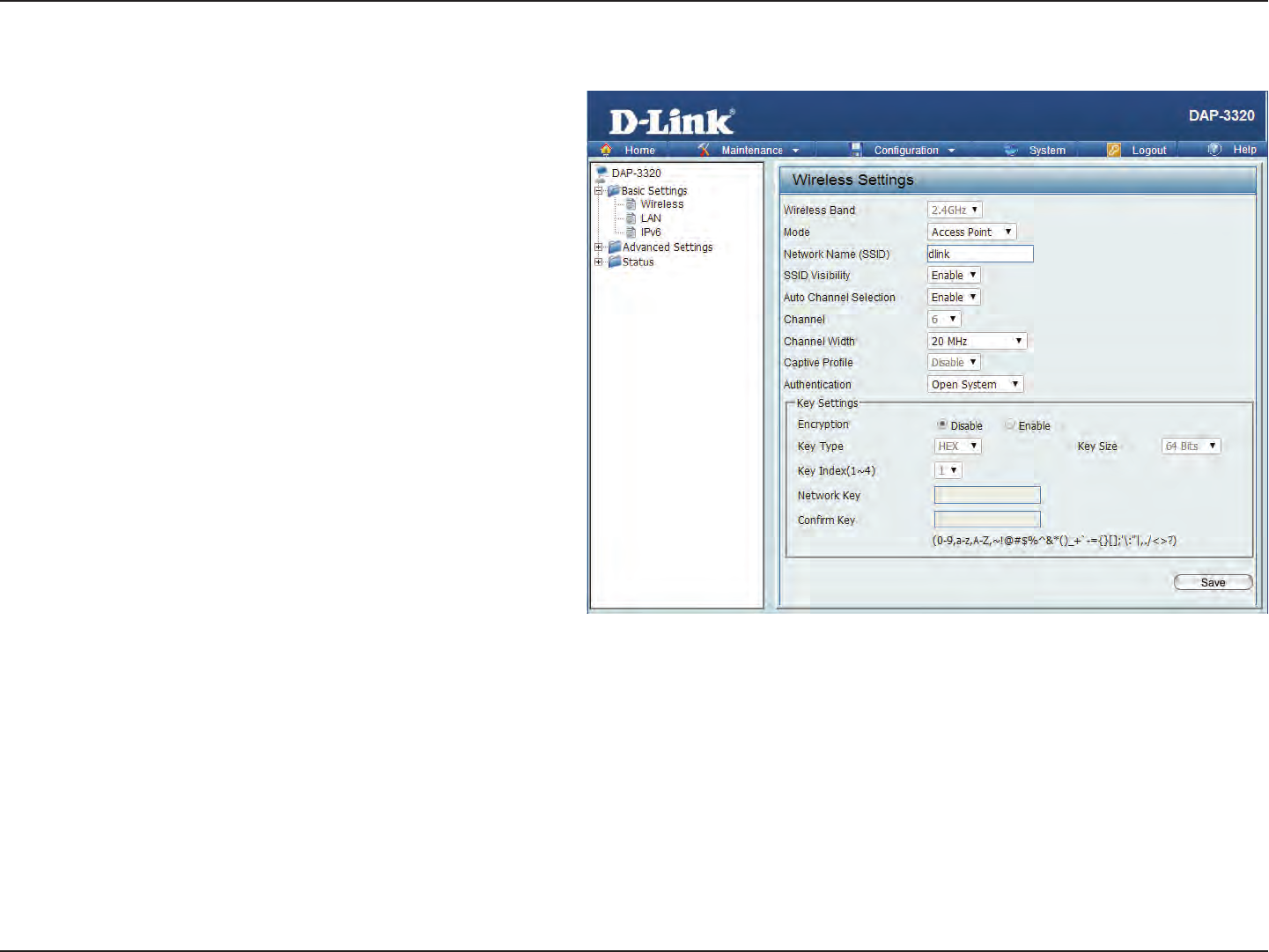
14D-Link DAP-3320 User Manual
Section 3 - Conguration
Wireless Settings
Network Name
(SSID):
SSID Visibility:
Auto Channel
Selection:
Channel:
Channel Width:
Authentication:
Enter a name for your wireless network (SSID). For
security purposes, it is highly recommended to
change from the default network name.
Select Disabled if you do not want the SSID of
your wireless network to be broadcasted by the
DAP-3320. Your wireless clients will have to know
the SSID of your DAP-3320 in order to connect
to it.
The Auto Channel Scan setting can be selected to
allow the DAP-3320 to choose the channel with
the least amount of interference.
Indicates the channel setting for the DAP-3320.
The Channel can be changed to t the channel
setting for an existing wireless network or to
customize the wireless network. If you enable
Auto Channel Scan, this option will be grayed out.
Auto 20/40 - Select if you are using both 802.11n
and non-802.11n wireless devices. 20MHz - Select
if you are not using any 802.11n wireless clients.
Refer to “Wireless Security” on page 48 of this
manual for a detailed explanation of the wireless
security options.
This page will allow you to congure the wireless connection
for the DAP-3320. Please be aware that some menu options will
change depending on which type of security setting is used.
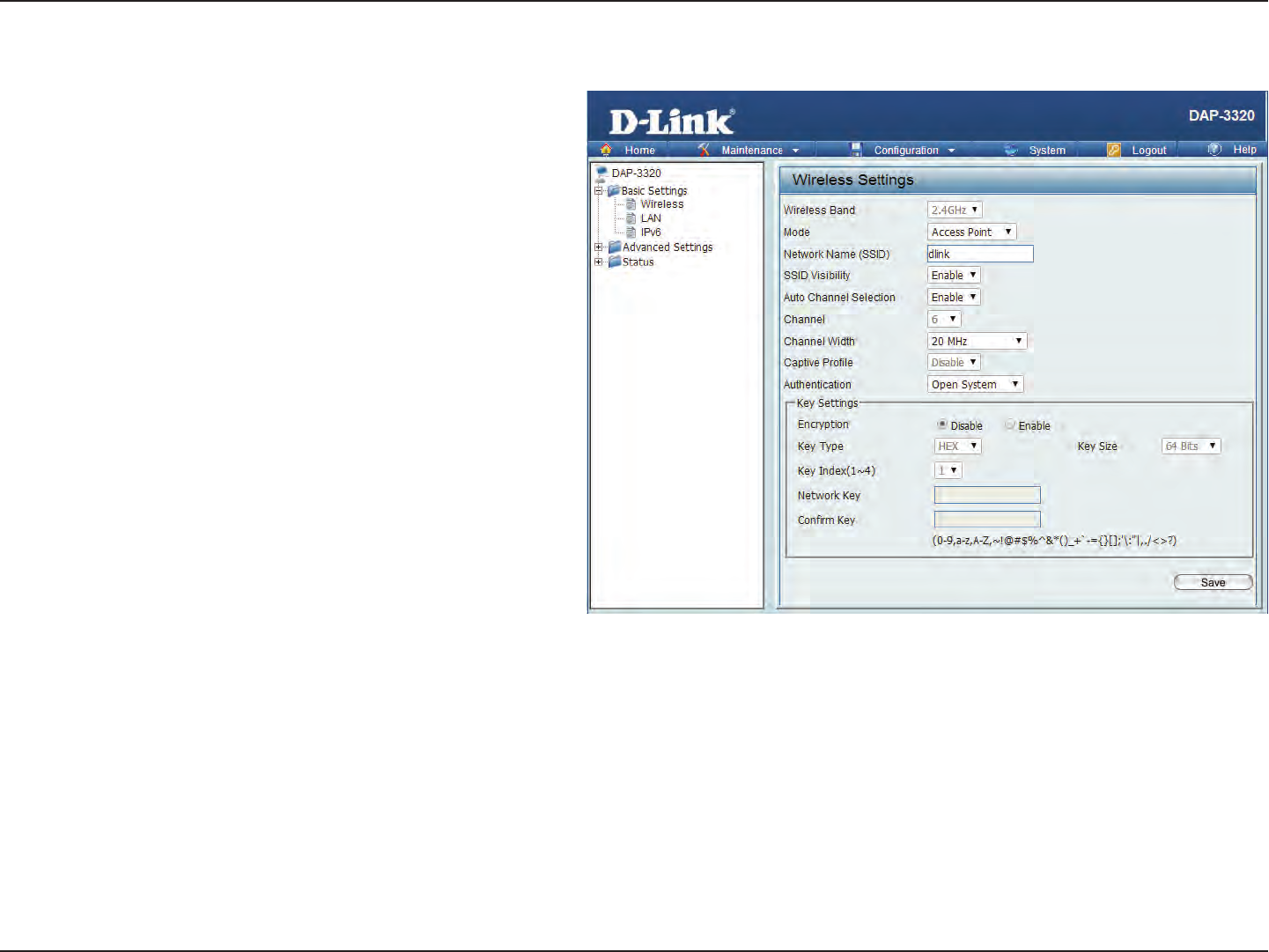
15D-Link DAP-3320 User Manual
Section 3 - Conguration
Encryption:
Key Type:
Key Size:
Key Index:
Network Key:
Conrm Key:
Use the radio button to disable or enable
encryption. (Encryption option only available
with Open System setting)
Select either HEX or ASCII as the key type.
Select 64 Bits or 128 Bits for your key size.
Select which key you want to be the active key.
Input up to four keys for encryption. You will
select one of these keys in the Key Index drop-
down menu.
Conrm the network key.
Click Save to commit your changes.
Note: Hexadecimal (HEX) digits consist of the
numbers 0-9 and the letters A-F.
ASCII (American Standard Code for Information
Interchange) is a code that represents English
letters using numbers ranging from 0-127.
Open System/Shared Key Authentication
If you selected Open System as your Authentication, you will
see these settings:
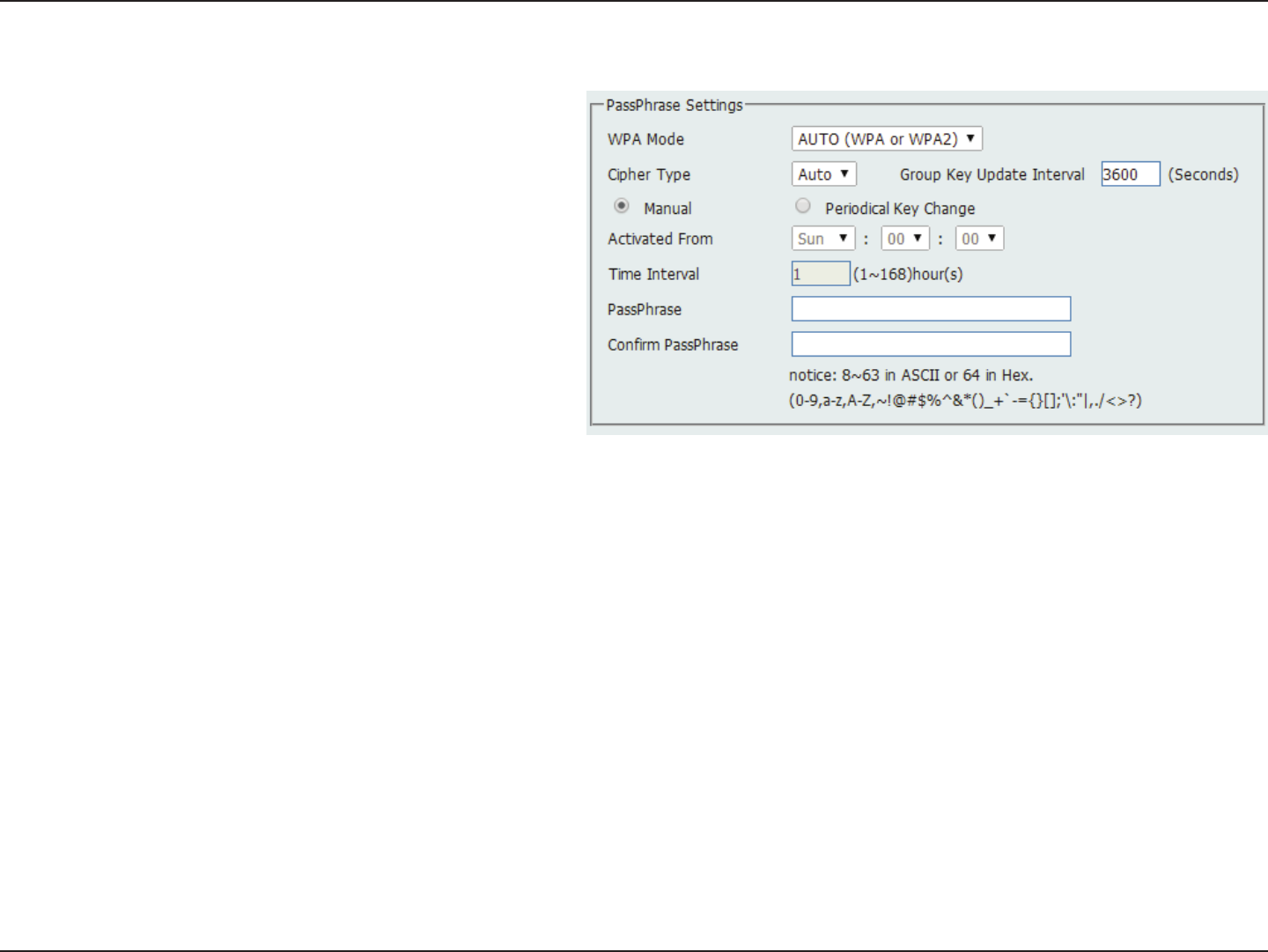
16D-Link DAP-3320 User Manual
Section 3 - Conguration
WPA/WPA2-Personal Authentication
When WPA-Personal is selected for
Authentication type, you must also select a
WPA mode from the drop-down menu: AUTO
(WPA or WPA2), WPA2 Only, or WPA Only.
WPA and WPA2 use dierent algorithms. AUTO
(WPA or WPA2) allows you to use both WPA
and WPA2.
When you select WPA-Personal, you must also
select AUTO, AES, or TKIP from the drop-down
menu.
Select the interval during which the group
key will be valid. The default value of 1800 is
recommended. Select Manual to enter your
key (Passphrase).
When you select WPA-Personal, please enter
a Passphrase in the corresponding elds.
WPA Mode:
Cipher Type:
Group Key
Update:
Passphrase
/ Conrm
Passphrase:
If you selected WPA/WPA2-Personal Authentication as your
Authentication, you will see these settings:
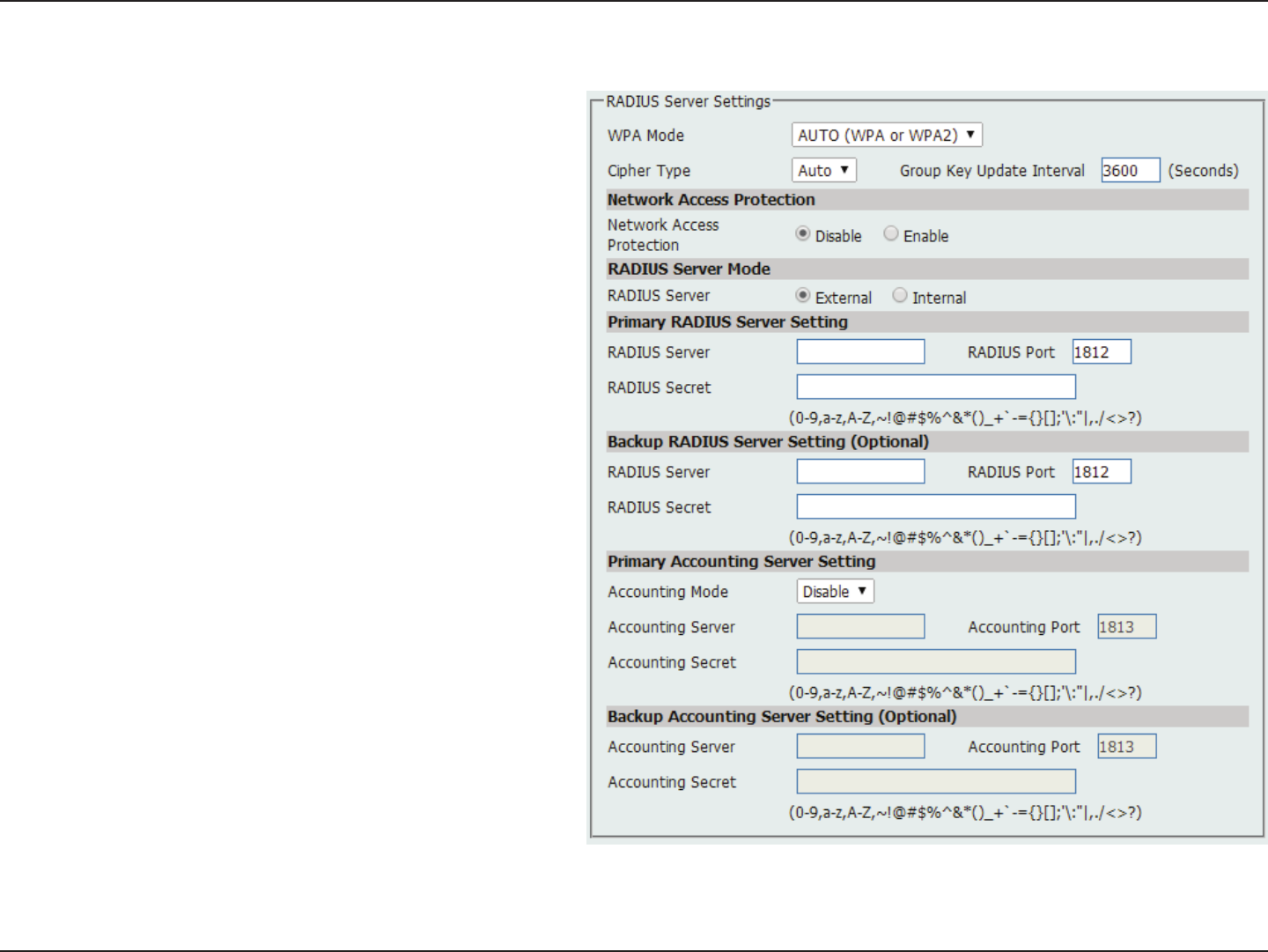
17D-Link DAP-3320 User Manual
Section 3 - Conguration
WPA/WPA2-Enterprise Authentication
When WPA-Enterprise is selected, you must
also select a WPA mode from the drop-down
menu: AUTO (WPA or WPA2), WPA2 Only,
or WPA Only. WPA and WPA2 use different
algorithms. AUTO (WPA or WPA2) allows you
to use both WPA and WPA2.
When WPA-Enterprise is selected, you must
also select a cipher type from the drop-down
menu: Auto, AES, or TKIP.
Select the interval during which the group key
will be valid. The recommended value is 1800.
A lower interval may reduce data transfer rates.
Enter the IP address of your RADIUS server.
Enter the RADIUS port.
Enter the RADIUS secret.
WPA Mode:
Cipher Type:
Group Key
Update
Interval:
RADIUS Server:
RADIUS Port:
RADIUS Secret:
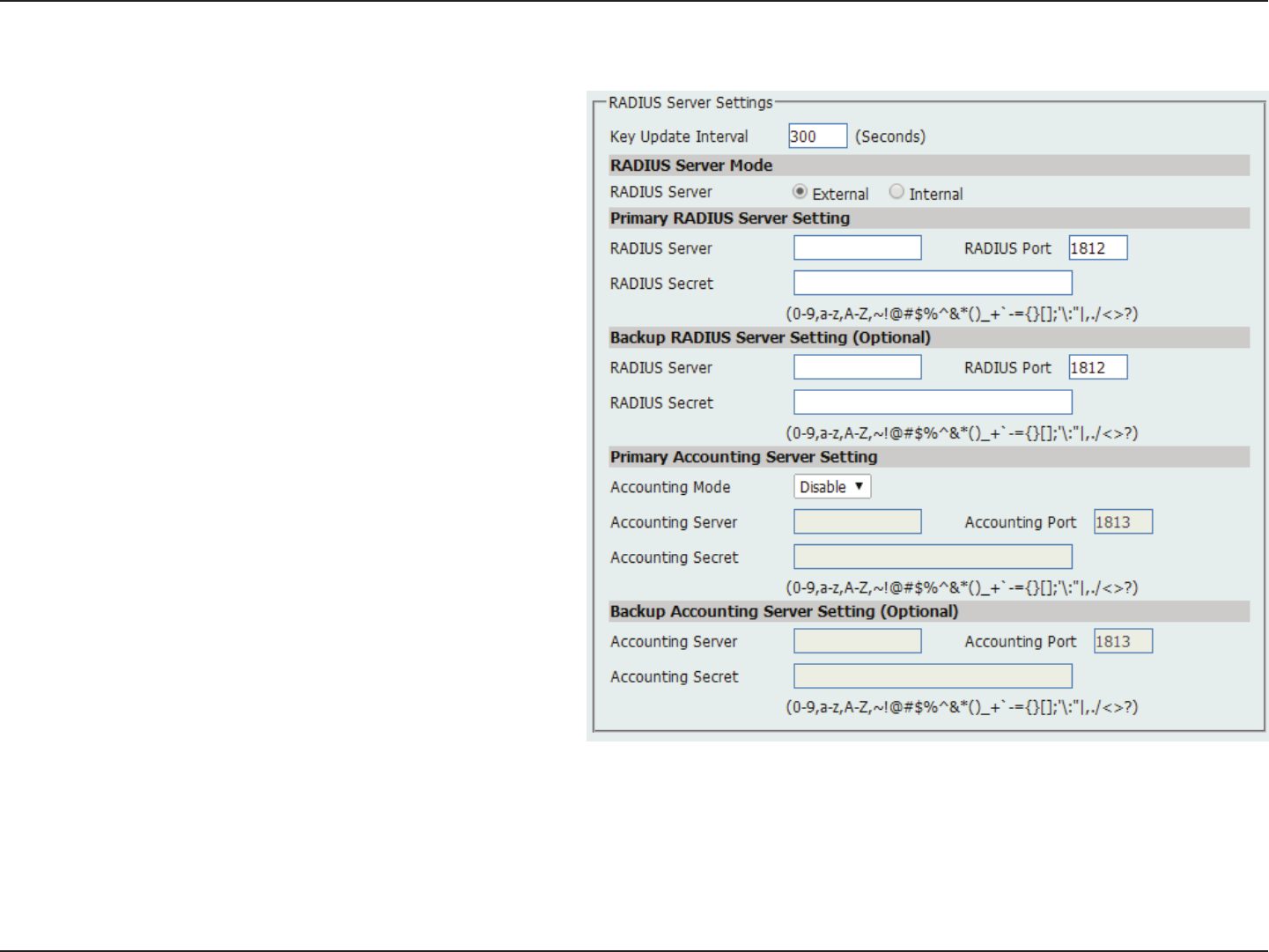
18D-Link DAP-3320 User Manual
Section 3 - Conguration
802.1x Authentication
Select 64 Bits or 128 Bits for your key size.
Enter the IP address of your RADIUS server.
Enter the RADIUS port.
Enter the RADIUS secret.
Key Size:
RADIUS Server:
RADIUS Port:
RADIUS Secret:
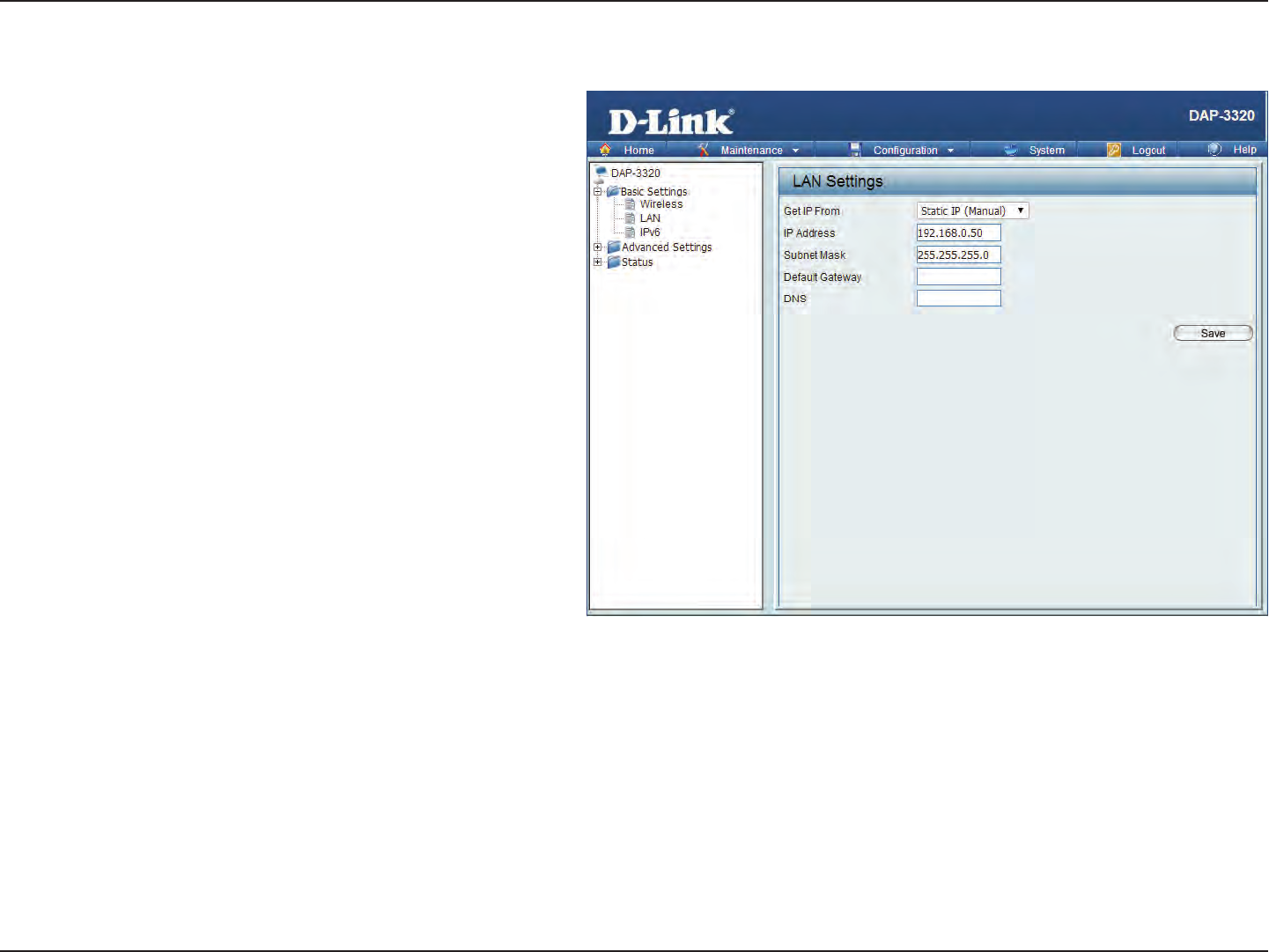
19D-Link DAP-3320 User Manual
Section 3 - Conguration
LAN Settings
Get IP From:
IP Address:
IP Subnet
Mask:
Gateway IP
Address:
DNS Server
Select an option to choose how the AP will
obtain an IP address to use on the local
network. If this is set to Static, you will need
to manually enter the necessary information.
Enter the IP address of the router. The default
IP address is 192.168.0.50. If you change the IP
address, once you click Save, you will need to
enter the new IP address in your browser to get
back into the conguration utility.
Enter the Subnet Mask. The default subnet
mask is 255.255.255.0.
Enter the gateway IP Address for your local
network.
Congure the IP address of the preferred DNS
server.
This section will allow you to change the local network
settings of the DAP-3320. After making your changes,
click the Save button.
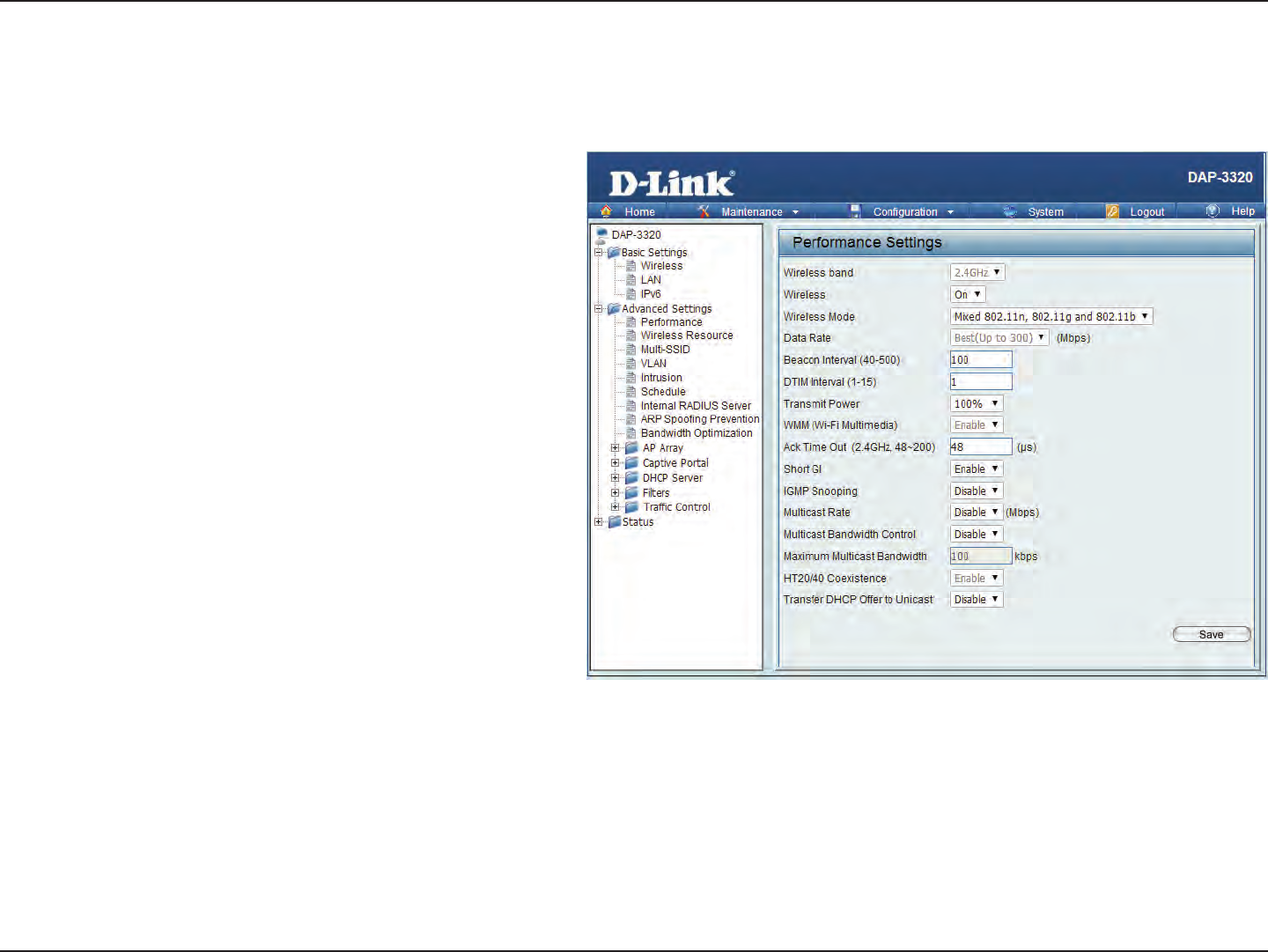
20D-Link DAP-3320 User Manual
Section 3 - Conguration
Advanced Settings
Performance
Wireless:
Wireless Mode:
Data Rate:
Beacon
Interval:
Use the drop-down menu to turn the wireless
function On or O.
The dierent combination of clients that can be
supported include Mixed 802.11n, 802.11g
and 802.11b, Mixed 802.11g and 802.11b
and 802.11n Only.
Note: When backwards compatibility is enabled
for legacy (802.11g/b) clients, degradation of
802.11n wireless performance is expected.
Set the base transfer rate of wireless adapters
on the wireless LAN. The AP will adjust the base
transfer rate depending on the base rate of
the connected device. This option is enabled
in Mixed 802.11g and 802.11b mode. The
choices available are Best (Up to 54), 54, 48,
36, 24, 18, 12, 9, 6, 11, 5.5, 2 or 1.
Beacons are packets sent by an access point
to synchronize a wireless network. Specify
a value in milliseconds. The default (100)
is recommended. Setting a higher beacon
interval can help to save the power of wireless
clients, while setting a lower one can help a
wireless client connect to an access point faster.
This options on this page will allow you to ne tune the
wireless connectivity of the access point.
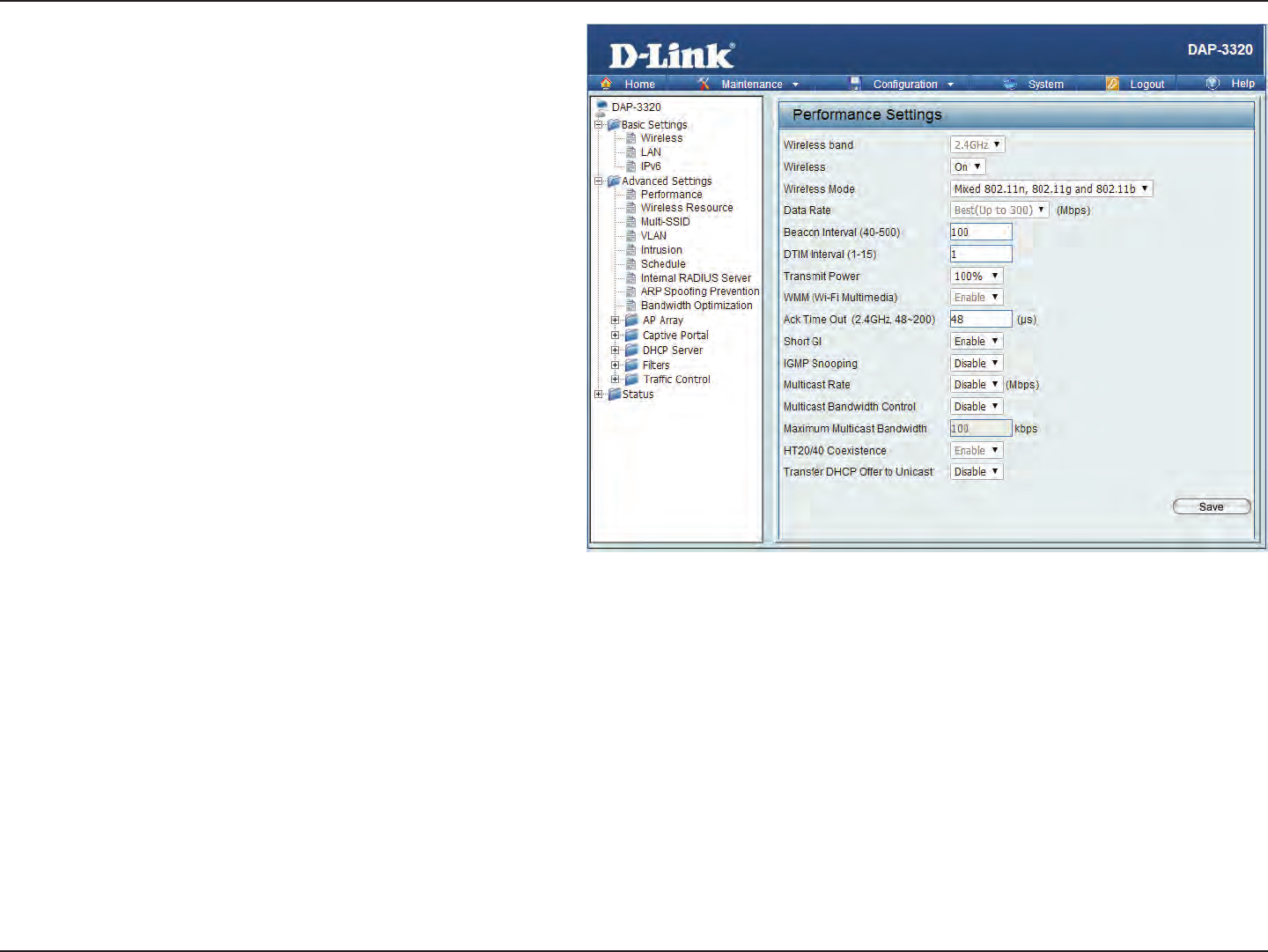
21D-Link DAP-3320 User Manual
Section 3 - Conguration
DTIM Interval
Transmit
Power:
Spanning Tree
Protocol:
Ack Time Out:
Slot Time:
Set a Delivery Traffic Indication Message
setting between 1 and 255. The default value
is 1. DTIM is a countdown informing clients of
the next window for listening to broadcast and
multicast messages.
This setting determines the power level of
the wireless transmission. Transmitting power
can be adjusted to eliminate overlapping of
wireless area coverage between two access
points where interference is a major concern.
For example, if wireless coverage is intended
for half of the area, then select 50% as the
option. Use the drop-down menu to select
100%, 50%, 25%, or 12.5%.
Select Enable or Disable. Enabling this option
will help prevent bridge loops and will provide
nearby AP’s with the information needed to
reliably route the network should one of the
other devices fail.
To effectively optimize throughput over
long distance links, enter a value for
Acknowledgement Time Out from 1 to 372
microseconds in the 2.4 GHz in the field
provided.
This setting is used to specify an amount of
time the AP will wait after a collision before
retransmitting a packet. Reducing the slot
time decreases the overall back-o, which will
increase throughput.
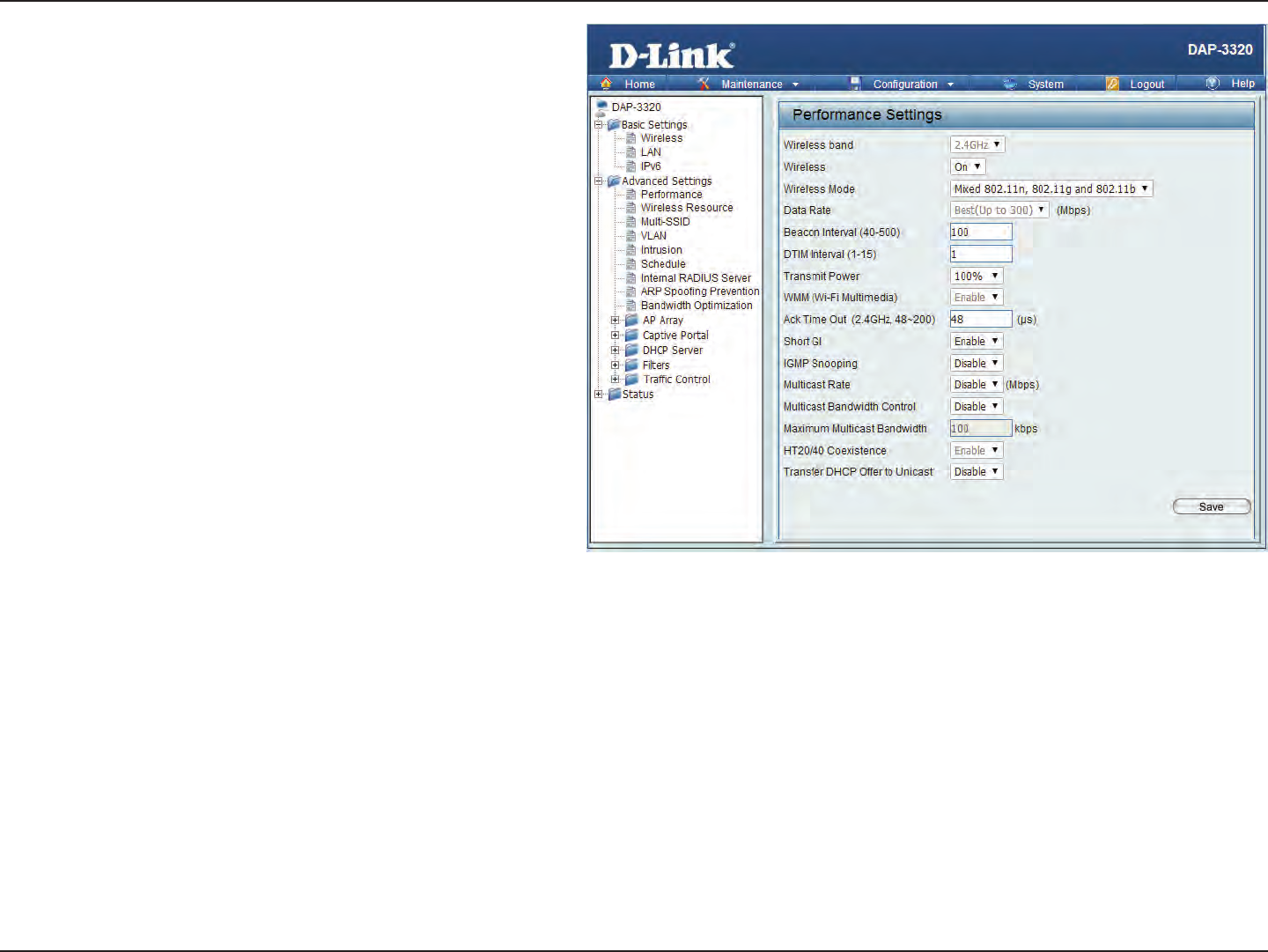
22D-Link DAP-3320 User Manual
Section 3 - Conguration
Select Enable or Disable. Enabling a short
guard interval can increase throughput.
However, be aware that it can also increase the
error rate in some installations due to increased
sensitivity to radio-frequency installations.
Select Enable or Disable. Internet Group
Management Protocol allows the AP to
recognize IGMP queries and reports sent
between routers and an IGMP host (wireless
STA). When IGMP snooping is enabled, the AP
will forward multicast packets to an IGMP host
based on IGMP messages passing through the
A P.
Enable this option to reduce interference
from other wireless networks in your area. If
the channel width is operating at 40MHz and
there is another wireless network’s channel
overlapping and causing interference, the
router will automatically change to 20MHz.
Select Enable or Disable. This is an option for
load balancing, and determines whether to
limit the number of users accessing this device.
The exact number is entered in the User Limit
eld. If this function is enabled and the number
of users exceeds this value, the DAP-3320 will
not allow any additional clients to associate
with the AP.
Short GI:
IGMP
Snooping:
Greeneld:
Connection
Limit:
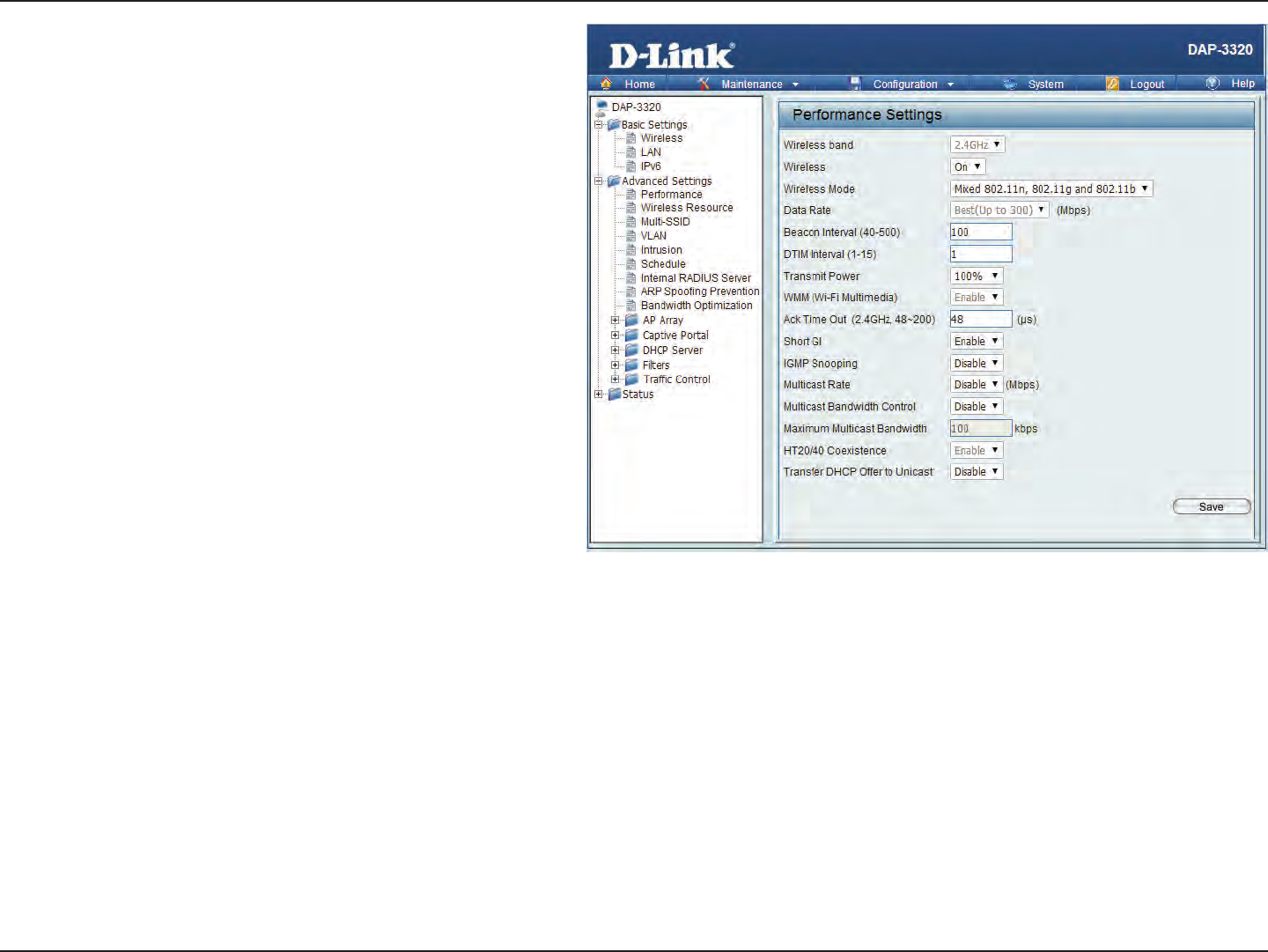
23D-Link DAP-3320 User Manual
Section 3 - Conguration
Set the maximum amount of users that
are allowed access (1-64 users). To use this
feature, the Connection Limit above must be
enabled. For most networks, a limit of 10 is
recommended. The default setting is 20.
If this option is enabled, connected clients will
not be able to view or access each other.
User Limit:
Client Isolation:
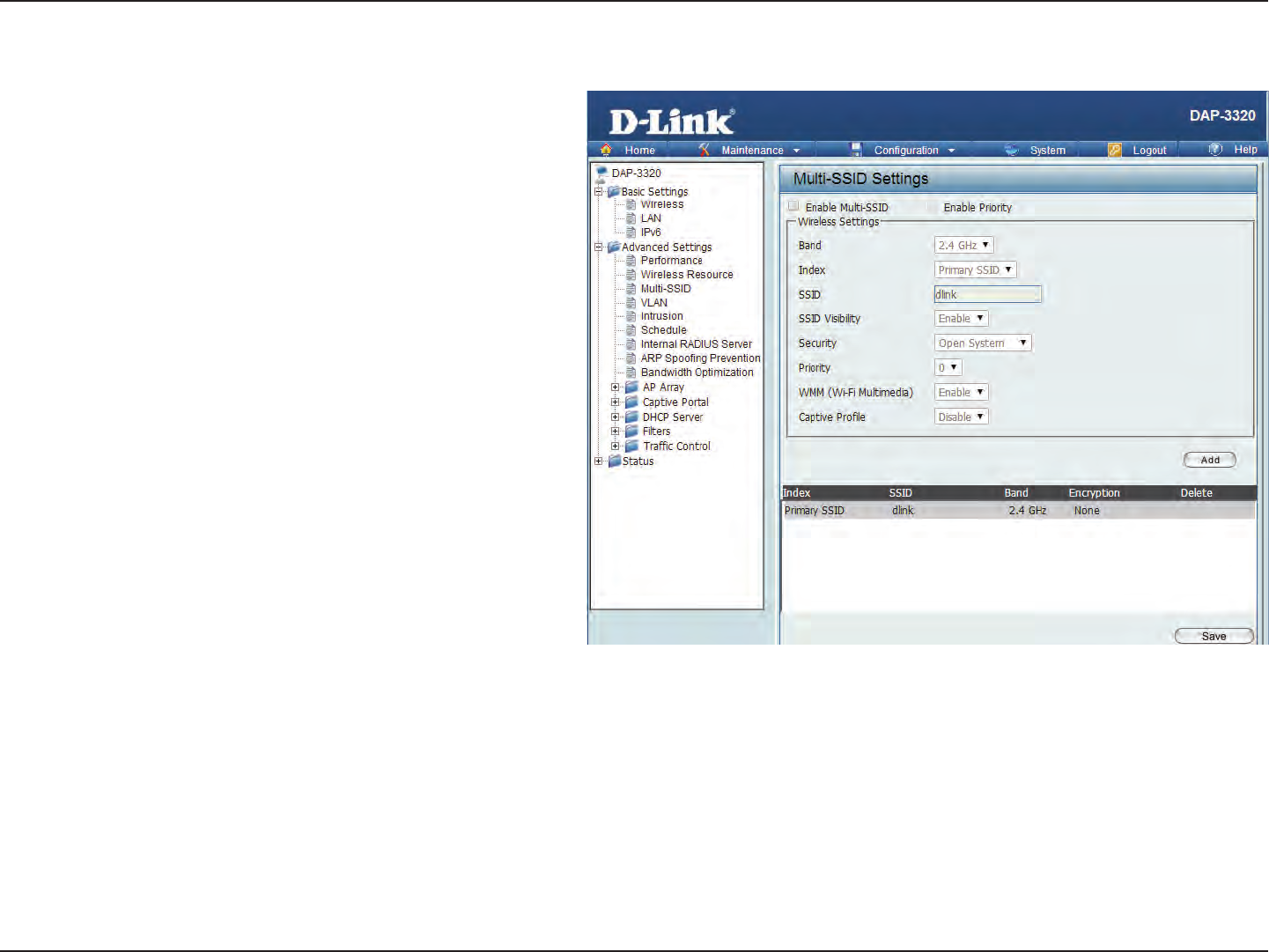
24D-Link DAP-3320 User Manual
Section 3 - Conguration
Multi-SSID
The device supports up to four multiple Service Set Identiers.
In the Basic > Wireless section, you can set the Primary SSID.
The SSID’s factory default setting is dlink. The SSID can be easily
changed to connect to an existing wireless network or to establish
a new wireless network.
Service Set Identifier (SSID) is the name
designated for a specic wireless local area
network (WLAN).
Enable or Disable SSID visibility. Enabling this
feature broadcasts the SSID across the network,
thus making it visible to all network users.
If this option is enabled, the connected clients
will not be able to view or access each other.
This option allows for load balancing on the
AP. It sets a limit on the number of connections
that can be used across all of the broadcasted
SSIDs.
Network
Name(SSID):
SSID Visibility:
Client Isolation:
Connection
Limit:
User Limit:
Authentication:
If Connection Limit is enabled, this option will allow you to input the maximum number of connected clients.
The Multi-SSID security can be Open System, WPA-Personal, WPA-Enterprise, or 802.1x.
For a detailed description of the Open System parameters, please go to page 15.
For a detailed description of the WPA-Personal parameters, please go to page 16.
For a detailed description of the WPA-Enterprise parameters, please go to page 17.
For a detailed description of the 802.1x parameters, please go to page 18.
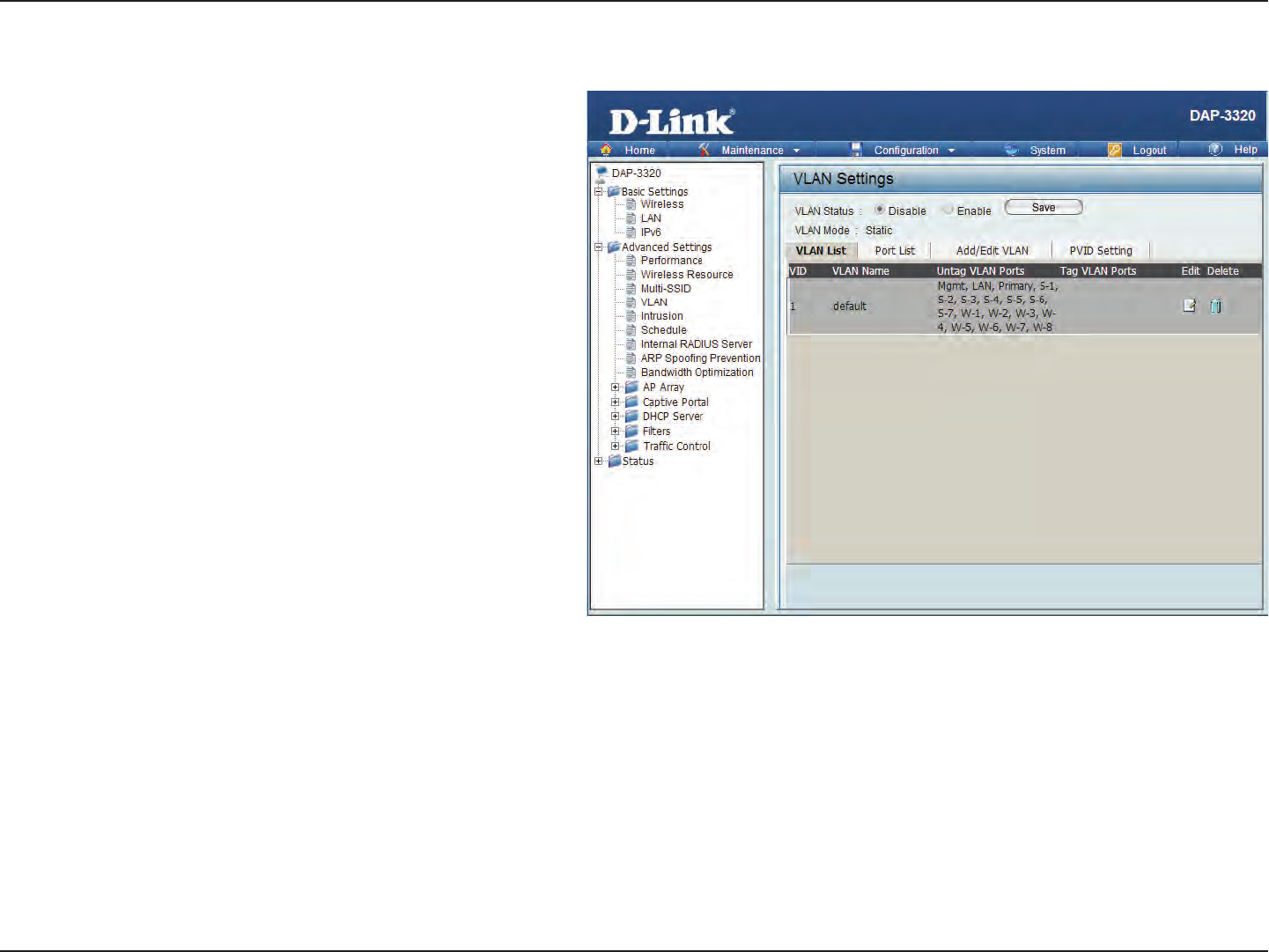
25D-Link DAP-3320 User Manual
Section 3 - Conguration
VLAN
The VLAN List tab displays the current VLANs. Clicking on Create
VLAN will allow you to create a new Virtual LAN with a Name and
ID. The LAN ports and the Multi-SSID function can be assigned
to a VLAN.
Use the radio button to toggle between Enable
or Disable. After changing the option, you will
need to click on Save to add or edit VLANs.
To remove or modify a VLAN, click on the
Delete or Edit button.
To add a VLAN, click on the Create VLAN
button.
VLAN Status:
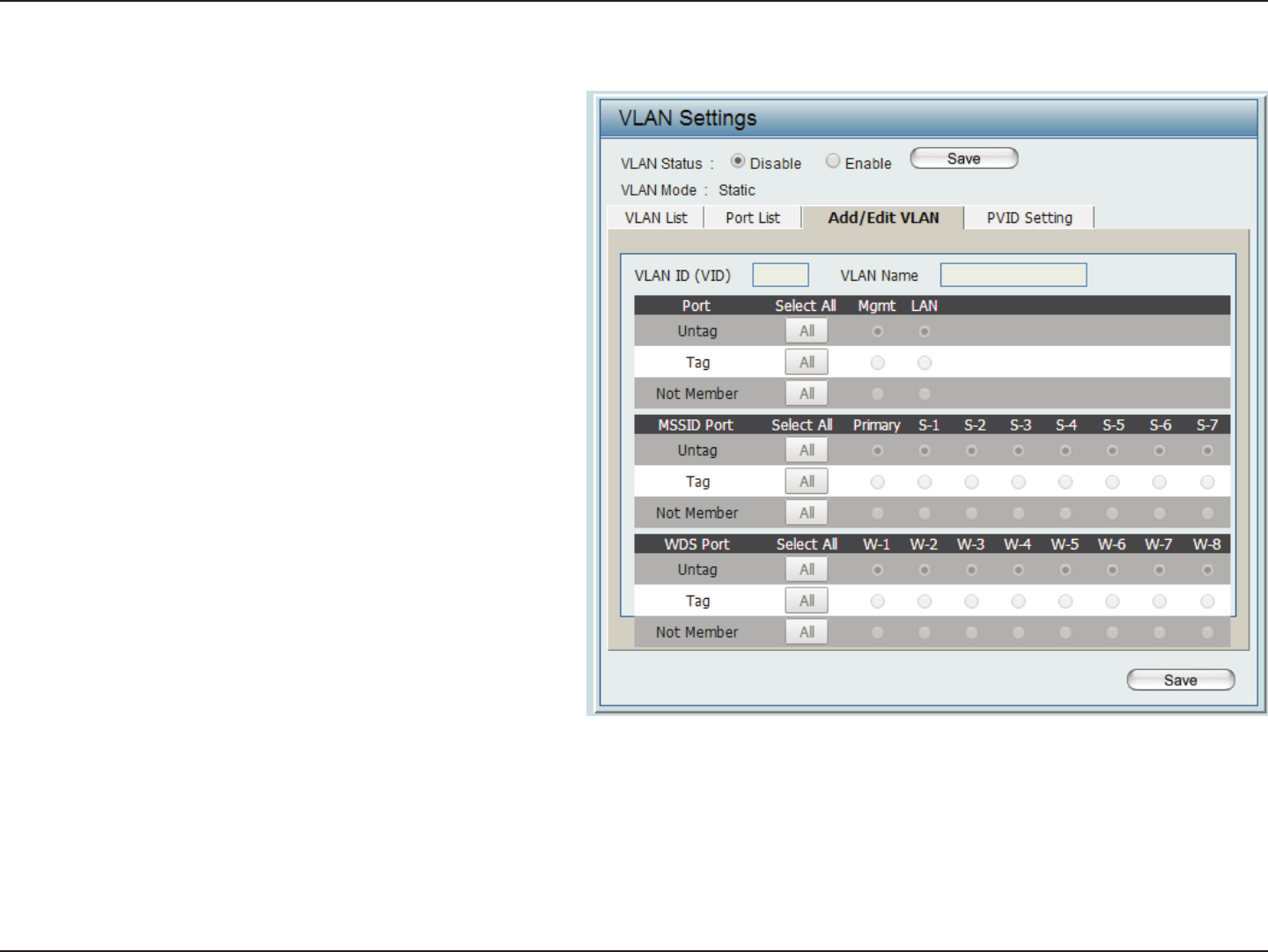
26D-Link DAP-3320 User Manual
Section 3 - Conguration
Add/Edit VLAN
The VLAN Setup tab is used to congure VLANs. Once you have
made the desired changes, click the Save button to let your
changes take eect.
Provide a number between 1 and 4094 for the
Internal VLAN.
Enter the VLAN to add or modify.
Select a LAN port to bind to the SSID.
Select the corresponding SSID to bind to the
LAN port in order to create a VLAN. You can nd
more information about setting up multiple
SSID’s by referring to “Multi-SSID” on page 24.
VLAN ID:
VLAN Name:
LAN Port:
Multi-SSID
Port:
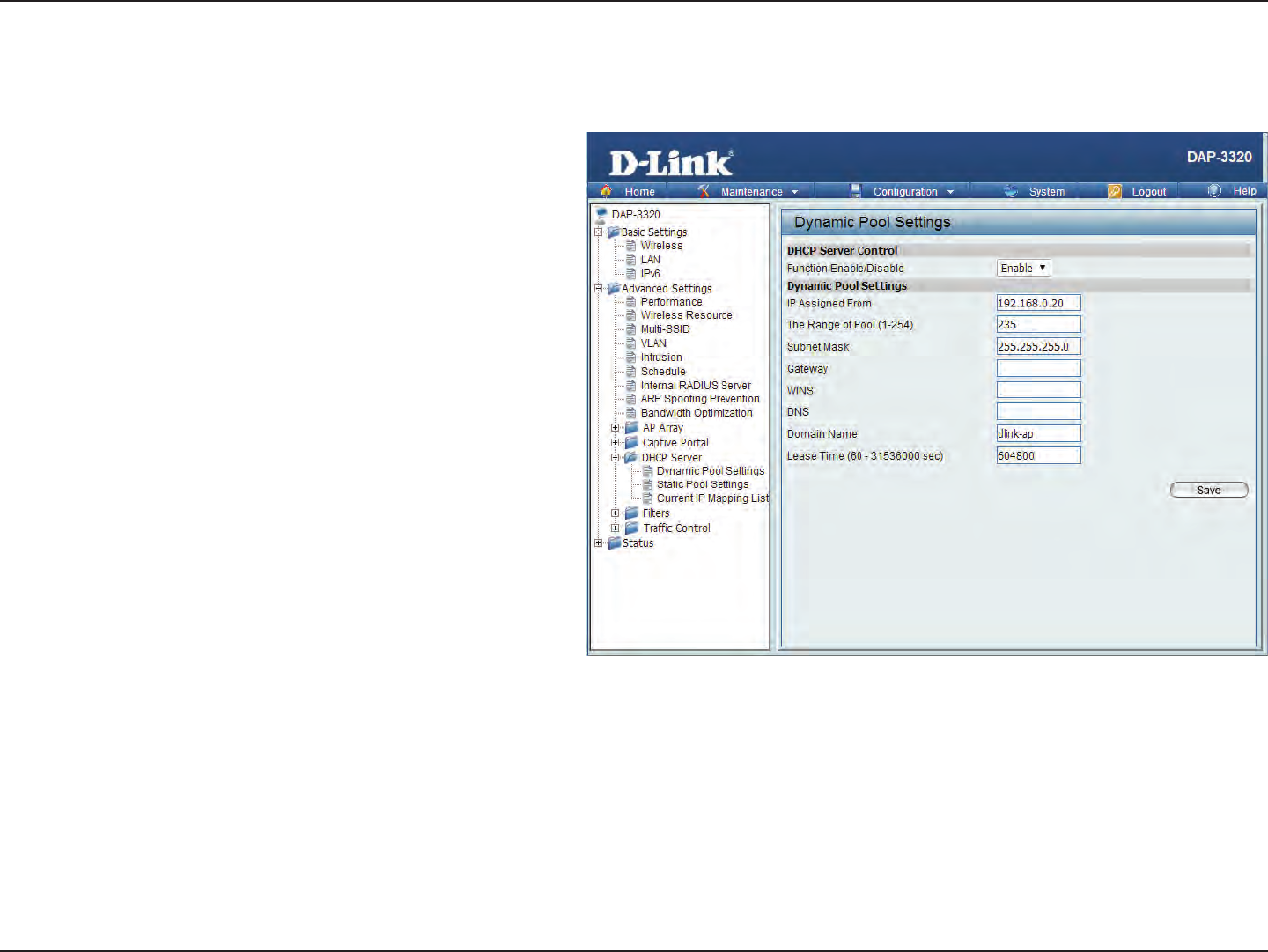
27D-Link DAP-3320 User Manual
Section 3 - Conguration
DHCP Server
Dynamic Pool Settings
The DHCP address pool denes the range of the
IP address that can be assigned to stations in the
network. A Dynamic Pool allows wireless stations
to receive an available IP with lease time control. If
needed or required in the network, the DAP-3320 is
capable of acting as a DHCP server.
Select Enable to allow the DAP-3320 to
function as a DHCP server.
Input the first IP address available for
assignment on your network.
Input the last IP address available for assignment
on your network.
All devices in the network must have the
same subnet mask to communicate. Enter the
submask for the network here.
Enter the IP address of the gateway on the
network.
Enter the IP address of the Domain Name
System (DNS) server. The DNS server translates
domain names such as www.dlink.com into
IP addresses.
Function
Enable/
Disable:
Start IP:
End IP:
Subnet Mask:
Gateway:
DNS IP:
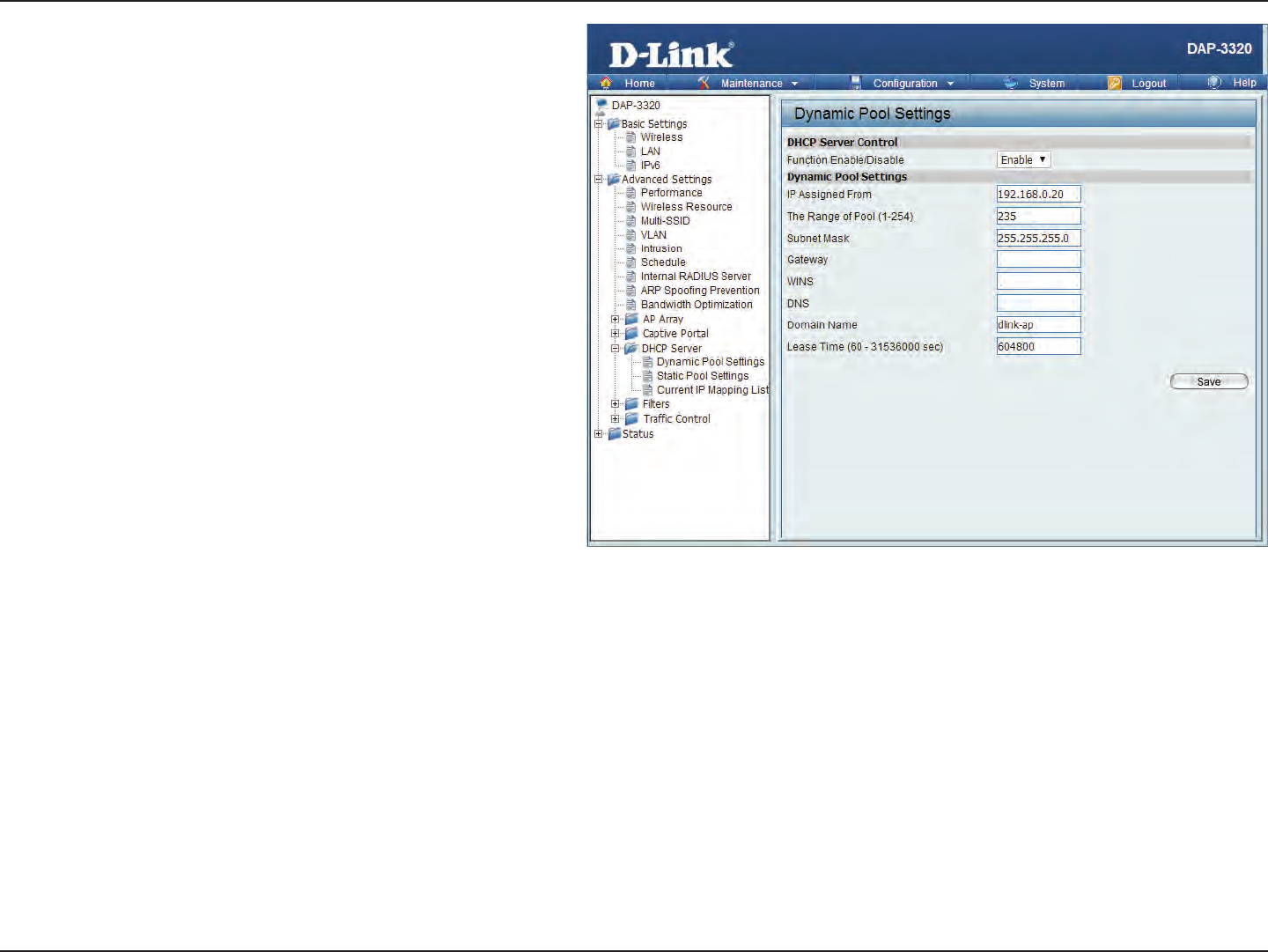
28D-Link DAP-3320 User Manual
Section 3 - Conguration
Specify the Windows Internet Naming Service
(WINS) server address for the wireless network.
WINS is a system that determines the IP address
of a network computer that has a dynamically
assigned IP address.
Enter the domain name of the network, if
applicable. (An example of a domain name is:
www.dlink.com.)
The lease time is the period of time before the
DHCP server will assign new IP addresses.
WINS:
Domain:
Least Time
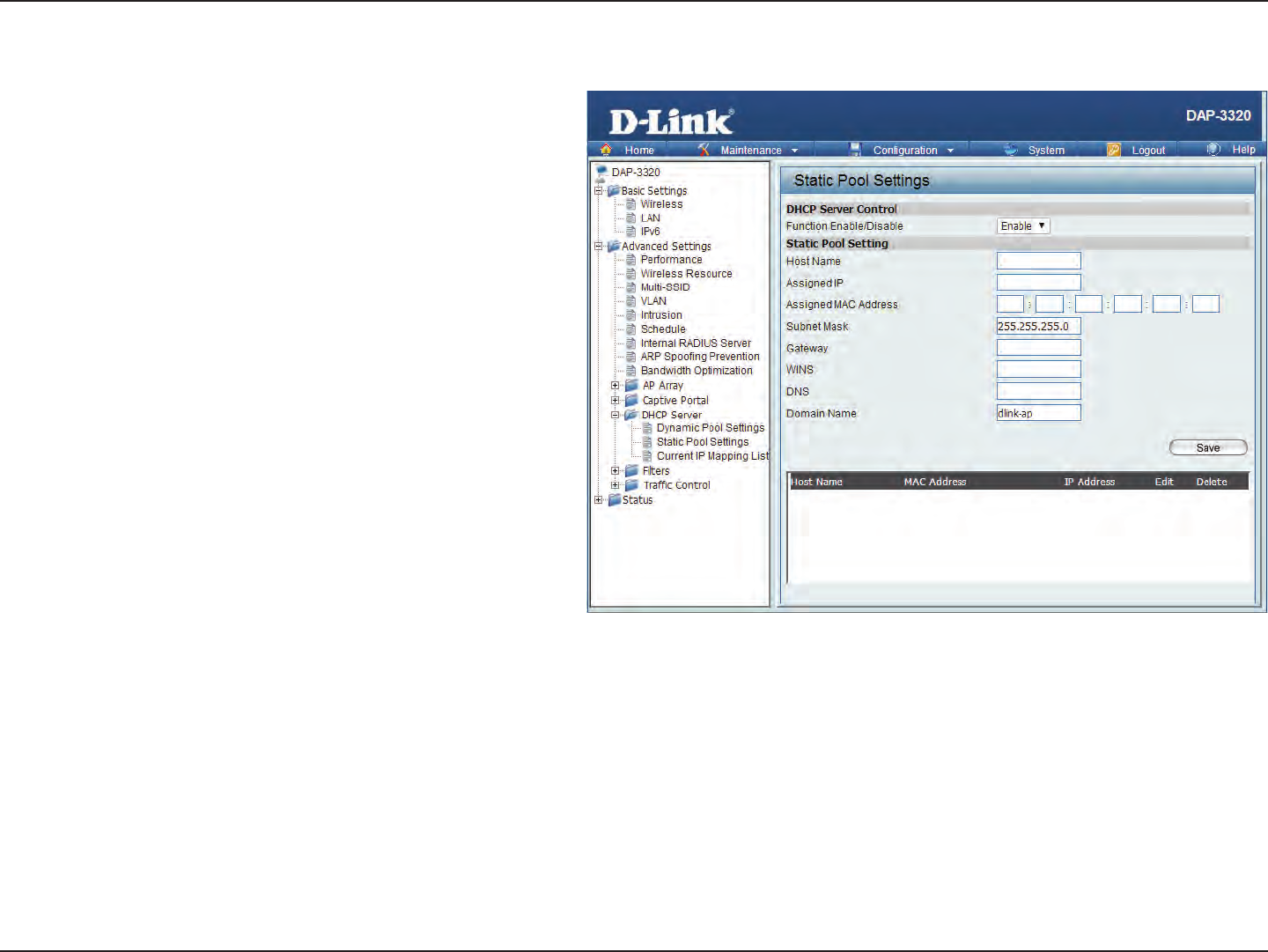
29D-Link DAP-3320 User Manual
Section 3 - Conguration
Static Pool Settings
The DHCP address pool denes the range of IP
addresses that can be assigned to stations on
the network. A static pool allows specic wireless
stations to receive a xed IP without time control.
Enter a name for the computer or device that
will be used to identify the IP address and
assigned MAC address.
Use the Static Pool Settings to assign the same
IP address to a device every time you start up.
The IP addresses assigned in the Static Pool
list must NOT be in the same IP range as the
Dynamic Pool.
Enter the MAC address of the device requesting
association here.
After you have assigned a static IP address to
a device via its MAC address, click Save; the
device will appear in the Assigned Static Pool
at the bottom of the screen. You can edit or
delete the device in this list.
Computer
Name:
Assigned IP:
Assigned MAC
Address:
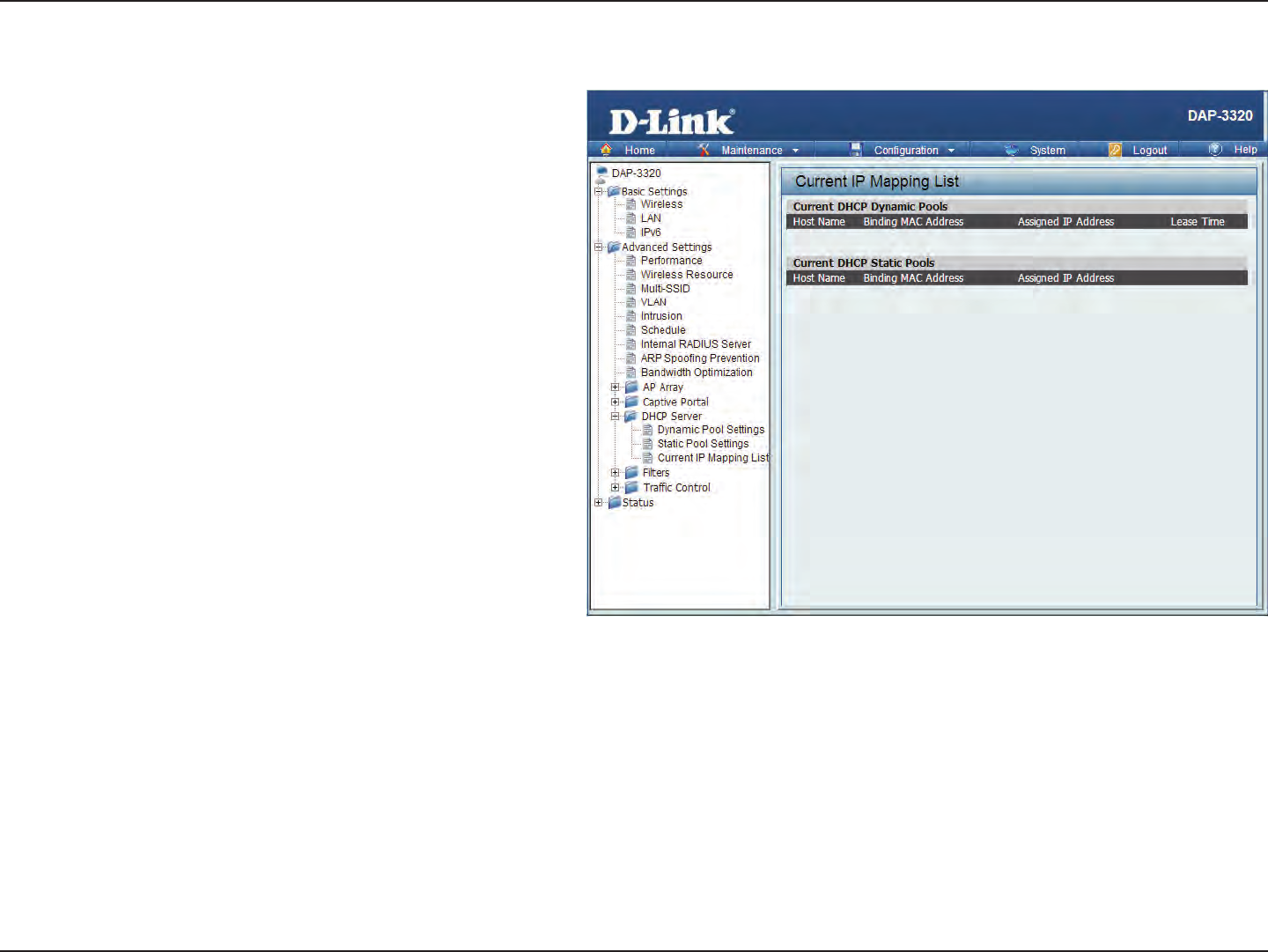
30D-Link DAP-3320 User Manual
Section 3 - Conguration
Current IP List
This window displays information about the current
assigned DHCP dynamic and static IP address pools.
This information is available when you enable DHCP
server on the AP and assign dynamic and static IP
address pools.
The current corresponding DHCP-assigned IP
address of the device.
The MAC address of a device on the network
that is assigned an IP address from the DHCP
dynamic pool.
The length of time until the dynamic IP address
will be invalid.
Assigned IP
Address:
Binding MAC
Address:
Expired In:
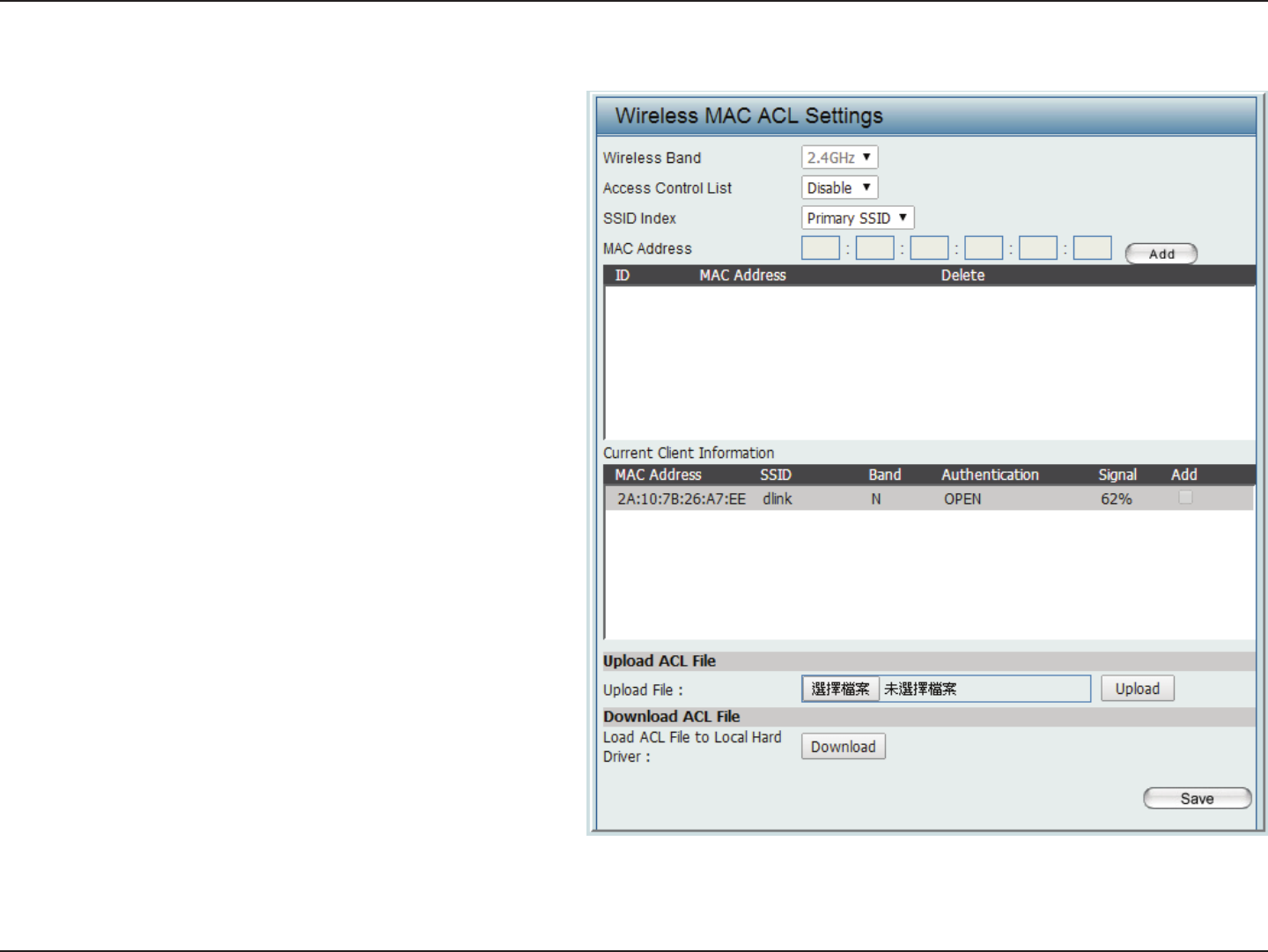
31D-Link DAP-3320 User Manual
Section 3 - Conguration
Filter
The Access Control lter section can be used to lter
network access by machines based on the unique MAC
addresses of their network adapter(s). It is most useful to
prevent unauthorized wireless devices from connecting
to your network. A MAC address is a unique ID assigned
by the manufacturer of the network adapter.
Access Control
List:
MAC Address:
When Disabled is selected, MAC addresses
are not used to control network access. When
Enabled is selected, only computers with MAC
addresses listed in the MAC Address List are
granted network access.
Click the Add button to add the new MAC
address to be ltered. Filtered MAC addresses
will be listed in the section below.
Current Client Information
This section shows currently connected clients,
and gives you the option to add them to the
MAC address access control list
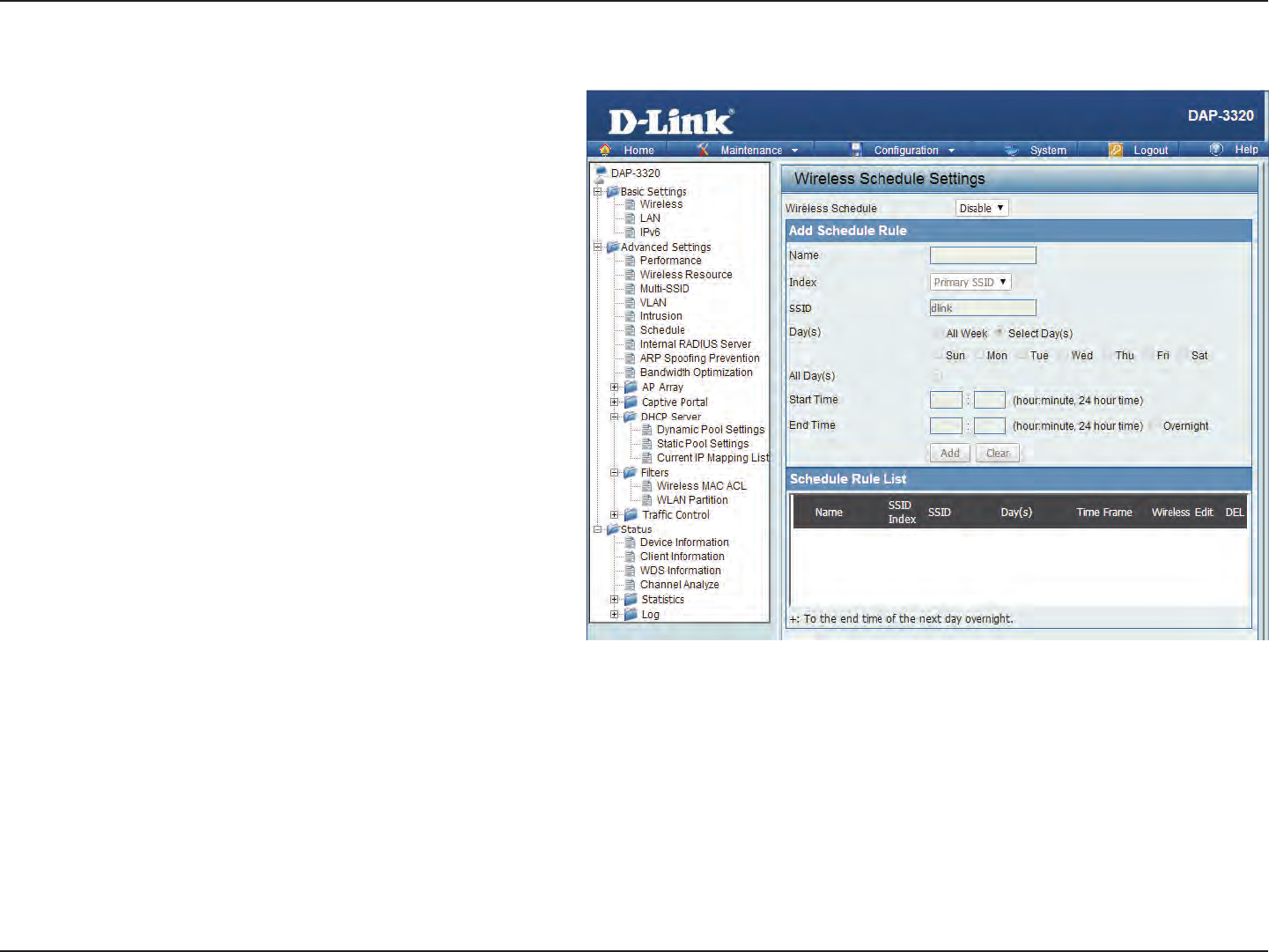
32D-Link DAP-3320 User Manual
Section 3 - Conguration
Schedule
Wireless
Schedule:
Wireless:
Wireless
Schedule List:
Enable or Disable wireless access based on
a predetermined schedule by selecting an
option from the drop down box.
Select whether the schedule will either turn
the wireless network on, or o. Once you have
determined the wireless state to be controlled
by scheduling, click Create New Rule to
continue.
The list of schedules will be listed below the
weekly graph. Click the Edit icon to make
changes or click the Delete icon to remove
the schedule.
This page will allow you to setup access schedules
for the device. This will enable or disable clients from
connecting to the device during specied times.
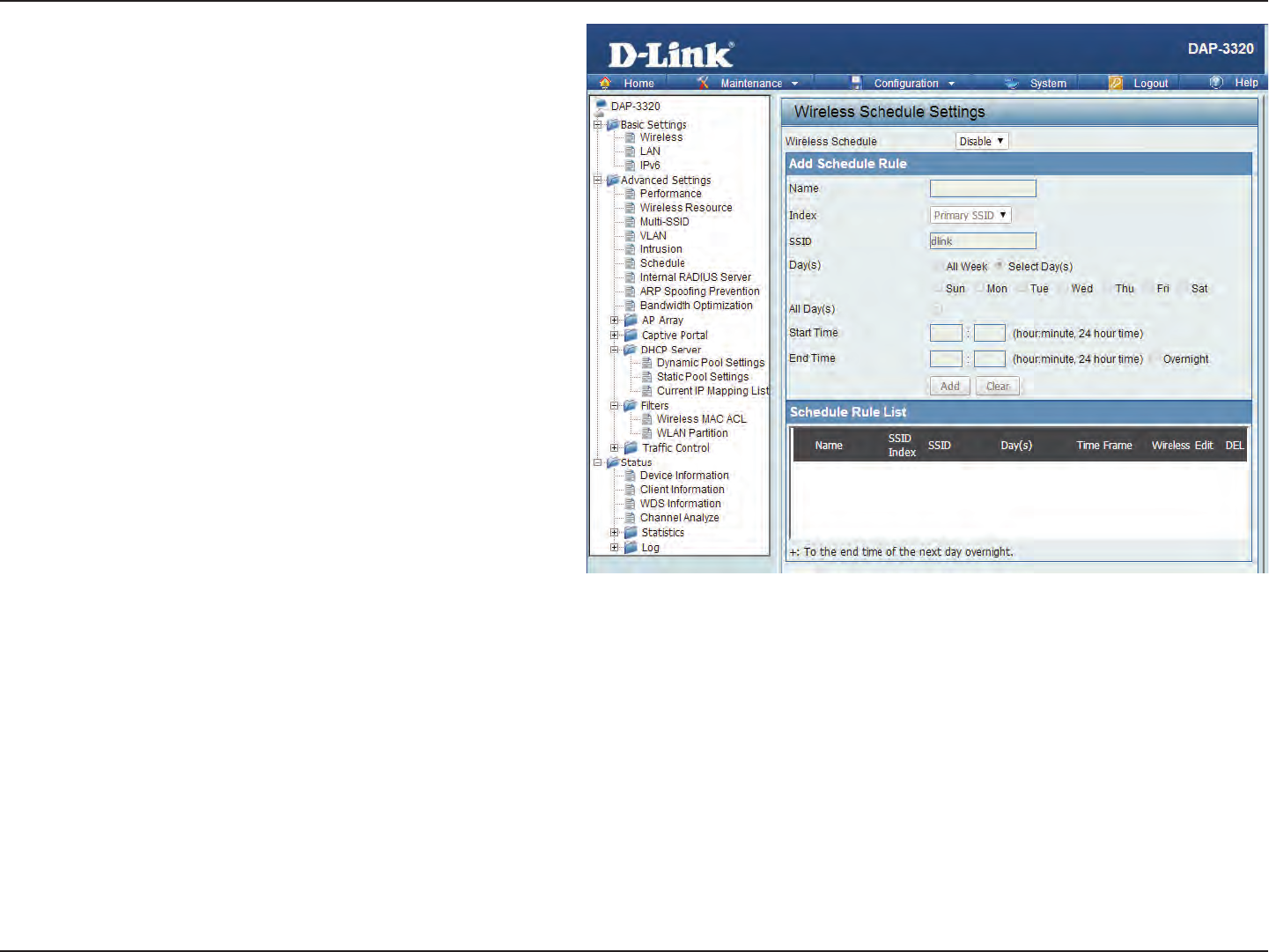
33D-Link DAP-3320 User Manual
Section 3 - Conguration
Name:
Day(s):
Day of Week:
All Day(s):
Start From:
End At:
Enter a name to identify the rule being created.
All Week, or choose Select Day(s) to specify
what days the rule should be active on.
Select the days that the rule will be active.
Select this checkbox if the rule should be active
all day for the days specied.
This should be set to the time when the rule
will become active.
This should be set to the time when the rule
will become inactive.
If you create a new rule or edit an existing one, you will see these
settings:
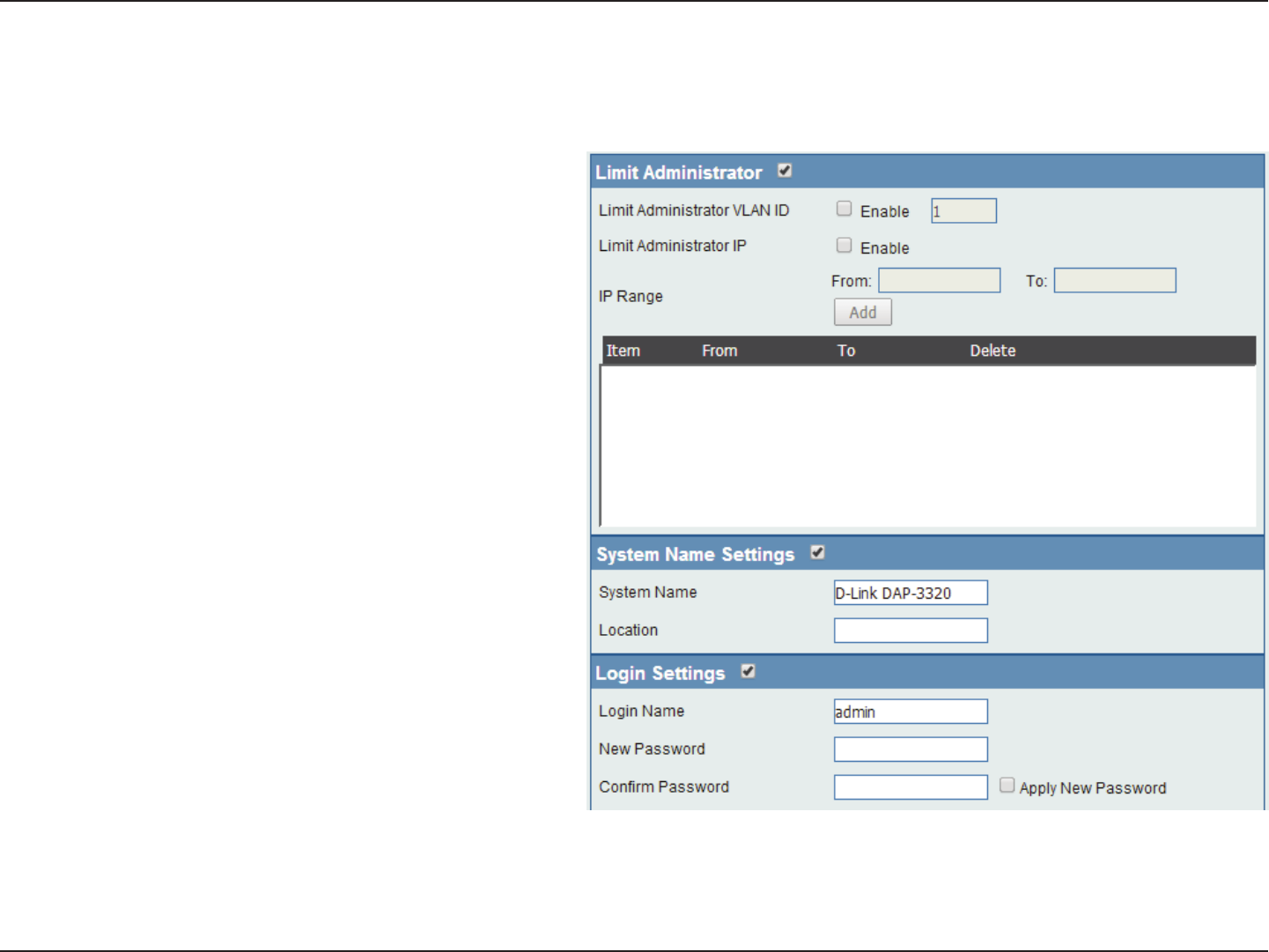
34D-Link DAP-3320 User Manual
Section 3 - Conguration
Limit
Administrator
IP:
IP Range:
System Name:
Description:
Location:
Login Name:
Old Password /
New Password:
Check this to limit administrator access to
specic IP ranges only.
Enter the IP address range that the administrator
will be allowed to log in from and then click the
Add button.
Enter a name for the device. The default name
is D-Link DAP-3310.
Enter a description for the device and its role.
Enter the physical location of the device, e.g.
72nd Floor, D-Link HQ.
Enter a user name. The default is admin.
You can change your password by entering
the old password, then entering the new
password and entering it again to conrm it.
The password is case-sensitive and should be
between 0 and 12 characters.
Maintenance
Administration Settings
This page will allow you to change a number of settings that are
used by the device administrator such as changing the password
used to access the device, as well as the method of accessing
the device remotely and from what IP address the device can be
remotely managed from.
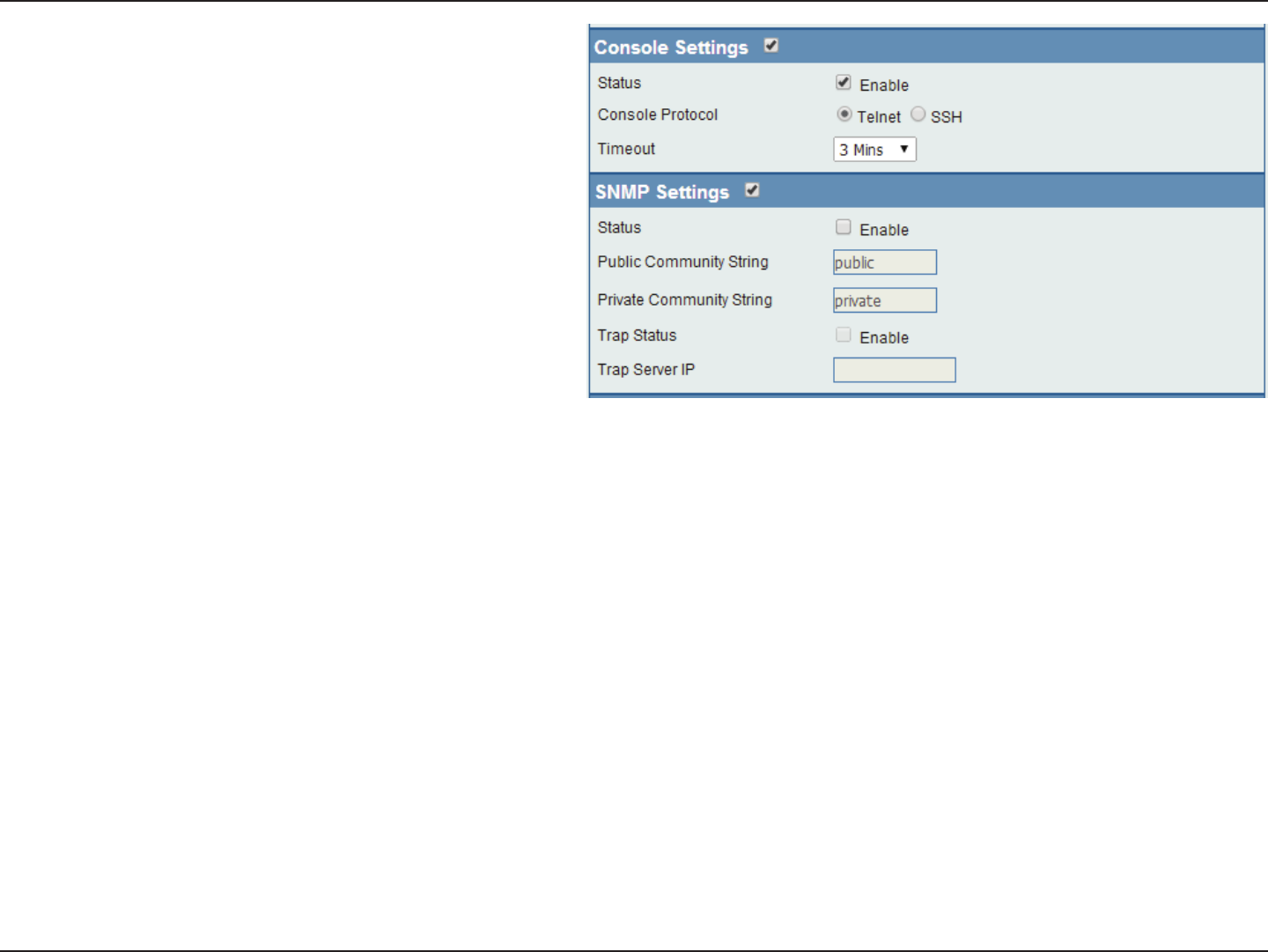
35D-Link DAP-3320 User Manual
Section 3 - Conguration
Select this checkbox to enable access to the
console via HTTP. The port which the console
will use for connections can also be specied.
Select this checkbox to enable access to the
console via HTTPS. The port which the console
will use for connections can also be specied.
Select this checkbox to enable access to the
console via Telnet. The port which the console
will use for connections can also be specied.
Select this checkbox to enable access to the
console via SSH. The port which the console
will use for connections can also be specied.
In order to use this feature, you will need to
click on the Generate Key button to create an
SSH key.
This will display the SSH key generated by the
AP.
Select this checkbox to enable UPnP support
for the management console on the AP.
Check the box to enable the SNMP v2c
functions. This option is disabled by default.
Enter the read only community string.
Enter the read & write community string.
Enable HTTP:
Enable HTTPS:
Enable Telnet:
Enable SSH:
Host Key
Footprint:
Enable UPnP:
SNMP v2c:
RO
Community:
RW
Community:
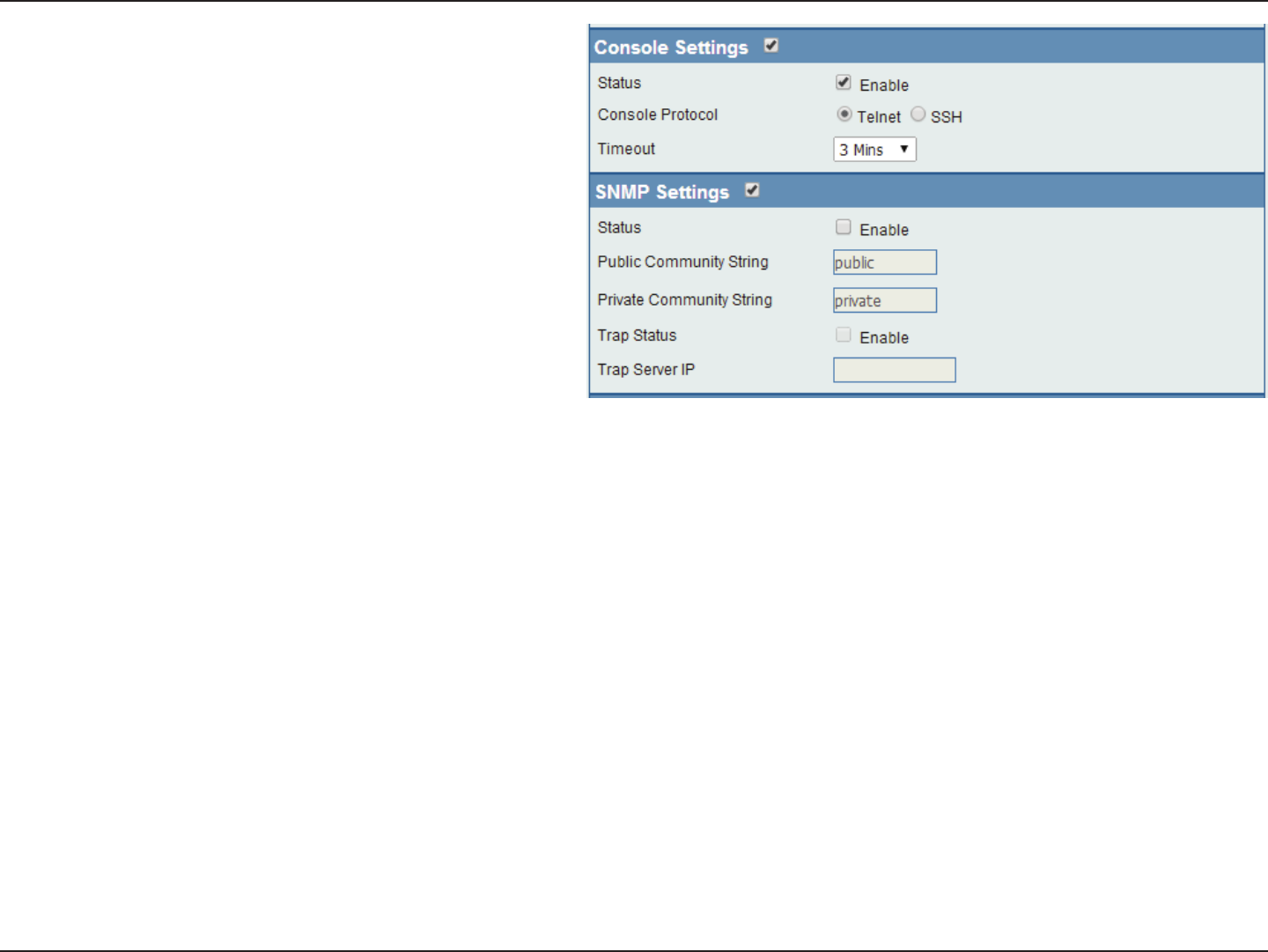
36D-Link DAP-3320 User Manual
Section 3 - Conguration
SNMP v3:
SNMP ro user:
SNMP ro
password:
SNMP rw user:
SNMP rw
password:
SNMP Trap:
Community:
IP 1 to 4:
Check the box to enable the SNMP v3 functions.
This option is disabled by default.
Enter the username for read only SNMP access.
Enter the password for read only SNMP access.
Enter the username for read/write SNMP
access.
Enter the password for read/write SNMP access.
Check the box to enable the sending of Trap
Status messages.
Set a community string required by the remote
host computer that will receive trap messages
or notices send by the system.
Enter the IP addresses of the remote hosts to
receive trap messages.
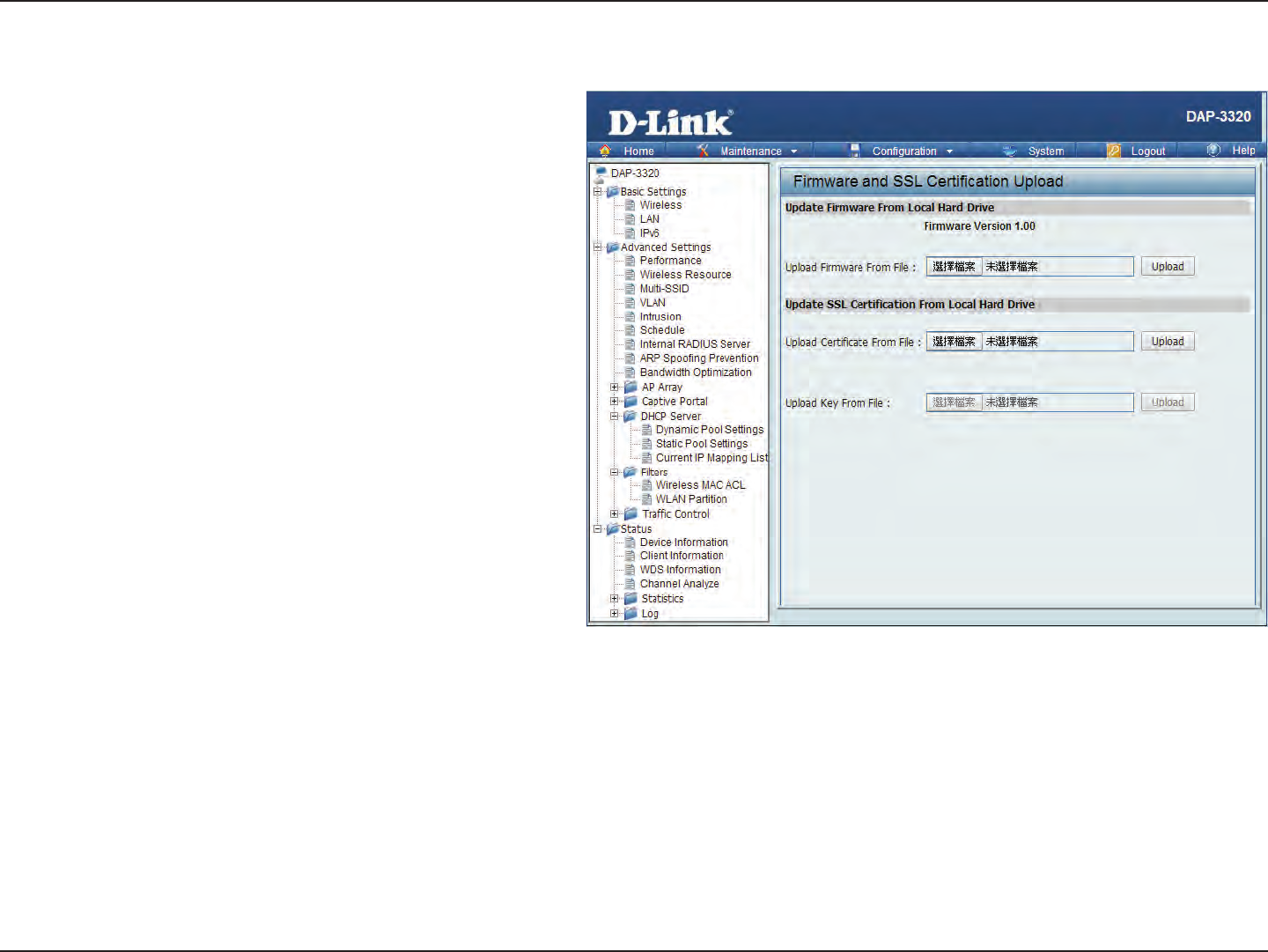
37D-Link DAP-3320 User Manual
Section 3 - Conguration
Firmware and SSL Certication Upload
Update Via
Local PC:
TFTP Server IP:
File Name:
Update Via
HTTP URL:
Upload
Certication
From File:
Click on Browse to locate the rmware le to
be used for the update. Click on Upgrade to
start the process of updating the rmware.
Enter the IP address of the TFTP server that will
be used to upgrade the AP.
Enter the lename of the rmware hosted on
the TFTP server. Click on Upgrade to start the
process of updating the rmware.
Enter the URL of the HTTP server that will be
used to upgrade the AP. This should be the
address of the server and the location of the
hosted rmware. Click on Upgrade to start the
process of updating the rmware.
Click on Browse to locate the certicate le to
be used. Click on Upload to start the process
of transferring the certicate to the AP.
This page allows you to upgrade the rmware of the
access point as well as upload an SSL certicate to
secure the connections made to the DAP-3320. Make
sure the rmware or SSL certicate you want to use is on
the local hard drive of the computer. Please check the
D-Link support website for rmware updates by visiting
http://support.dlink.com. The DAP-3320 includes a
number of ways to update the rmware such as a direct
connection over the LAN, via a TFTP server, or via HTTP.
SSL certicates must be updated via the LAN connection.
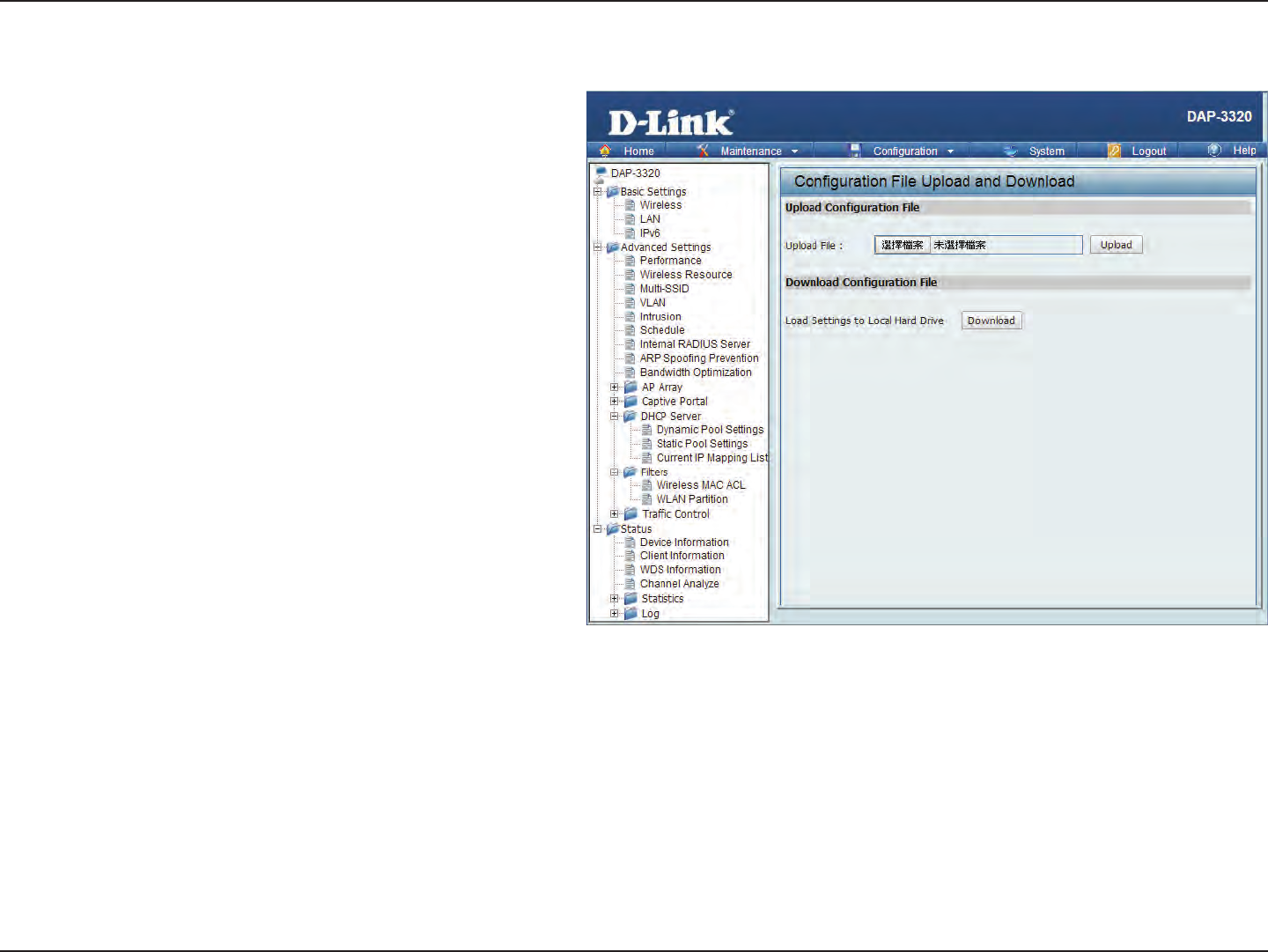
38D-Link DAP-3320 User Manual
Section 3 - Conguration
Conguration File
Upload File:
Load Setting
to Local Hard
Drive:
Use this option to load a previously saved
conguration. Click Browse to nd a previously
saved conguration le. Then, click the Upload
Settings button to transfer those settings to
the access point.
Use this option to save the current access point
configuration settings to a file on the hard
disk of the computer you are using. Click the
Download button. You will then see a le dialog
where you can select a location and le name
for the settings.
This page will allow you to upload or download a
conguration le for the DAP-3320.
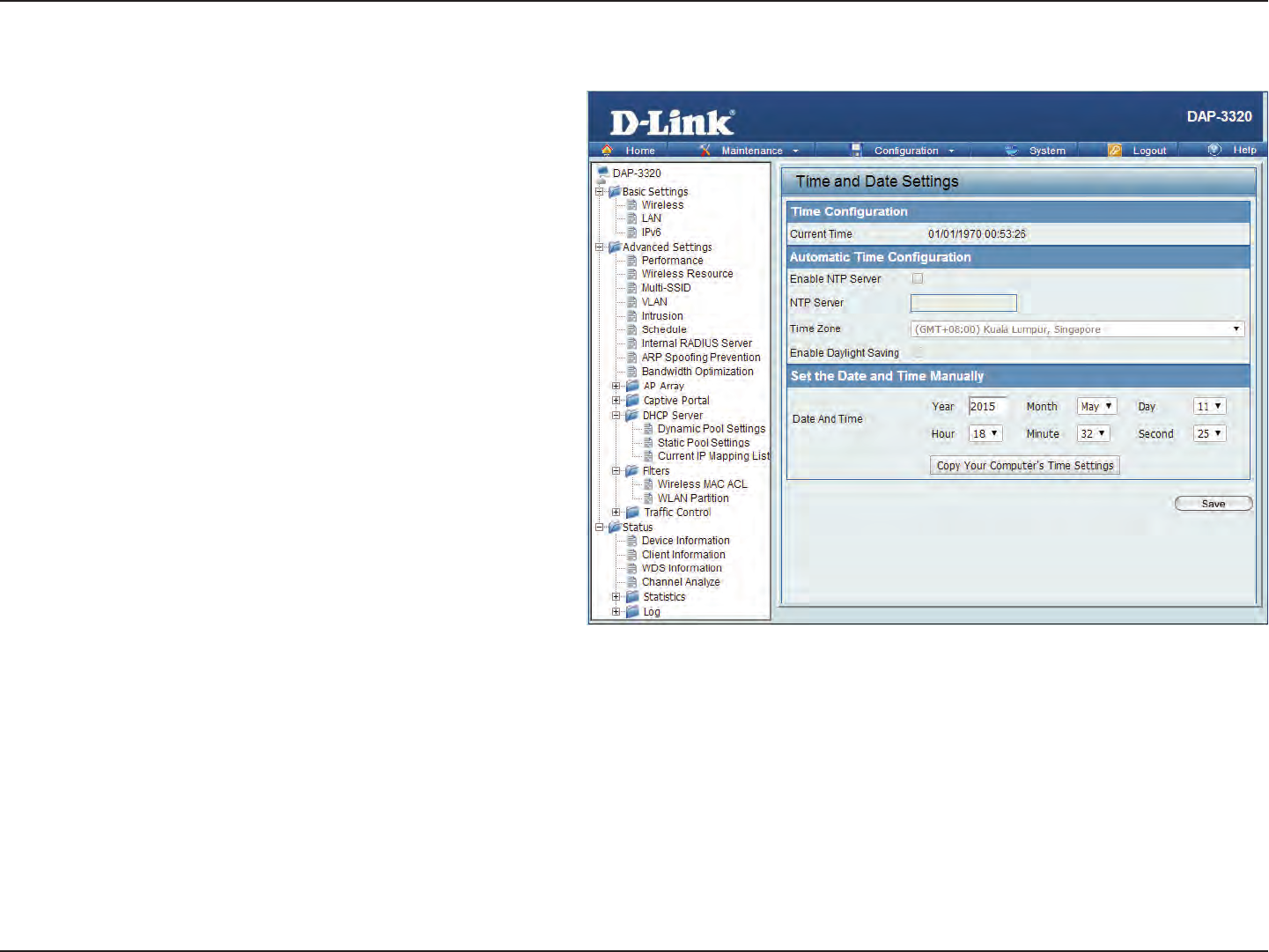
39D-Link DAP-3320 User Manual
Section 3 - Conguration
Time and Date
Enable NTP
Server:
NTP Server
Used:
Time Zone:
Daylight
Saving Time:
Date and Time:
NTP is short for Network Time Protocol.
This allows the system clock to be updated
automatically by using an NTP server.
Enter the NTP server or select one from the
drop-down menu.
Select the Time Zone from the drop-down
menu.
To set Daylight Saving time manually, click the
Daylight Saving Time check box. Next, use the
drop-down menu to select a Daylight Saving
Oset and then enter a start date and an end
date for daylight saving time.
To manually set the time, enter the Year, Month,
Day, Hour, Minute, and Second and then click
Save. To avoid having to manually set the time,
you can also click the Copy Your Computer’s
Time Settings button at the bottom of the
page to have the DAP-3320 automatically
set the time based on the system clock of
the computer being used to configure the
DAP-3320.
The Time Server Setup page allows you to congure,
update, and maintain the correct time on the internal
system clock. In this section you can set the time zone
that you are in. Daylight Saving can also be congured
to automatically adjust the time when needed.
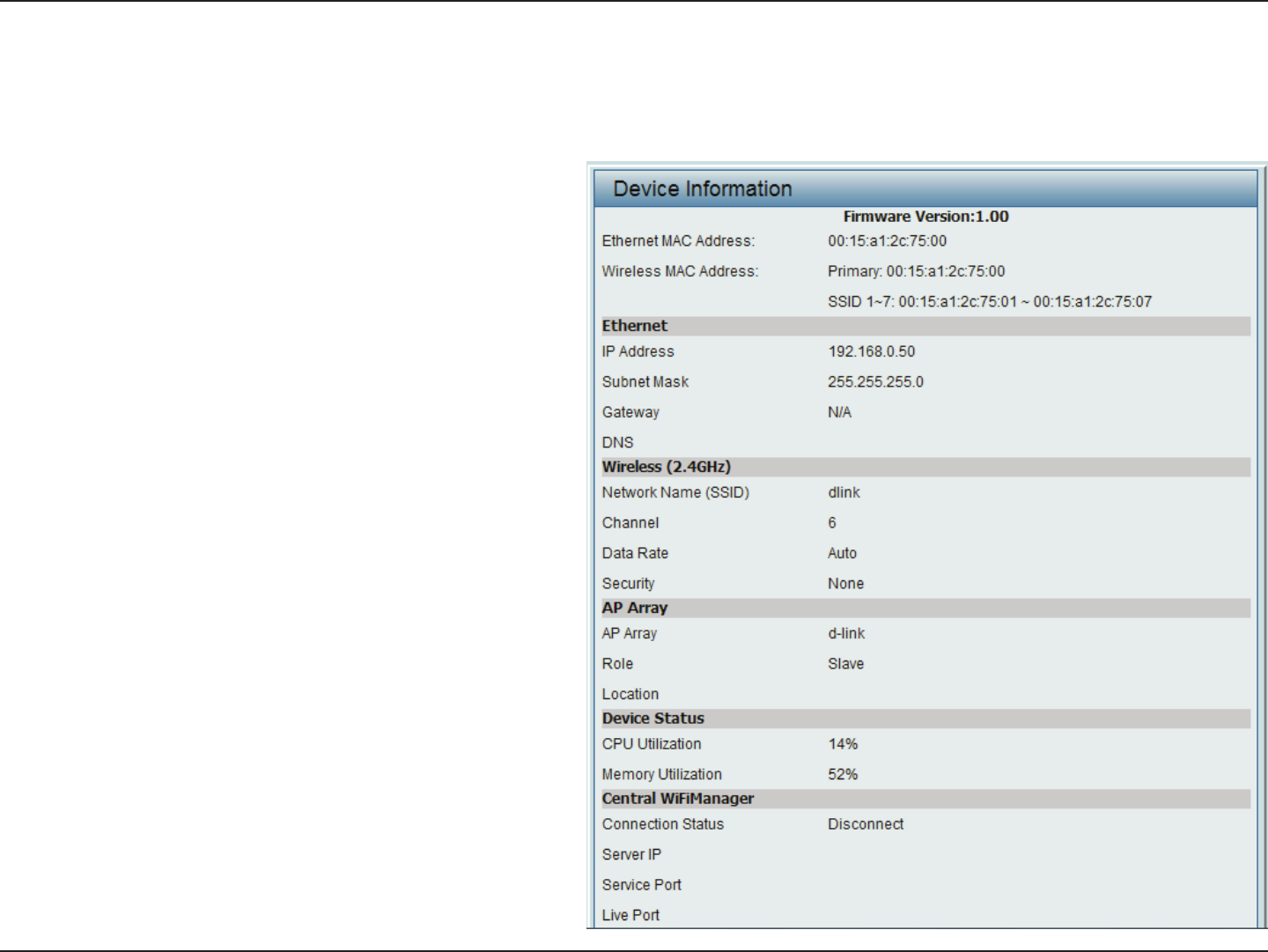
40D-Link DAP-3320 User Manual
Section 3 - Conguration
Status
Device Information
Firmware
Version:
Wireless:
Ethernet:
Device Status:
Displays the access point’s time and rmware
version. Also displays the current operating
mode and hardware address (MAC), which may
be needed by a network administrator.
Displays the wireless your wireless settings
such as SSID and Channel along with the
current power output of the antennae, data
throughput, and wireless security method.
Displays the private (local) IP settings for the
two built in LAN ports on the access point.
Displays current system utilization of the access
point.
This page displays the current LAN, wireless LAN and
important device information for the DAP-3320.
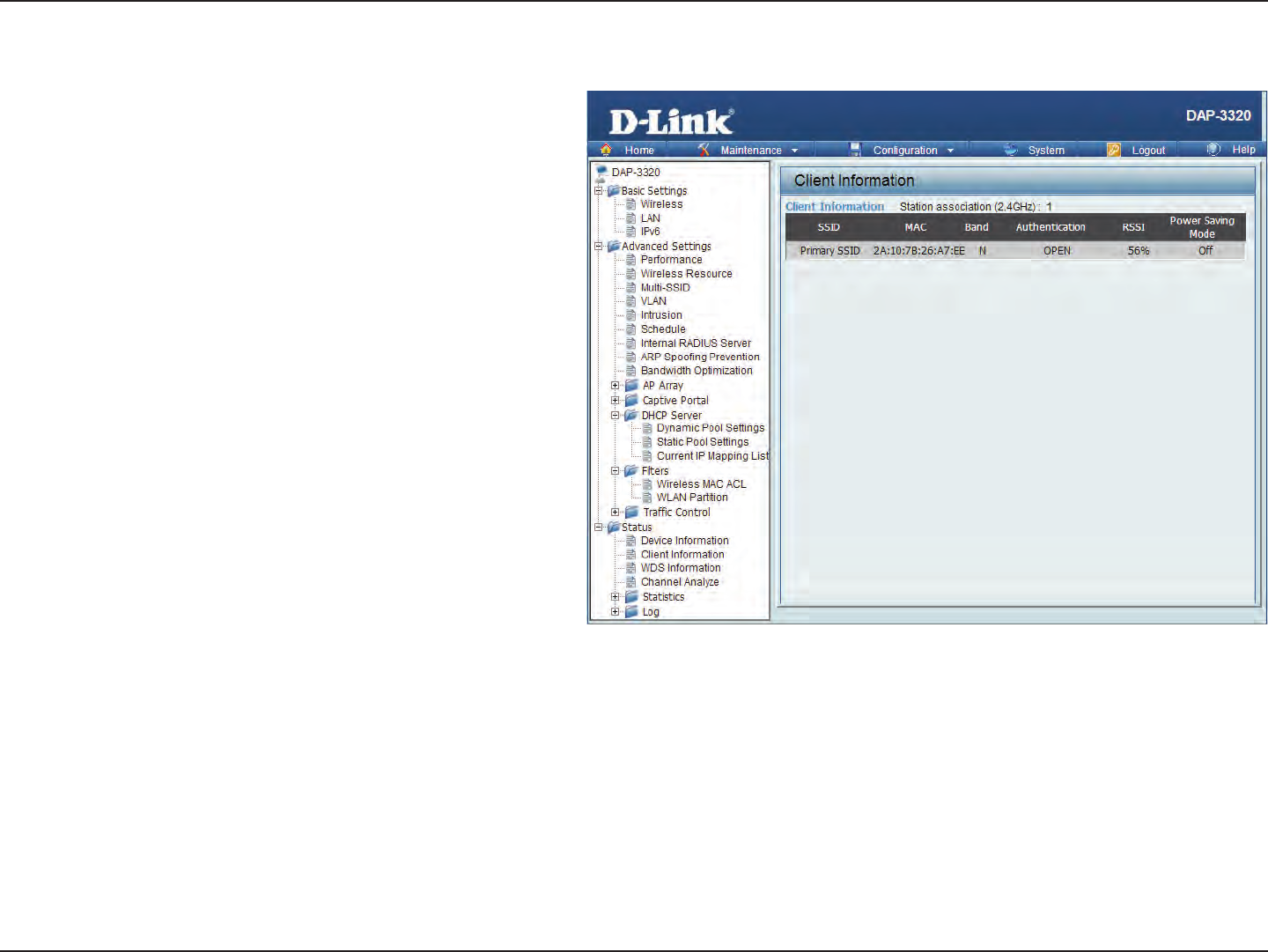
41D-Link DAP-3320 User Manual
Section 3 - Conguration
Client Information
MAC Address:
RSSI:
TX/RX Rate:
TX/RX SEQ:
TX/RX Bytes:
Connect Time:
Displays the MAC address of the client.
Displays the client’s signal strength (received
signal strength indicator).
Displays the current wireless speed that the
client is connected with.
This indicates the TX/RX sequence of the
respective WDS’s link
Displays the current amount of data that the
client has trasferred since it connected.
Displays the total amount of time that the client
has been connected.
This window displays the wireless client information for clients
currently connected to the DAP-3320.
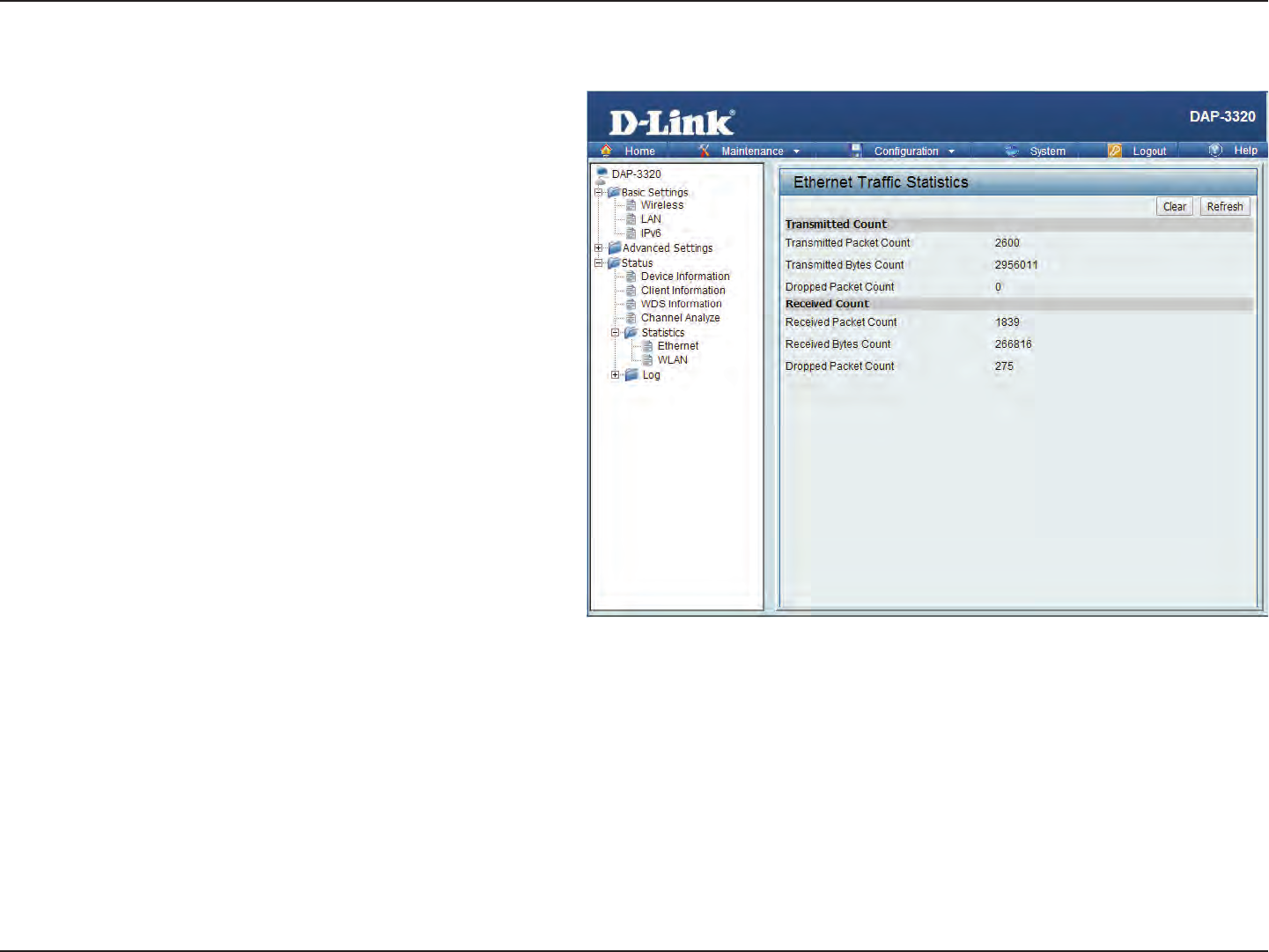
42D-Link DAP-3320 User Manual
Section 3 - Conguration
Ethernet Information
The DAP-3320 keeps statistics of the trac that passes
through it. You can view the amount of packets that
pass through the LAN and wireless portions of the
network. The trac counter will reset if the access point
is rebooted.
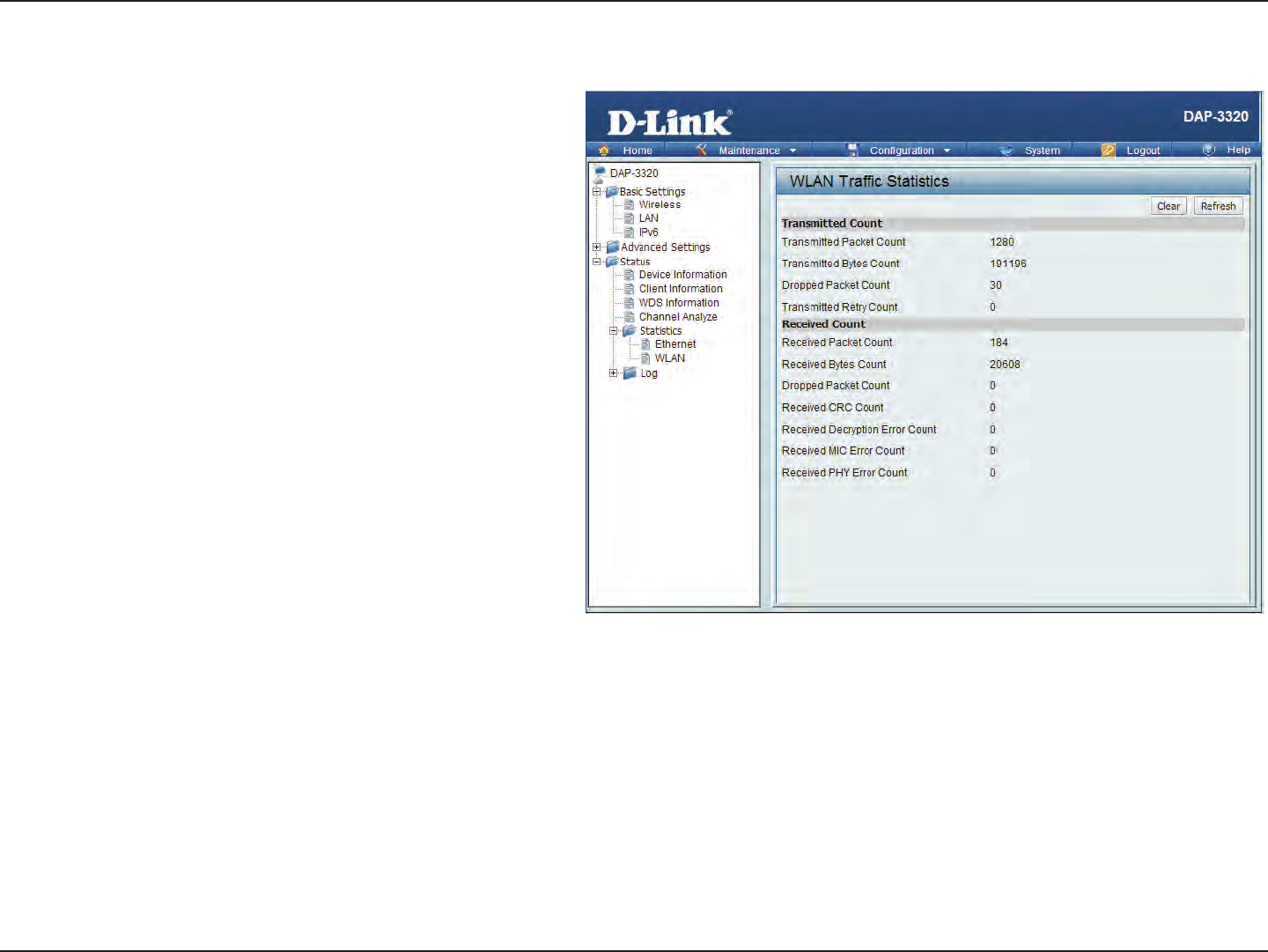
43D-Link DAP-3320 User Manual
Section 3 - Conguration
WLAN Information
This window displays wireless network statistics for data
throughput, transmitted and received frames, and frame
errors. The trac counter will reset if the access point
is rebooted.
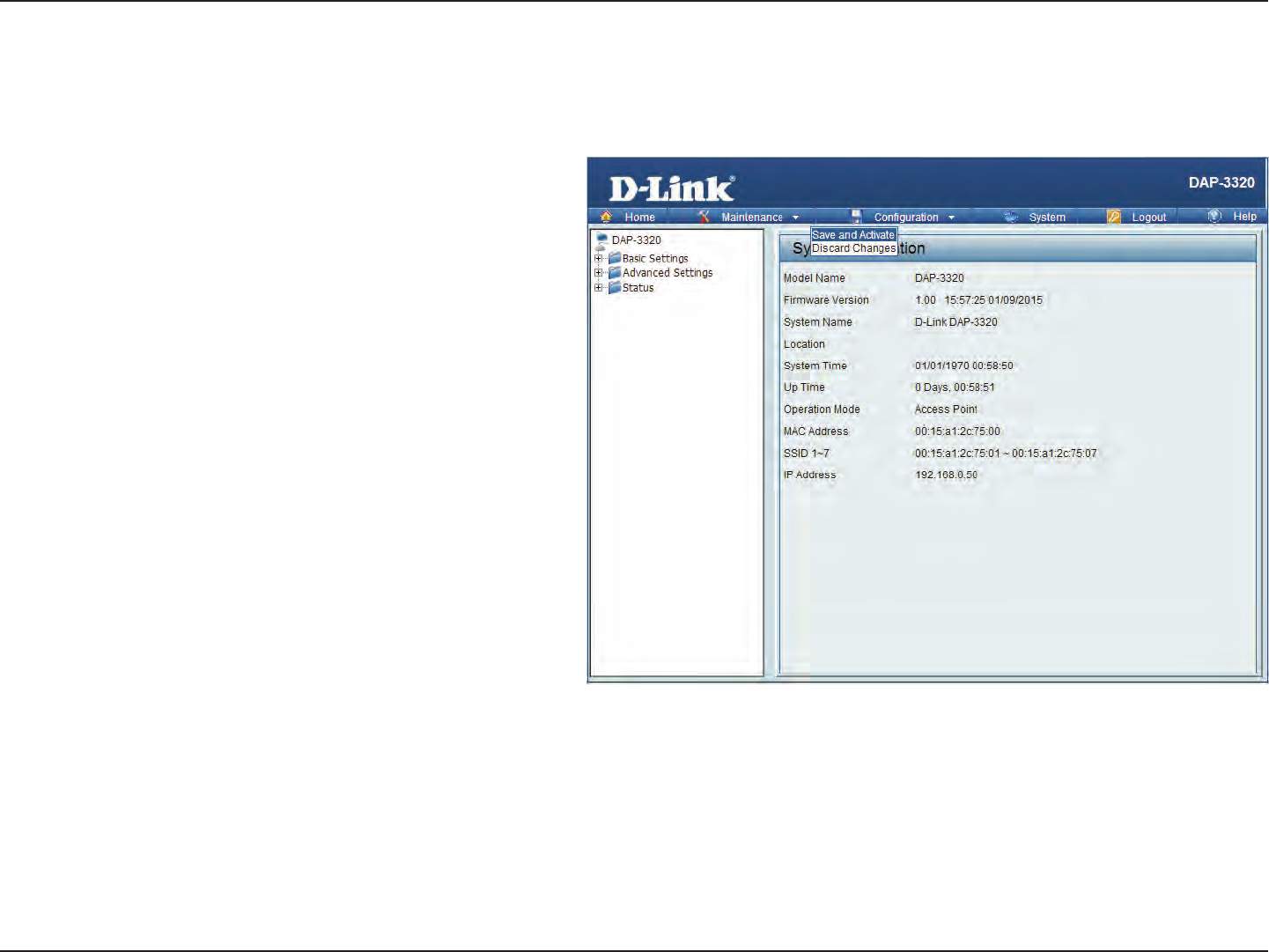
44D-Link DAP-3320 User Manual
Section 3 - Conguration
Conguration
Save and Active
When making changes on most of the conguration
screens it is best to use the Save button at the bottom
of each screen to save (not activate) your conguration
changes.
You may change settings to multiple pages before
activating. Once you are nished, click the Conguration
button located at the top of the page and then click Save
and Activate. You can then click Activate here to enable
your changes.
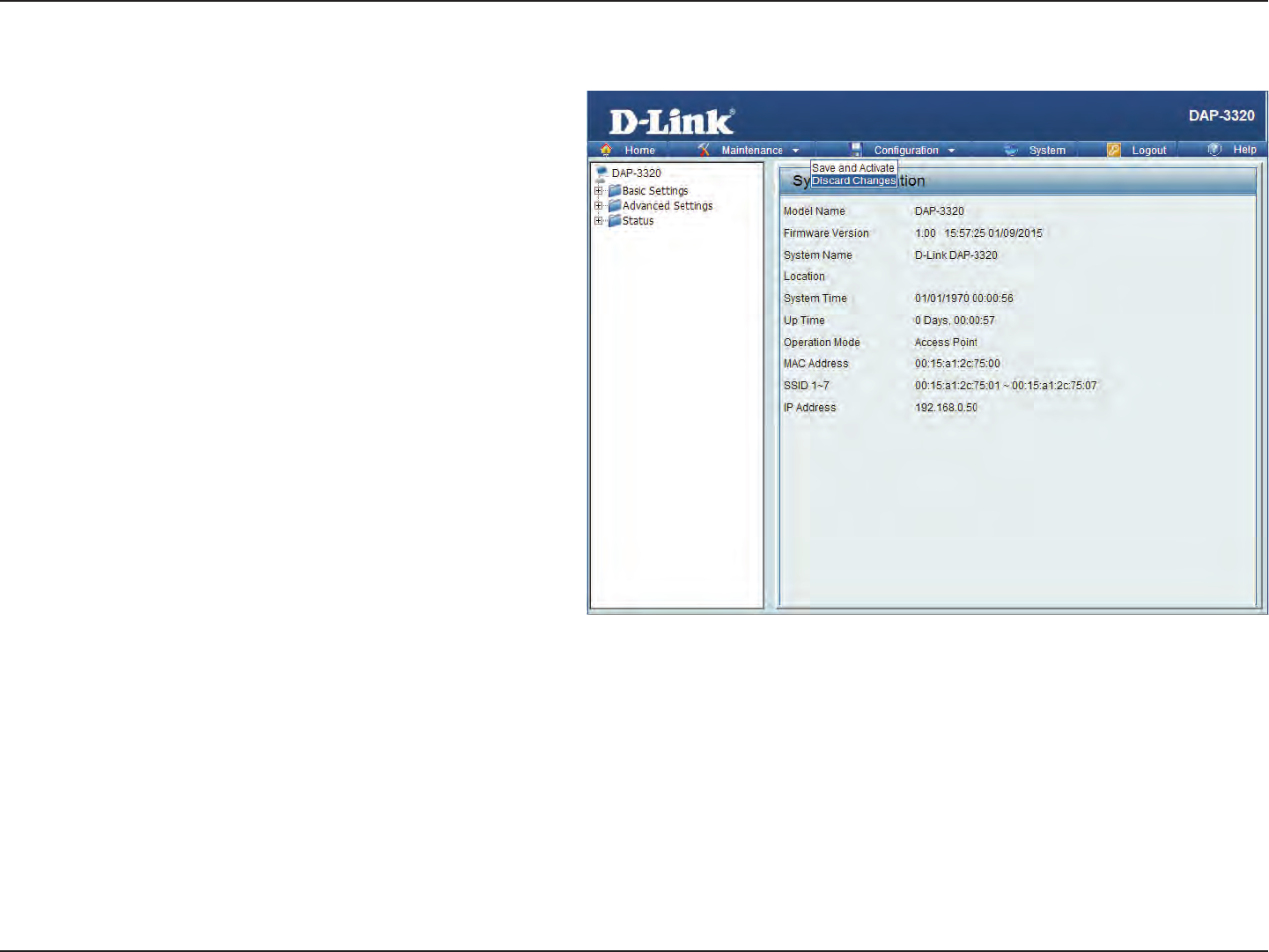
45D-Link DAP-3320 User Manual
Section 3 - Conguration
Discard Changes
When making changes on most of the conguration
screens it is best to use the Save button at the bottom
of each screen to save (not activate) your conguration
changes.
If you wish to discard all of the changes you have made,
and not yet activated, you may click the Discard button.
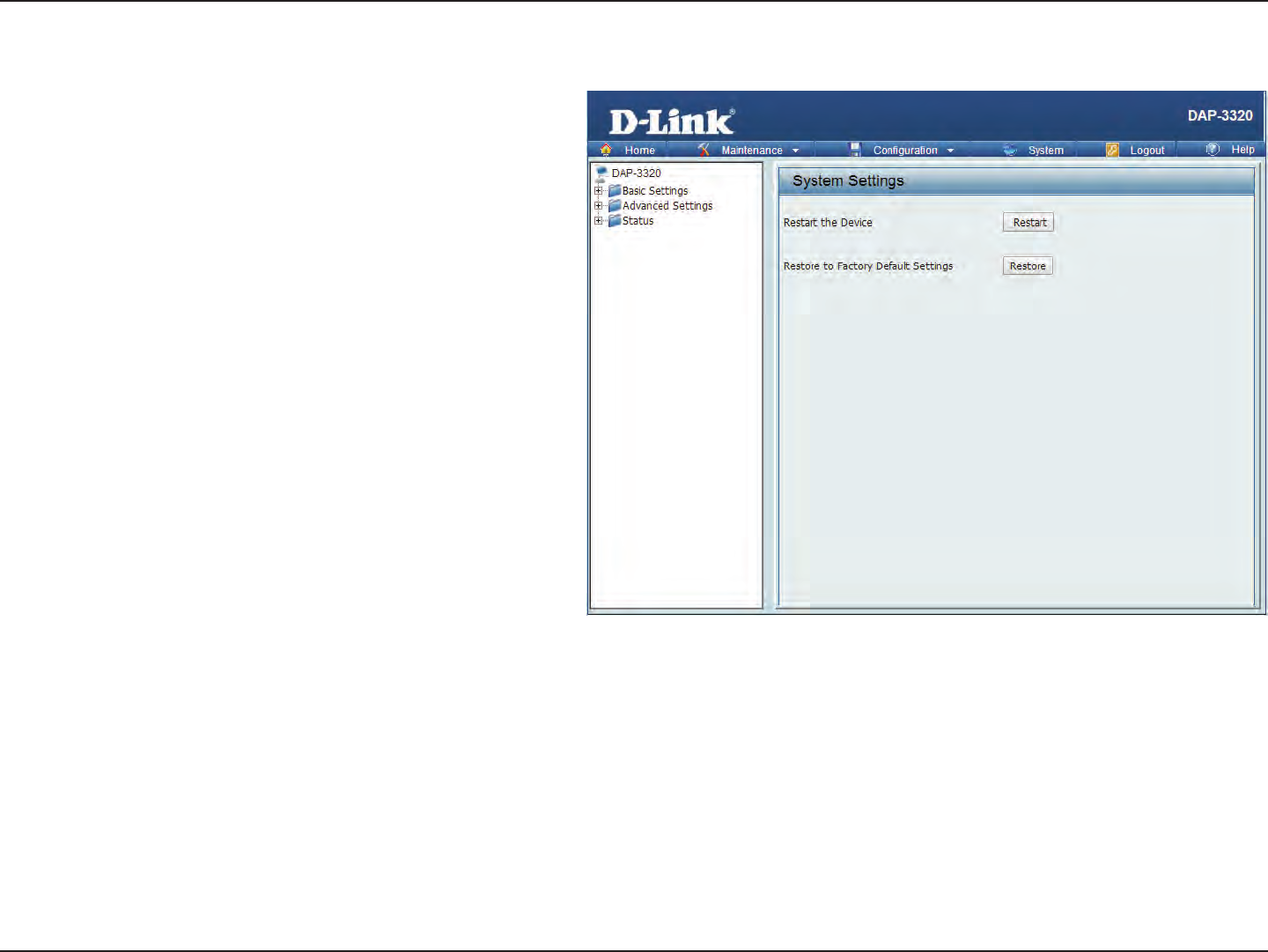
46D-Link DAP-3320 User Manual
Section 3 - Conguration
System
This page will allow you to restart the AP, or restore its
settings to the factory defaults.
Click the Restart button to reboot the device.
Click the Restore button to reset all settings back to
the factory defaults. Please note that this will erase all
settings and changes made to the device’s conguration.
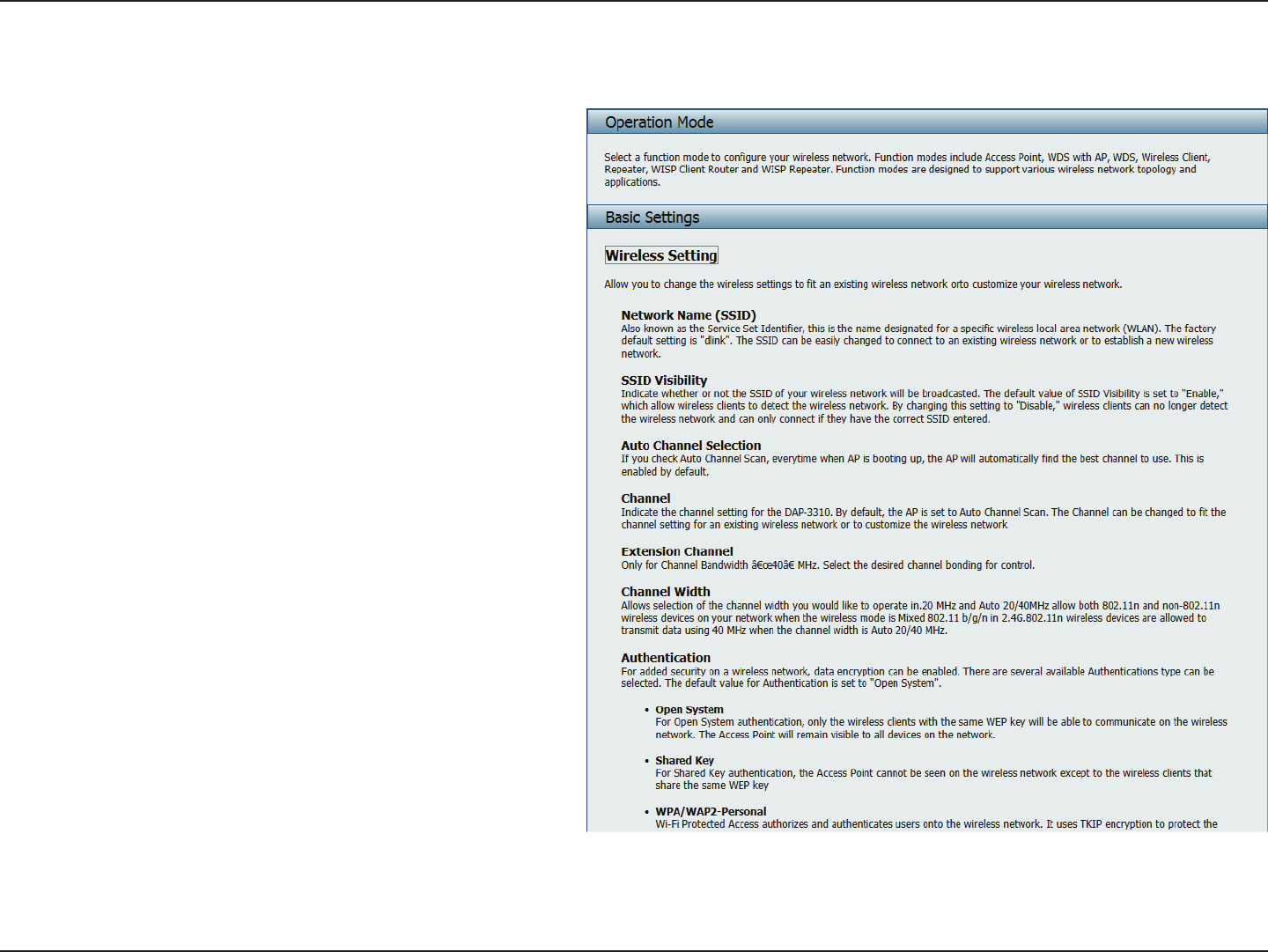
47D-Link DAP-3320 User Manual
Section 3 - Conguration
Help
Further information and in depth help can be found
anytime from the AP’s online help function. Scroll down
the Help page for topics and explanations.

48D-Link DAP-3320 User Manual
Section 4 - Security
Wireless Security
This section will show you the dierent levels of security you can use to protect your data from intruders. The DAP-3320 oers
the following types of security:
• WEP (Wired Equivalent Privacy)
• WPA-Personal (Wi-Fi Protected Access)
• WPA-Enterprise (Wi-Fi Protected Access)

49D-Link DAP-3320 User Manual
Section 4 - Security
What is WEP?
WEP, or Wired Equivalent Privacy, is a Wi-Fi security protocol that encrypts transmitted data. WEP is an older protocol that is
not believed to be as eective anymore.
WEP uses a passphrase or key to authenticate your wireless connection. For 64-Bit WEP, the key is an alpha-numeric password
that is 10 hex digits or an ASCII password consisting of 5 text characters. The hex digits are either numbers from 0 to 9 or
letters from A to F. For 128-Bit WEP, the key is an alpha-numeric password that is 26 hex digits or an ASCII password with 13
text characters.

50D-Link DAP-3320 User Manual
Section 4 - Security
Congure WEP
It is recommended to enable encryption on your wireless access point before your wireless network adapters. Please establish
wireless connectivity before enabling encryption. Your wireless signal may degrade when enabling encryption due to the
added overhead.
1. Log into the web-based conguration by opening a web browser and entering the IP address of the access point (dlinkap.
local). Click on Setup and then click Wireless Setup on the left side.
2. Next to Security Mode, select WEP.
Note: Choosing WEP means the device will only operate in Legacy wireless mode (802.11B/G) and will not provide 802.11N
performance.
3. Next to WEP Encryption, select 64Bit(10 hex digits), 64Bit(5 ASCII characters), 128Bit(26 hex digits) or 128Bit(13 ASCII
characters).
4. Next to WEP Key 1, enter a set of digits or letters from A to F, or a string of text.
5. Next to Authentication, select Both or Shared Key.
6. Click Save Settings at the top of the window to save your settings. If you are conguring the access point with a wireless
adapter, you will lose connectivity until you enable WPA-PSK on your adapter and enter the same passphrase as you did on
the access point.

51D-Link DAP-3320 User Manual
Section 4 - Security
What is WPA?
WPA, or Wi-Fi Protected Access, is a Wi-Fi standard that was designed to improve the security features of WEP (Wired Equivalent
Privacy).
The 2 major improvements over WEP:
• Improved data encryption through the Temporal Key Integrity Protocol (TKIP). TKIP scrambles the keys using a
hashing algorithm and, by adding an integrity-checking feature, ensures that the keys haven’t been tampered
with. WPA2 is based on 802.11i and uses Advanced Encryption Standard (AES) instead of TKIP.
• User authentication, which is generally missing in WEP, through the extensible authentication protocol (EAP).
WEP regulates access to a wireless network based on a computer’s hardware-specic MAC address, which is
relatively simple to be snied out and stolen. EAP is built on a more secure public-key encryption system to
ensure that only authorized network users can access the network.
WPA-PSK/WPA2-PSK uses a passphrase or key to authenticate your wireless connection. The key is an alpha-numeric password
between 8 and 63 characters long. The password can include symbols (!?*&_) and spaces. This key must be the exact same key
entered on your wireless bridge or access point.
WPA/WPA2 incorporates user authentication through the Extensible Authentication Protocol (EAP). EAP is built on a more
secure public key encryption system to ensure that only authorized network users can access the network.

52D-Link DAP-3320 User Manual
Section 4 - Security
Congure WPA/WPA2 Personal
It is recommended to enable encryption on your wireless access point before your wireless network adapters. Please establish
wireless connectivity before enabling encryption. Your wireless signal may degrade when enabling encryption due to the
added overhead.
1. Log into the web-based conguration by opening a web browser and entering the IP address of the access point (dlinkap.
local). Click on Setup and then click Wireless Setup on the left side.
2. Next to Security Mode, select WPA-Personal.
3. Next to WPA Mode, select Auto(WPA or WPA2), WPA2 only, or WPA only.
4. Next to Cipher Type, select TKIP, AES, or TKIP and AES.
5. Next to Pre-Shared Key, enter a key. The key is entered as a passphrase in ASCII format at both ends of the wireless connection.
The passphrase must be between 8-63 characters.
6. Click Save Settings at the top of the window to save your settings. If you are conguring the access point with a wireless
adapter, you will lose connectivity until you enable WPA-PSK on your adapter and enter the same passphrase as you did on
the access point.

53D-Link DAP-3320 User Manual
Section 4 - Security
It is recommended to enable encryption on your wireless access point before your wireless network adapters. Please establish
wireless connectivity before enabling encryption. Your wireless signal may degrade when enabling encryption due to the
added overhead.
1. Log into the web-based conguration by opening a web browser and entering the IP address of the access point (dlinkap.
local). Click on Setup and then click Wireless Setup on the left side.
2. Next to Security Mode, select WPA-Enterprise.
3. Next to WPA Mode, select Auto(WPA or WPA2), WPA2 only, or WPA only.
4. Next to Cipher Mode, select TKIP, AES, or Auto.
5. Next to RADIUS Server IP Address, enter the IP Address of your RADIUS server.
6. Next to RADIUS Server Port, enter the port you are using with your RADIUS server. 1812 is the default port.
7. Next to RADIUS Server Shared Secret, enter the security key.
8. Click Advanced to enter settings for a secondary RADIUS Server.
9. Click Save Settings to save your settings.
Congure WPA/WPA2 Enterprise
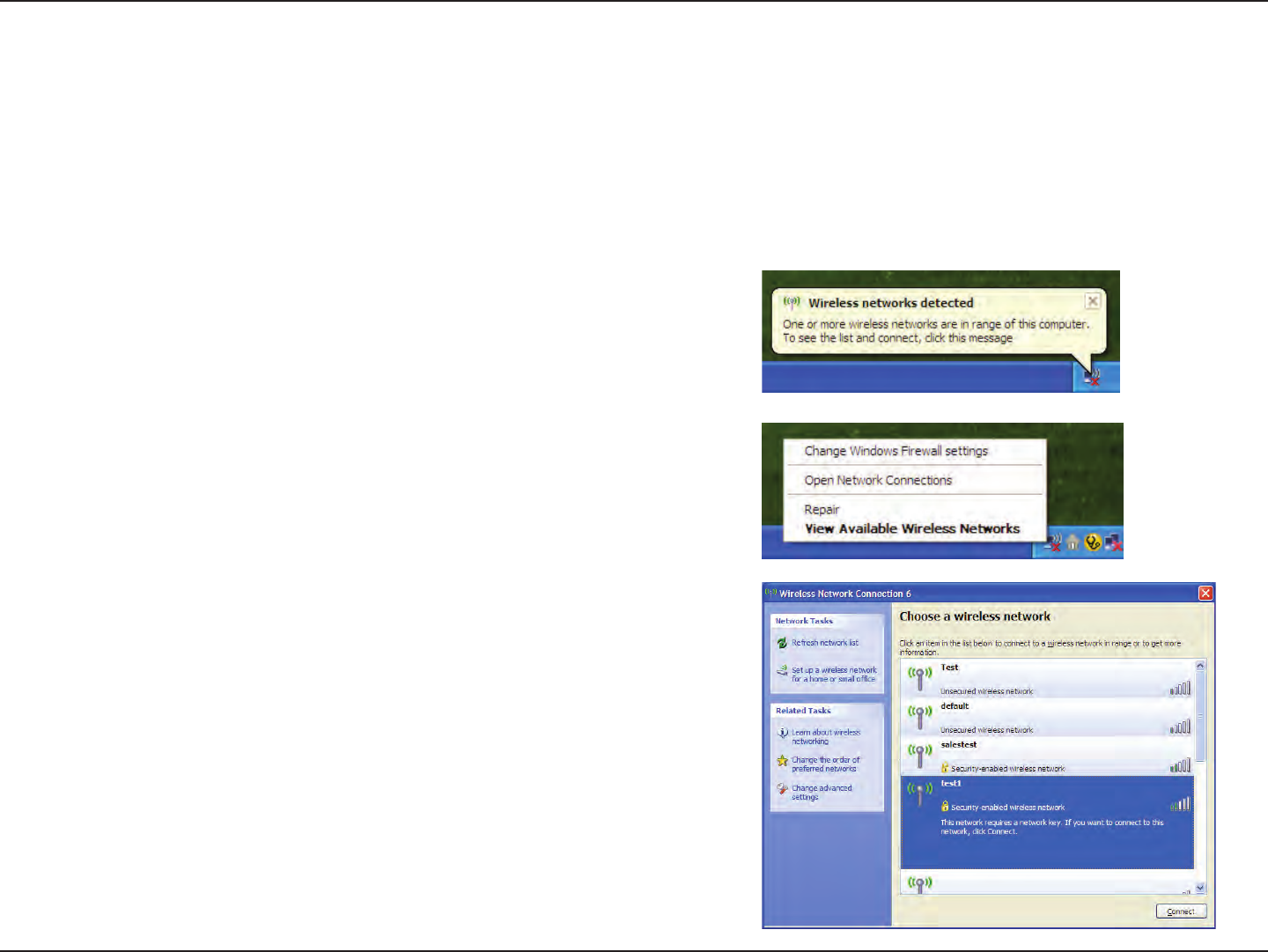
54D-Link DAP-3320 User Manual
Section 5 - Connecting to a Wireless Network
Connect to a Wireless Network
Using Windows® XP
Windows® XP users may use the built-in wireless utility (Zero Conguration Utility). The following instructions are for Service
Pack 2 users. If you are using another company’s utility or Windows® 2000, please refer to the user manual of your wireless
adapter for help with connecting to a wireless network. Most utilities will have a “site survey” option similar to the Windows®
XP utility as seen below.
Right-click on the wireless computer icon in your system tray
(lower-right corner next to the time). Select View Available
Wireless Networks.
If you receive the Wireless Networks Detected bubble, click on
the center of the bubble to access the utility.
or
The utility will display any available wireless networks in your area.
Click on a network (displayed using the SSID) and click the Connect
button.
If you get a good signal, but cannot access the Internet, check you
TCP/IP settings for your wireless adapter. Refer to the Networking
Basics section in this manual for more information.
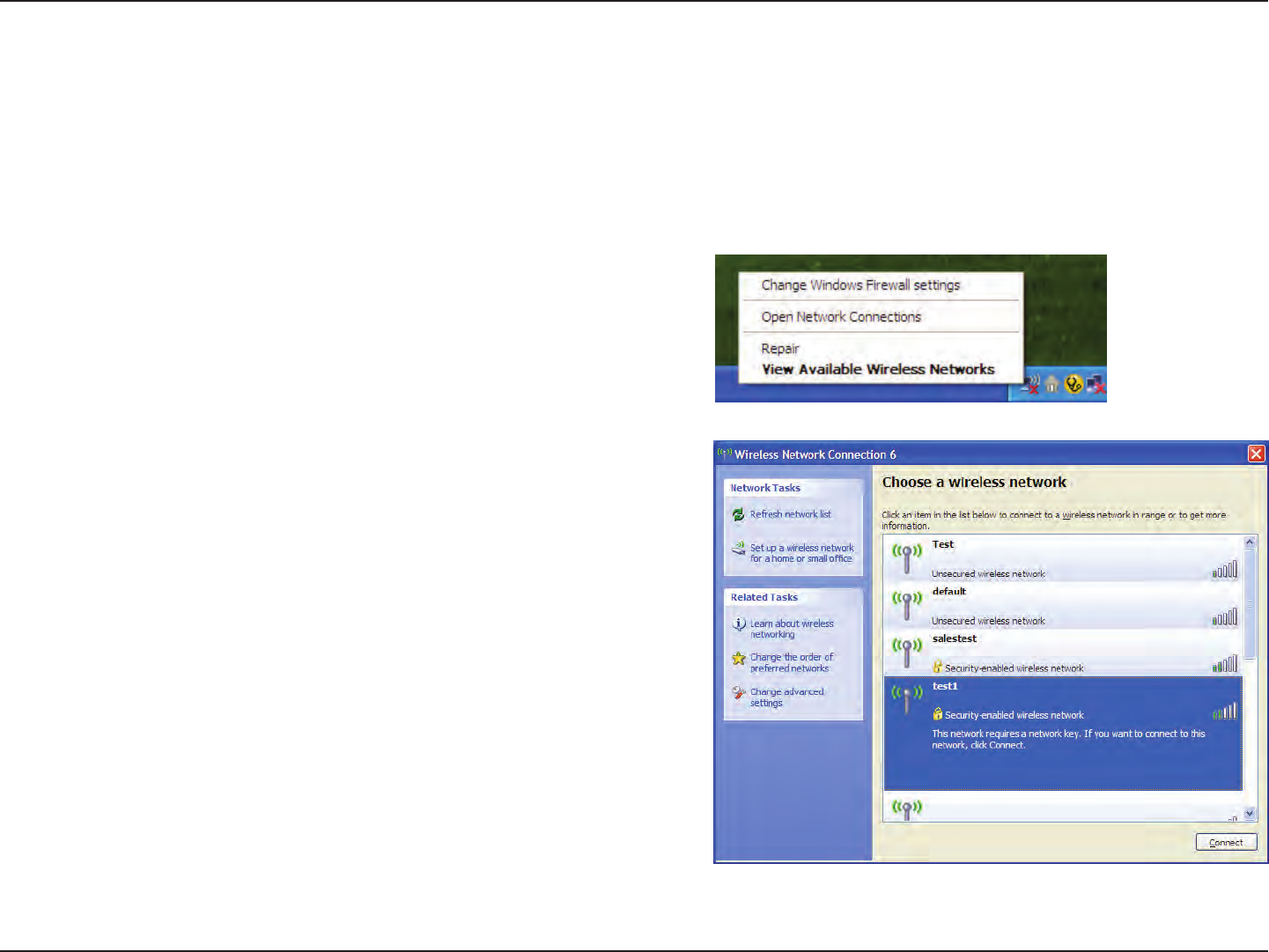
55D-Link DAP-3320 User Manual
Section 5 - Connecting to a Wireless Network
Congure WPA-PSK
It is recommended to enable WEP on your wireless bridge or access point before conguring your wireless adapter. If you are
joining an existing network, you will need to know the WEP key being used.
2. Highlight the wireless network (SSID) you would like to
connect to and click Connect.
1. Open the Windows® XP Wireless Utility by right-clicking
on the wireless computer icon in your system tray
(lower-right corner of screen). Select View Available Wireless
Networks.
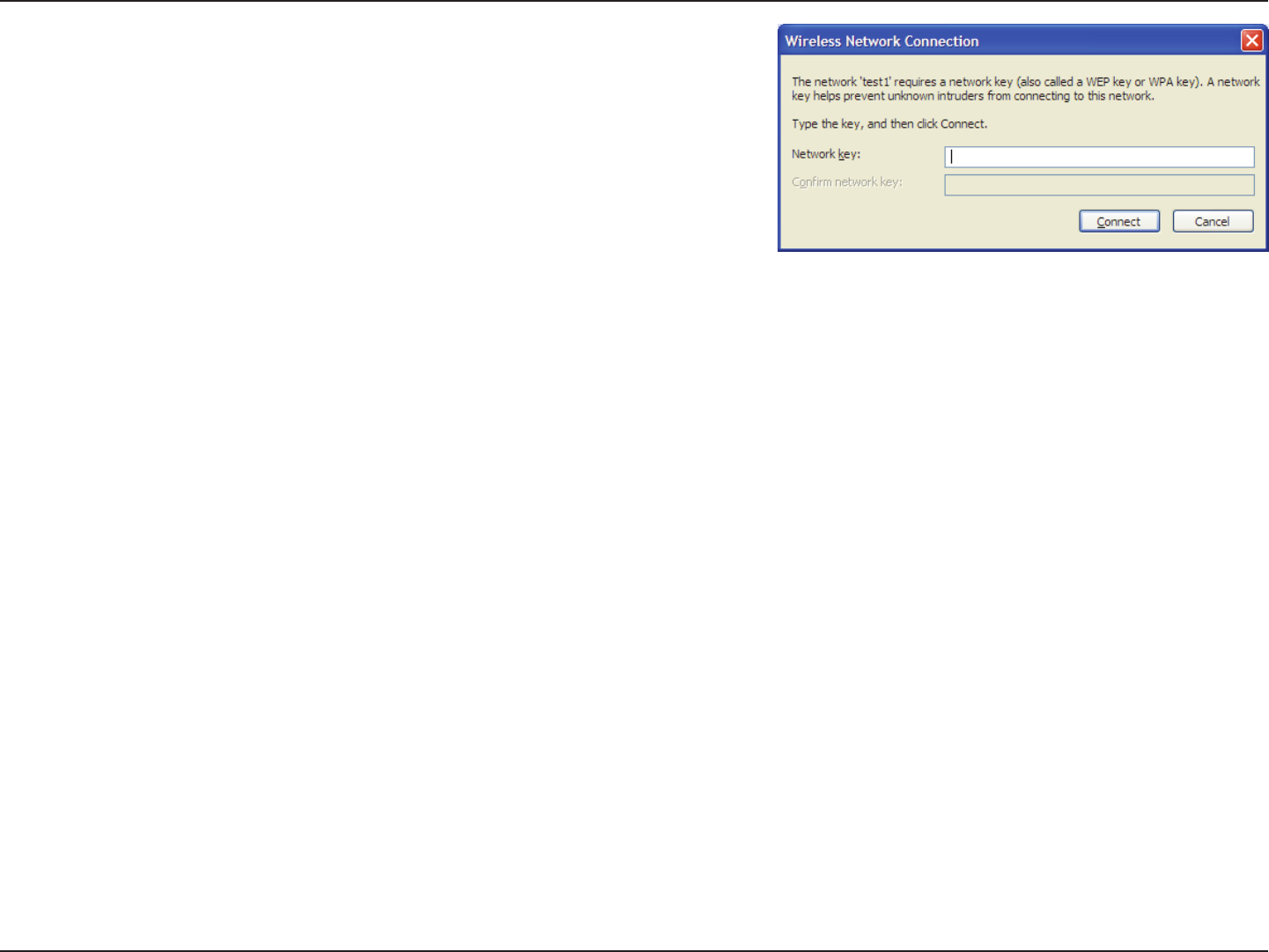
56D-Link DAP-3320 User Manual
Section 5 - Connecting to a Wireless Network
3. The Wireless Network Connection box will appear. Enter the WPA-PSK
passphrase and click Connect.
It may take 20-30 seconds to connect to the wireless network. If the
connection fails, please verify that the WPA-PSK settings are correct. The
WPA-PSK passphrase must be exactly the same as on the wireless access
point.
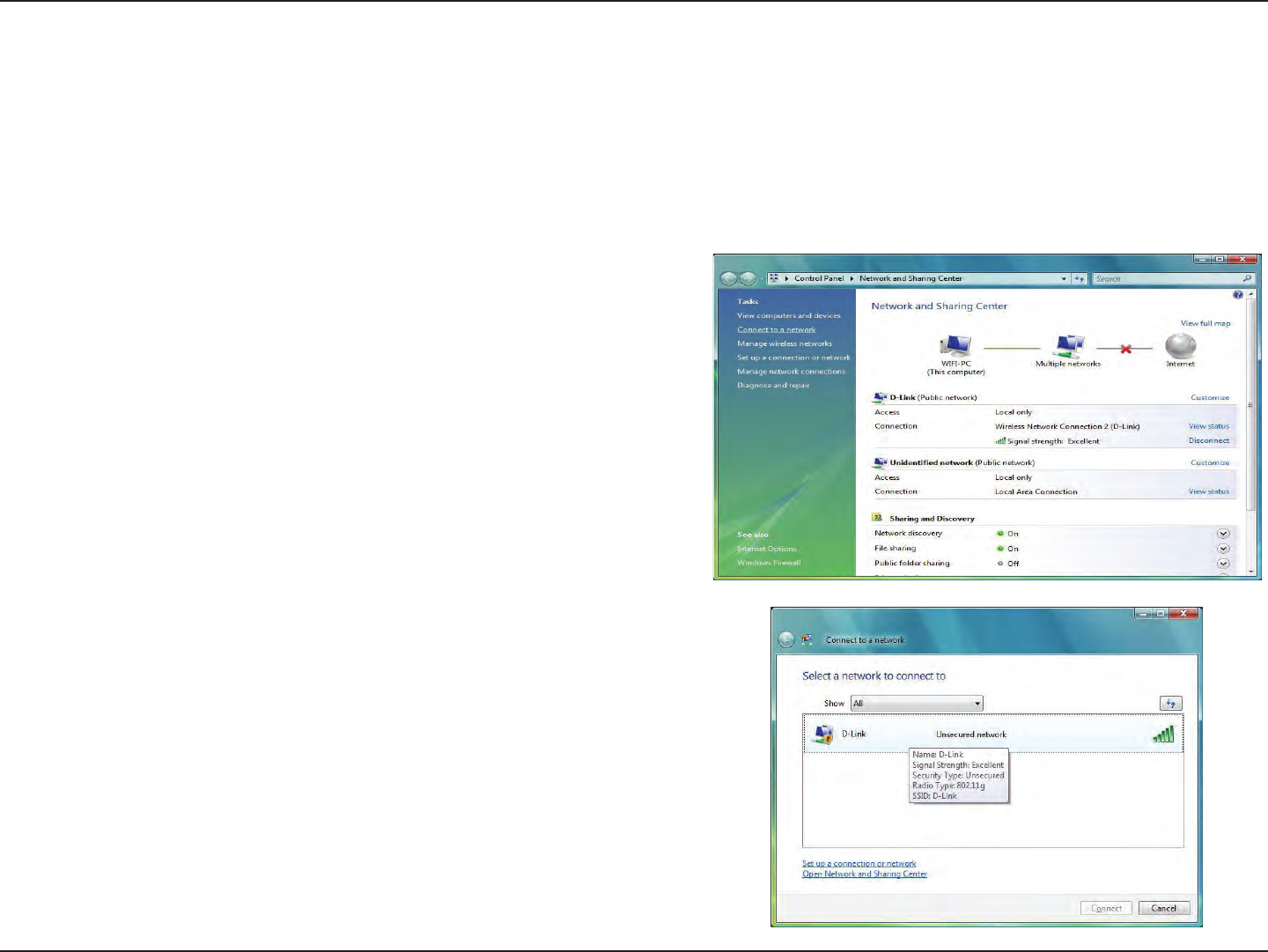
57D-Link DAP-3320 User Manual
Section 5 - Connecting to a Wireless Network
Using Windows Vista®
Windows Vista® users may use the convenient, built-in wireless utility. Follow these instructions:
From the Start menu, go to Control Panel, and then click on
Network and Sharing Center.
The utility will display any available wireless networks in your
area. Click on a network (displayed using the SSID) under Select a
network to connect to and then click the Connect button.
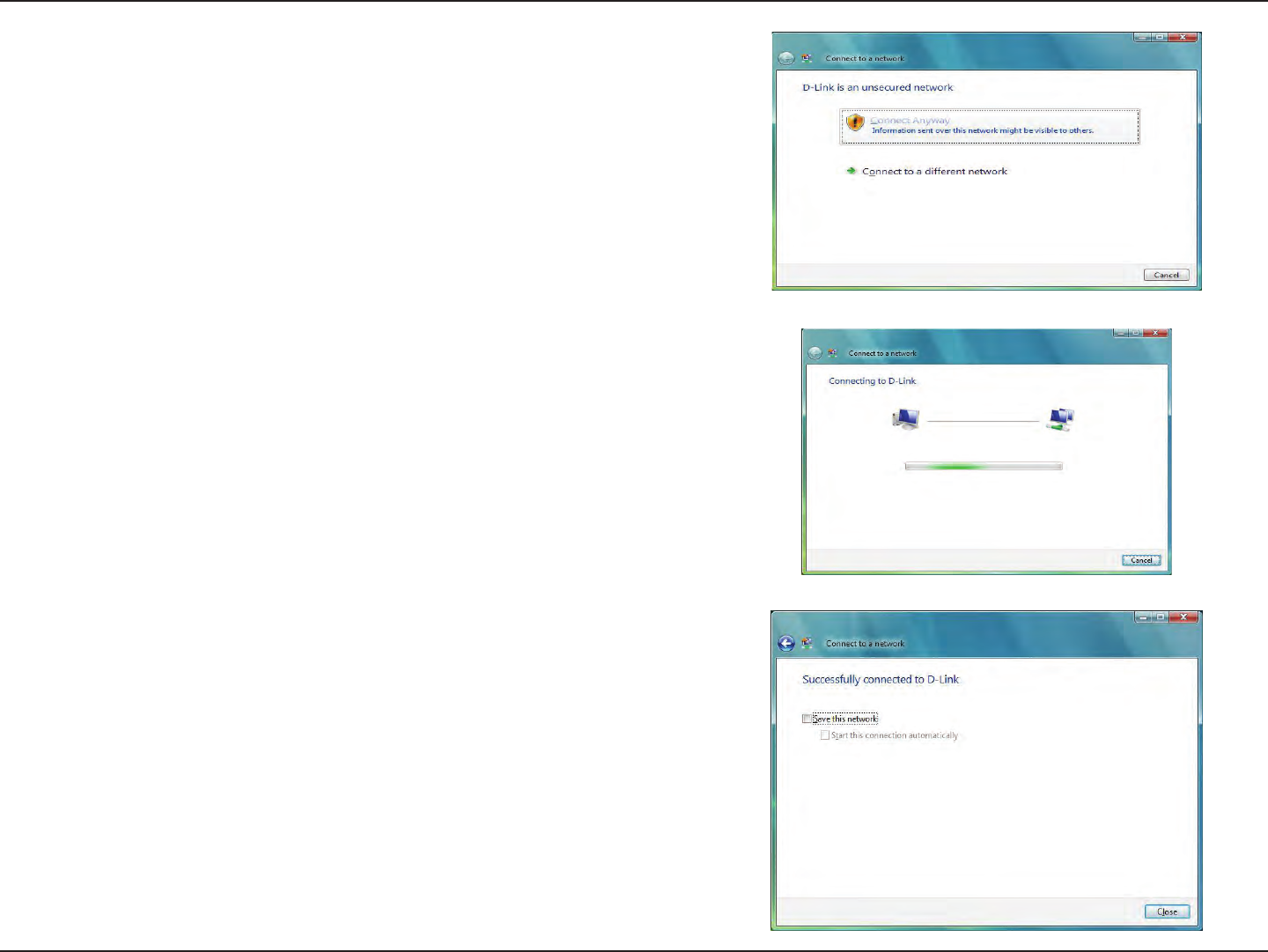
58D-Link DAP-3320 User Manual
Section 5 - Connecting to a Wireless Network
Click Connect Anyway to continue.
The utility will display the following window to indicate a
connection is being made.
The nal window indicates the establishment of a successful
connection.
The next two pages display the windows used to connect to either
a WEP or a WPA-PSK wireless network.
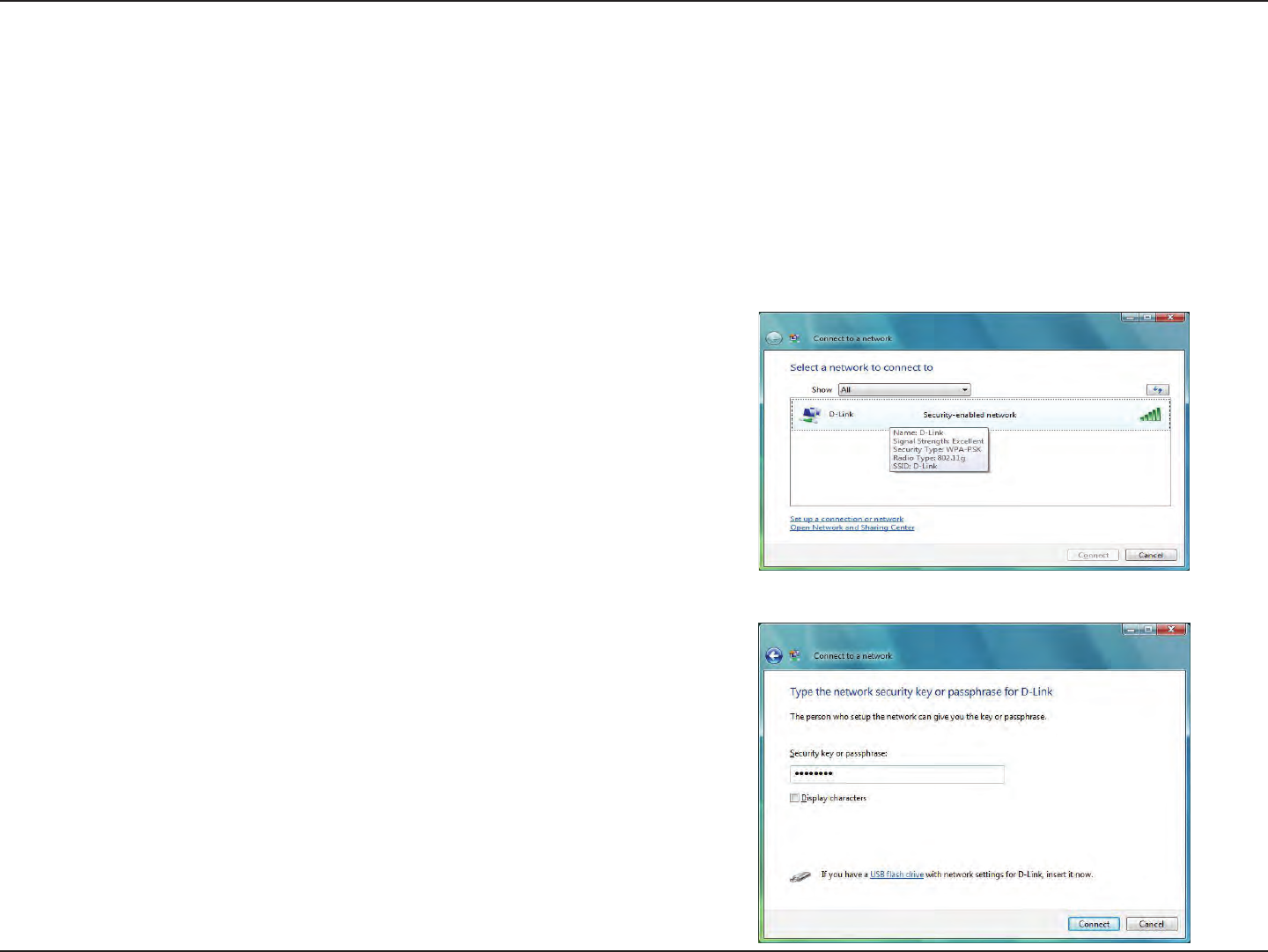
59D-Link DAP-3320 User Manual
Section 5 - Connecting to a Wireless Network
Click on a network (displayed using the SSID) using WPA-PSK under
Select a network to connect to and then click the Connect button.
Enter the appropriate security key or passphrase in the field
provided and then click the Connect button.
Congure WPA-PSK
It is recommended to enable WEP on your wireless bridge or access point before conguring your wireless adapter. If you are
joining an existing network, you will need to know the WEP key being used.
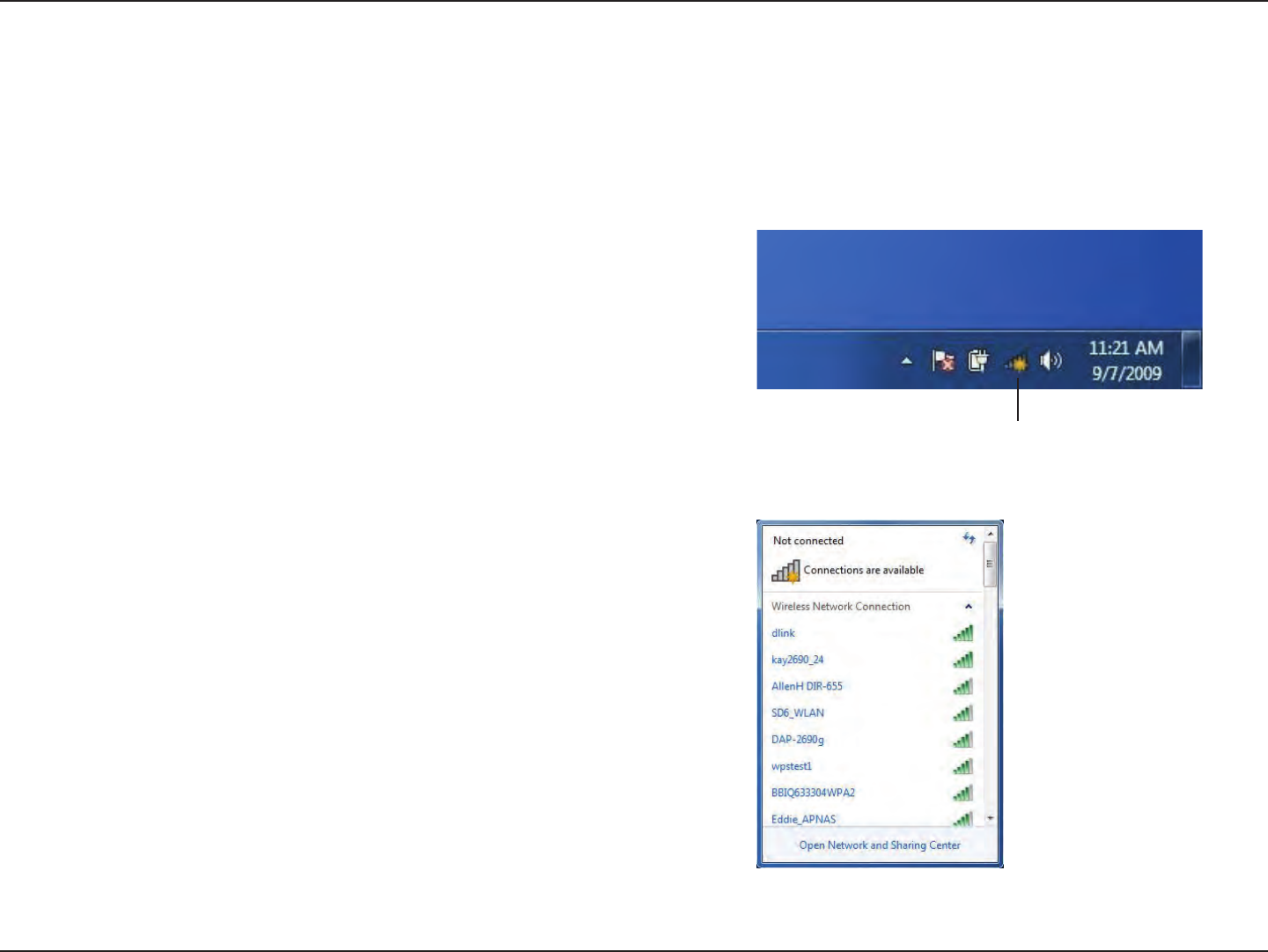
60D-Link DAP-3320 User Manual
Section 5 - Connecting to a Wireless Network
Using Windows® 7
It is recommended to enable wireless security (WPA/WPA2) on your wireless router or access point before conguring your
wireless adapter. If you are joining an existing network, you will need to know the security key or passphrase being used.
1. Click on the wireless icon in your system tray (lower-right corner).
2. The utility will display any available wireless networks in your area.
Wireless Icon
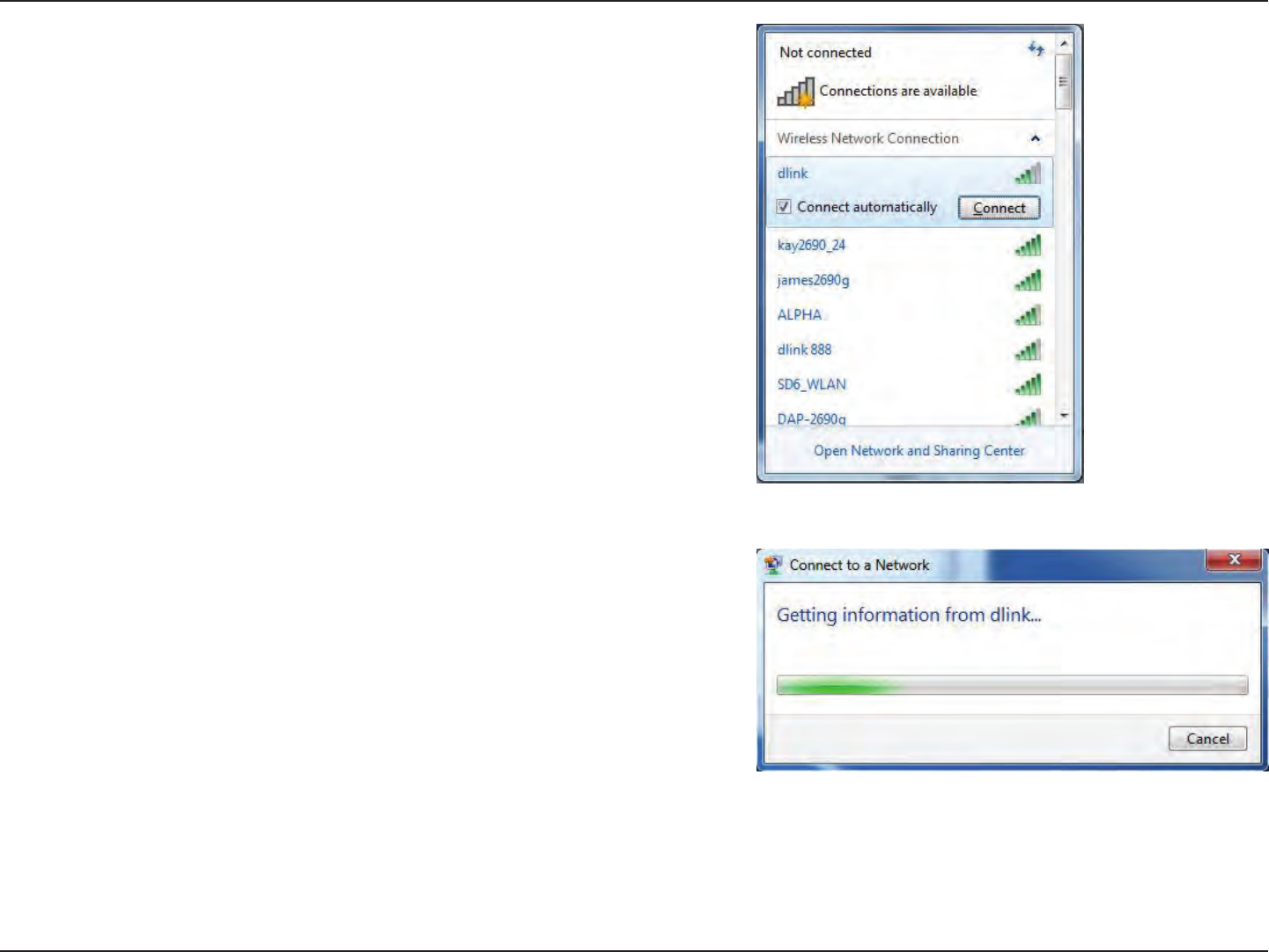
61D-Link DAP-3320 User Manual
Section 5 - Connecting to a Wireless Network
3. Highlight the wireless network (SSID) you would like to connect to
and click the Connect button.
If you get a good signal but cannot access the Internet, check your
TCP/IP settings for your wireless adapter. Refer to the Networking
Basics section in this manual for more information.
4. The following window appears while your computer tries to
connect to the router.
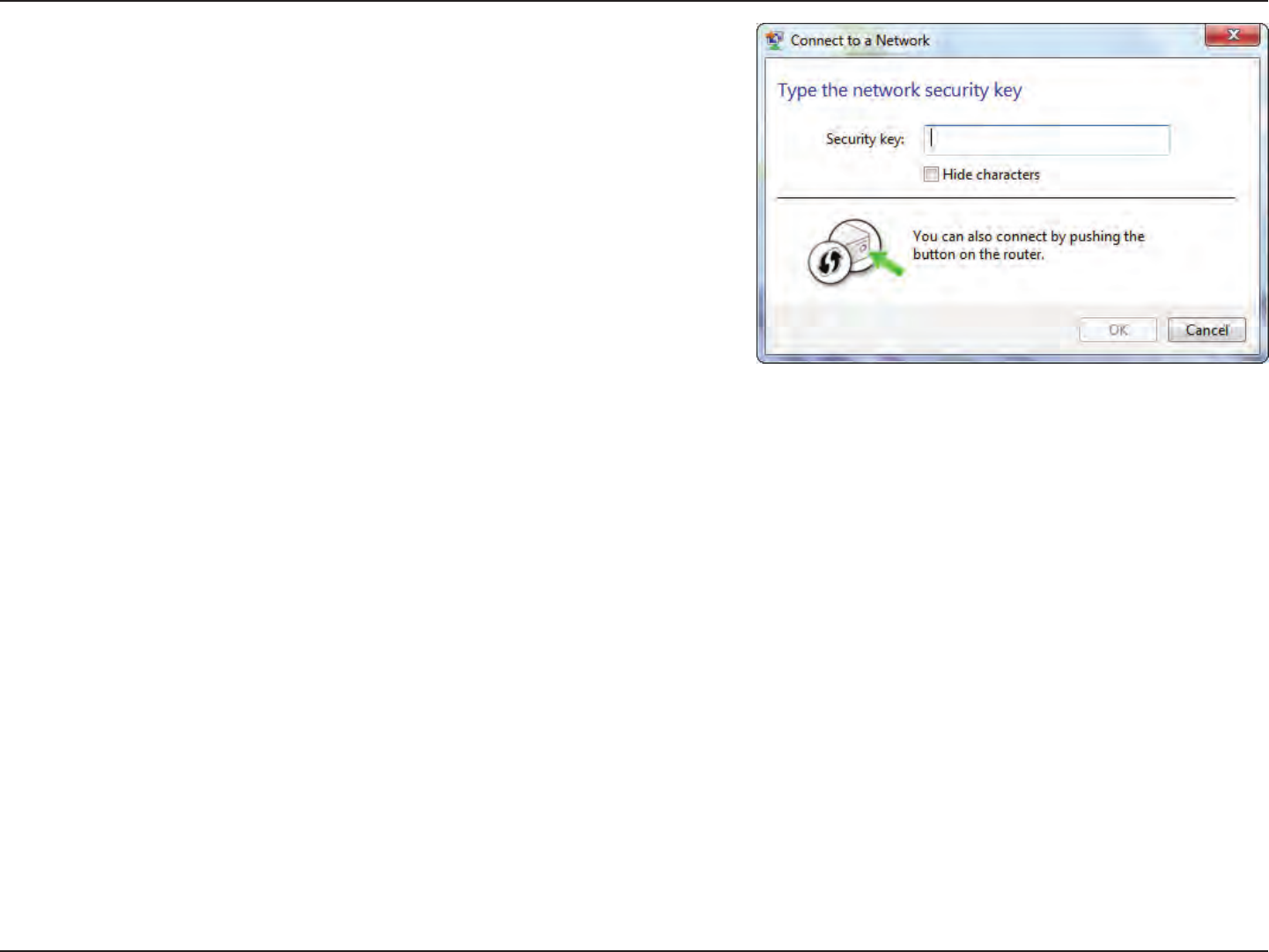
62D-Link DAP-3320 User Manual
Section 5 - Connecting to a Wireless Network
5. Enter the same security key or passphrase that is on your router
and click Connect. You can also connect by pushing the WPS
button on the router.
It may take 20-30 seconds to connect to the wireless network. If the
connection fails, please verify that the security settings are correct.
The key or passphrase must be exactly the same as on the wireless
router.

63D-Link DAP-3320 User Manual
Section 6 - Troubleshooting
Troubleshooting
This chapter provides solutions to problems that can occur during the installation and operation of the DAP-3320. Read the
following descriptions if you are having problems. (The examples below are illustrated in Windows® XP. If you have a dierent
operating system, the screenshots on your computer will look similar to the following examples.)
1. Why can’t I access the web-based conguration utility?
When entering the IP address of the D-Link access point (dlinkapwxyz.local for example, with wxyz the last four digits of the
AP’s MAC Address), you are not connecting to a website on the Internet or have to be connected to the Internet. The device
has the utility built-in to the device itself. Your computer must be on the same IP subnet to connect to the web-based utility.
• Make sure you have an updated Java-enabled web browser. We recommend the following:
- Microsoft Internet Explorer® 7 and higher
- Mozilla Firefox 12.0 and higher
- Google™ Chrome 20.0 and higher
- Apple Safari 4 and higher
• Verify physical connectivity by checking for solid link lights on the device. If you do not get a solid link light, try using a dierent
cable or connect to a dierent port on the device if possible. If the computer is turned o, the link light may not be on.
• Disable any internet security software running on the computer. Software rewalls such as Zone Alarm, Black Ice, Sygate,
Norton Personal Firewall, and Windows® XP rewall may block access to the conguration pages. Check the help les included
with your rewall software for more information on disabling or conguring it.

64D-Link DAP-3320 User Manual
Section 6 - Troubleshooting
• Congure your Internet settings:
• Go to Start > Settings > Control Panel. Double-click the Internet Options Icon. From the Security tab, click
the button to restore the settings to their defaults.
• Click the Connection tab and set the dial-up option to Never Dial a Connection. Click the LAN Settings button.
Make sure nothing is checked. Click OK.
• Go to the Advanced tab and click the button to restore these settings to their defaults. Click OK three times.
• Close your web browser (if open) and open it.
• Access the web management. Open your web browser and enter the IP address of your D-Link access point in the address
bar. This should open the login page for your the web management.
• If you still cannot access the conguration, unplug the power to the access point for 10 seconds and plug back in. Wait about
30 seconds and try accessing the conguration. If you have multiple computers, try connecting using a dierent computer.
2. What can I do if I forgot my password?
If you forgot your password, you must reset your access point. Unfortunately this process will change all your settings back to
the factory defaults.
To reset the access point, locate the reset button (hole) on the rear panel of the unit. With the access point powered on, use a
paperclip to hold the button down for 10 seconds. Release the button and the access point will go through its reboot process.
Wait about 30 seconds to access the access point. The default IP address is 192.168.0.50. When logging in, the username is
Admin and leave the password box empty.
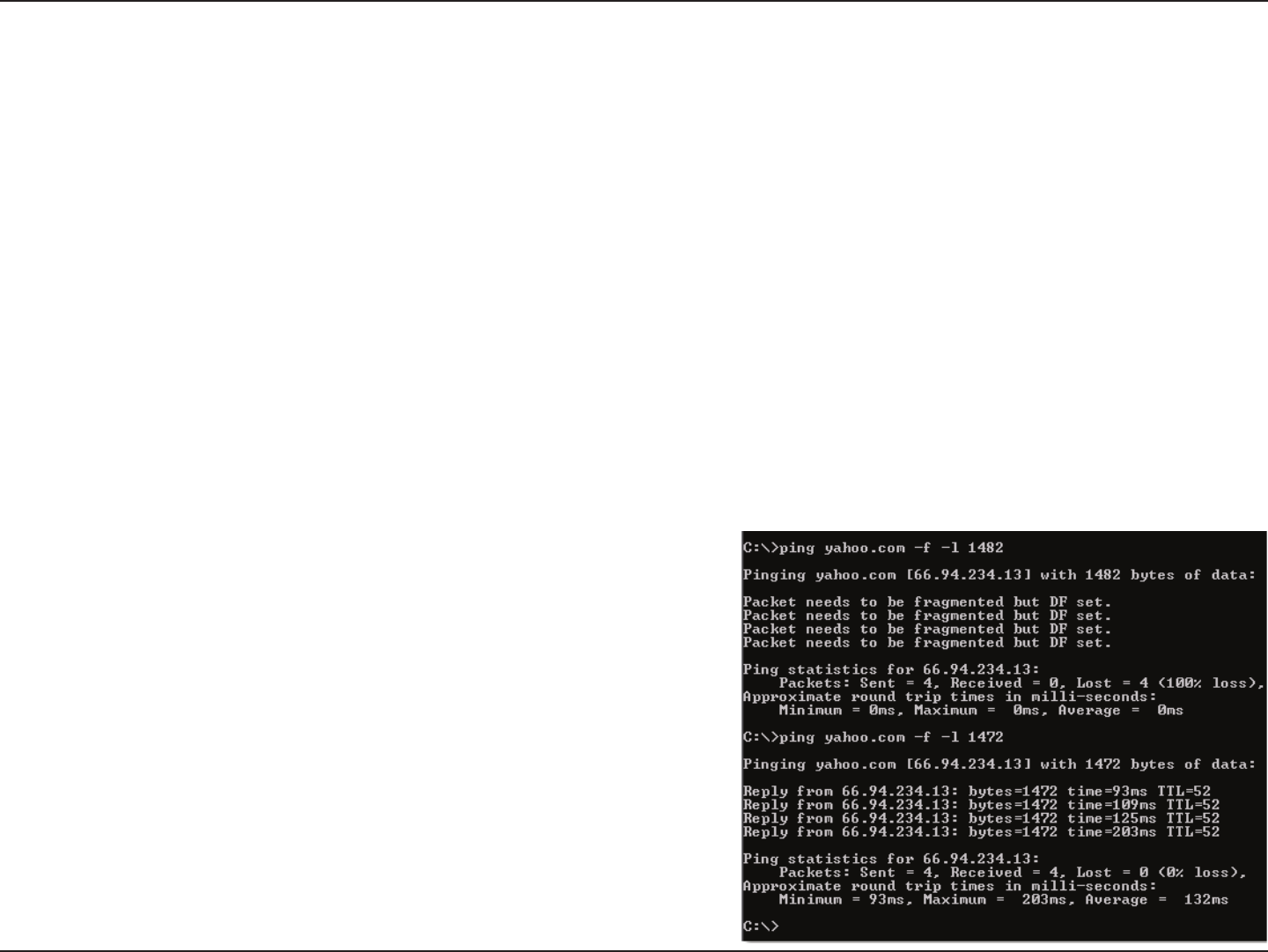
65D-Link DAP-3320 User Manual
Section 6 - Troubleshooting
3. Why can’t I connect to certain sites or send and receive emails when connecting through my access point?
If you are having a problem sending or receiving email, or connecting to secure sites such as eBay, banking sites, and Hotmail,
we suggest lowering the MTU in increments of ten (Ex. 1492, 1482, 1472, etc).
Note: AOL DSL+ users must use MTU of 1400.
To nd the proper MTU Size, you’ll have to do a special ping of the destination you’re trying to go to. A destination could be
another computer, or a URL.
• Click on Start and then click Run.
• Windows® 95, 98, and Me users type in command (Windows® NT, 2000, and XP users type in cmd) and press Enter
(or click OK).
• Once the window opens, you’ll need to do a special ping. Use the following syntax:
ping [url] [-f] [-l] [MTU value]
Example: ping yahoo.com -f -l 1472

66D-Link DAP-3320 User Manual
Section 6 - Troubleshooting
You should start at 1472 and work your way down by 10 each time. Once you get a reply, go up by 2 until you get a fragmented
packet. Take that value and add 28 to the value to account for the various TCP/IP headers. For example, lets say that 1452 was the
proper value, the actual MTU size would be 1480, which is the optimum for the network we’re working with (1452+28=1480).
Once you nd your MTU, you can now congure your access point with the proper MTU size.
To change the MTU rate on your access point follow the steps below:
• Open your browser, enter the IP address of your access point (192.168.0.50) and click OK.
• Enter your username (Admin) and password (blank by default). Click OK to enter the web conguration page
for the device.
• Click on Setup and then click Manual Congure.
• To change the MTU enter the number in the MTU eld and click Save Settings to save your settings.
• Test your email. If changing the MTU does not resolve the problem, continue changing the MTU in increments
of ten.

67D-Link DAP-3320 User Manual
Appendix A - Wireless Basics
D-Link wireless products are based on industry standards to provide easy-to-use and compatible high-speed wireless
connectivity within your home, business or public access wireless networks. Strictly adhering to the IEEE standard, the D-Link
wireless family of products will allow you to securely access the data you want, when and where you want it. You will be able
to enjoy the freedom that wireless networking delivers.
A wireless local area network (WLAN) is a cellular computer network that transmits and receives data with radio signals instead of
wires. Wireless LANs are used increasingly in both home and oce environments, and public areas such as airports, coee shops
and universities. Innovative ways to utilize WLAN technology are helping people to work and communicate more eciently.
Increased mobility and the absence of cabling and other xed infrastructure have proven to be benecial for many users.
Wireless users can use the same applications they use on a wired network. Wireless adapter cards used on laptop and desktop
systems support the same protocols as Ethernet adapter cards.
Under many circumstances, it may be desirable for mobile network devices to link to a conventional Ethernet LAN in order
to use servers, printers or an Internet connection supplied through the wired LAN. A Wireless Access point is a device used to
provide this link.
Wireless Basics

68D-Link DAP-3320 User Manual
Appendix A - Wireless Basics
What is Wireless?
Wireless or Wi-Fi technology is another way of connecting your computer to the network without using wires. Wi-Fi uses radio
frequency to connect wirelessly, so you have the freedom to connect computers anywhere in your home or oce.
D-Link is the worldwide leader and award winning designer, developer, and manufacturer of networking products. D-Link
delivers the performance you need at a price you can aord. D-Link has all the products you need to build your network.
How does wireless work?
Wireless works similar to how cordless phone work, through radio signals to transmit data from one point A to point B. But
wireless technology has restrictions as to how you can access the network. You must be within the wireless network range area
to be able to connect your computer. There are two dierent types of wireless networks Wireless Local Area Network (WLAN),
and Wireless Personal Area Network (WPAN).
Wireless Local Area Network (WLAN)
In a wireless local area network, a device called an Access Point (AP) connects computers to the network. The access point has
a small antenna attached to it, which allows it to transmit data back and forth over radio signals. With an indoor access point
as seen in the picture, the signal can travel up to 300 feet. With an outdoor access point the signal can reach out up to 30 miles
to serve places like manufacturing plants, industrial locations, college and high school campuses, airports, golf courses, and
many other outdoor venues.

69D-Link DAP-3320 User Manual
Appendix A - Wireless Basics
Wireless Personal Area Network (WPAN)
Bluetooth is the industry standard wireless technology used for WPAN. Bluetooth devices in WPAN operate in a range up to
30 feet away.
Compared to WLAN the speed and wireless operation range are both less than WLAN, but in return it doesn’t use nearly as
much power which makes it ideal for personal devices, such as mobile phones, PDAs, headphones, laptops, speakers, and other
devices that operate on batteries.
Who uses wireless?
Wireless technology has become so popular in recent years that almost everyone is using it, whether it’s for home, oce,
business, D-Link has a wireless solution for it.
Home
• Gives everyone at home broadband access
• Surf the web, check email, instant message, etc.
• Gets rid of the cables around the house
• Simple and easy to use
Small Oce and Home Oce
• Stay on top of everything at home as you would at oce
• Remotely access your oce network from home
• Share Internet connection and printer with multiple computers
• No need to dedicate oce space

70D-Link DAP-3320 User Manual
Appendix A - Wireless Basics
Where is wireless used?
Wireless technology is expanding everywhere not just at home or oce. People like the freedom of mobility and it’s becoming
so popular that more and more public facilities now provide wireless access to attract people. The wireless connection in public
places is usually called “hotspots”.
Using a D-Link Cardbus Adapter with your laptop, you can access the hotspot to connect to Internet from remote locations
like: Airports, Hotels, Coee Shops, Libraries, Restaurants, and Convention Centers.
Wireless network is easy to setup, but if you’re installing it for the rst time it could be quite a task not knowing where to start.
That’s why we’ve put together a few setup steps and tips to help you through the process of setting up a wireless network.
Tips
Here are a few things to keep in mind, when you install a wireless network.
Centralize your access point or Access Point
Make sure you place the bridge/access point in a centralized location within your network for the best performance. Try to
place the bridge/access point as high as possible in the room, so the signal gets dispersed throughout your home. If you have
a two-story home, you may need a Repeater to boost the signal to extend the range.
Eliminate Interference
Place home appliances such as cordless telephones, microwaves, wireless speakers, and televisions as far away as possible from
the bridge/access point. This would signicantly reduce any interference that the appliances might cause since they operate
on same frequency.

71D-Link DAP-3320 User Manual
Appendix A - Wireless Basics
Security
Don’t let your next-door neighbors or intruders connect to your wireless network. Secure your wireless network by turning
on the WPA or WEP security feature on the access point. Refer to product manual for detail information on how to set it up.
There are basically two modes of networking:
• Infrastructure – All wireless clients will connect to an access point or wireless bridge.
• Ad-Hoc – Directly connecting to another computer, for peer-to-peer communication, using wireless network
adapters on each computer, such as two or more wireless network Cardbus adapters.
An Infrastructure network contains an Access Point or wireless bridge. All the wireless devices, or clients, will connect to the
wireless bridge or access point.
An Ad-Hoc network contains only clients, such as laptops with wireless cardbus adapters. All the adapters must be in Ad-Hoc
mode to communicate.
Wireless Modes
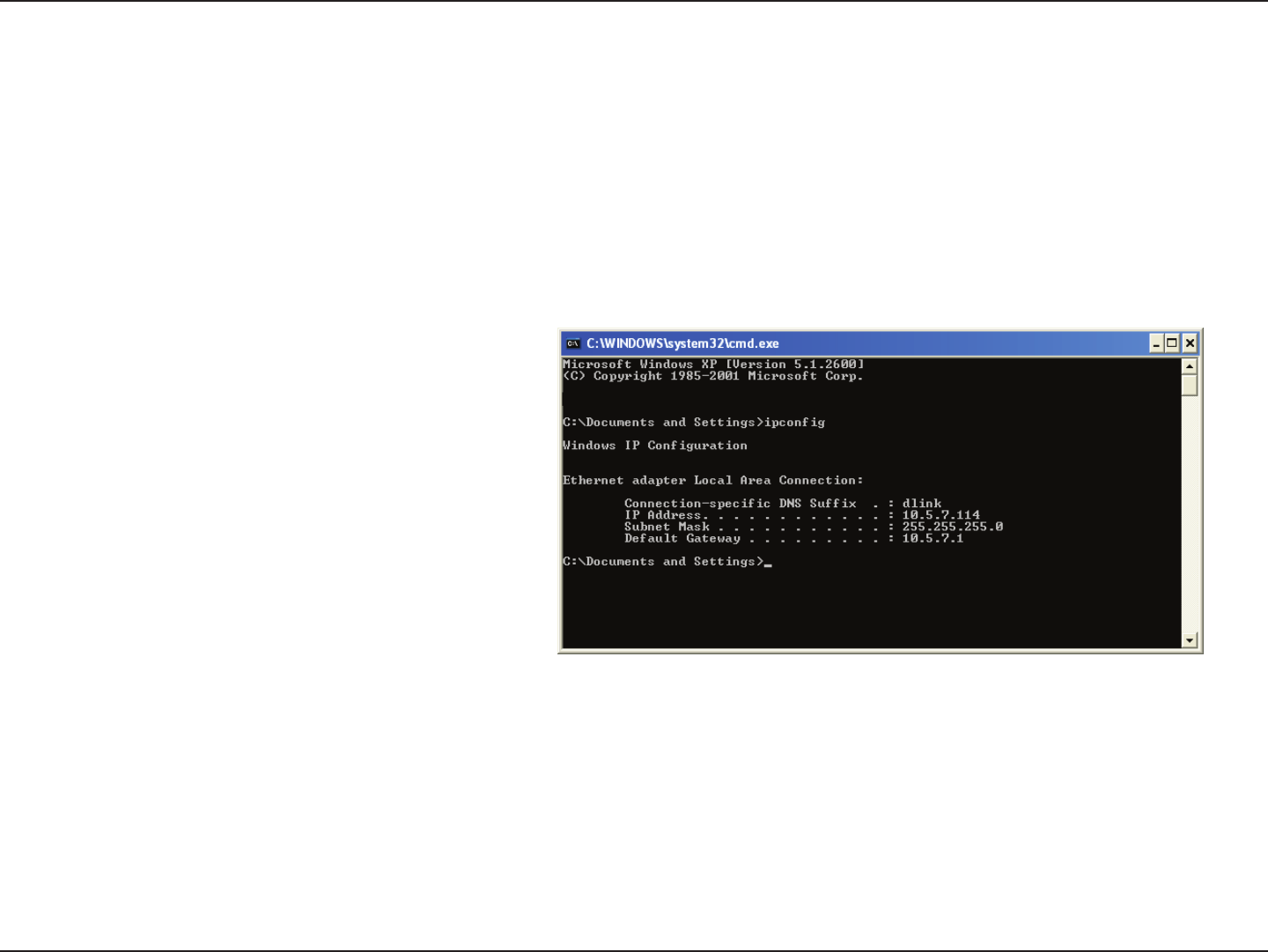
72D-Link DAP-3320 User Manual
Appendix B - Networking Basics
Networking Basics
Check your IP address
After you install your adapter, by default, the TCP/IP settings should be set to obtain an IP address from a DHCP server (i.e.
wireless router) automatically. To verify your IP address, please follow the steps below.
Click on Start > Run. In the run box type cmd and click OK. (Windows® 7/Vista® users type cmd in the Start Search box.)
At the prompt, type ipcong and press Enter.
This will display the IP address, subnet mask, and the
default gateway of your adapter.
If the address is 0.0.0.0, check your adapter installation,
security settings, and the settings on your router.
Some rewall software programs may block a DHCP
request on newly installed adapters.
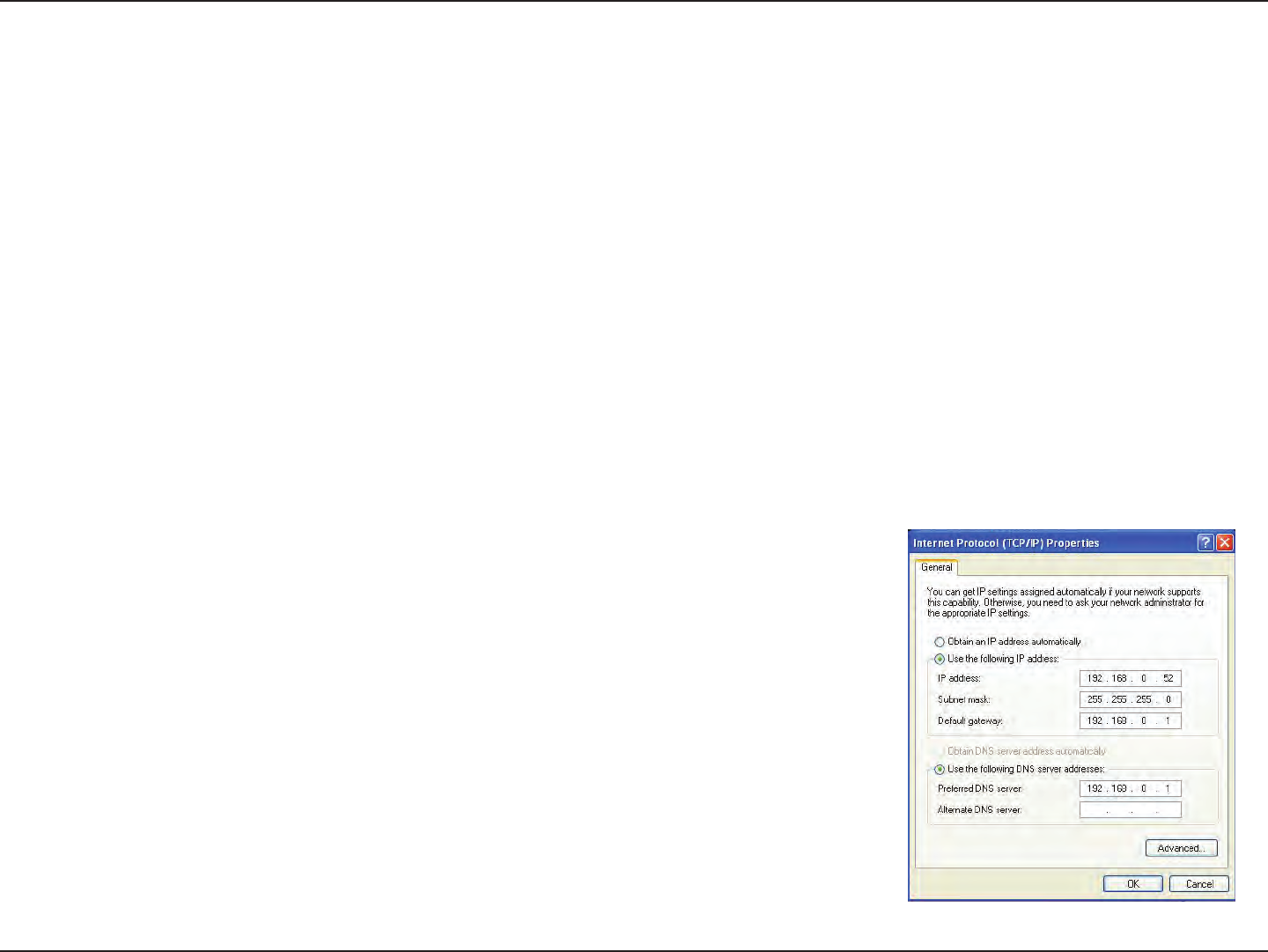
73D-Link DAP-3320 User Manual
Appendix B - Networking Basics
Statically Assign an IP address
If you are not using a DHCP capable gateway/router, or you need to assign a static IP address, please follow the steps below:
Step 1
Windows® 7 - Click on Start > Control Panel > Network and Internet > Network and Sharing Center > Change Adapter
Setting.
Windows Vista® - Click on Start > Control Panel > Network and Internet > Network and Sharing Center > Manage Network
Connections.
Windows® XP - Click on Start > Control Panel > Network Connections.
Windows® 2000 - From the desktop, right-click My Network Places > Properties.
Step 2
Right-click on the Local Area Connection which represents your network adapter and select Properties.
Step 3
Highlight Internet Protocol (TCP/IP) and click Properties.
Step 4
Click Use the following IP address and enter an IP address that is on the same subnet
as your network or the LAN IP address on your router.
Example: If the router´s LAN IP address is 192.168.0.1, make your IP address 192.168.0.X
where X is a number between 2 and 99. Make sure that the number you choose is not in
use on the network. Set Default Gateway the same as the LAN IP address of your router
(192.168.0.1).
Set Primary DNS the same as the LAN IP address of your router (192.168.0.1). The
Secondary DNS is not needed or you may enter a DNS server from your ISP.
Step 5
Click OK twice to save your settings.

74D-Link DAP-3320 User Manual
Appendix C - Technical Specications
Technical Specications
Standards
• IEEE 802.11n/g/b
•IEEE 802.3
•IEEE 802.3u
•IEEE 802.3af
Network Management
•Web Browser Interface
• HTTP - Secure HTTP (HTTPS)
•SNMP v1 and V2C
Security
• WPA-Personal & Enterprise
• WPA2-Personal & Enterprise
• WEP 64/128 bit Encryption
• 802.1X
Wireless Frequencyt
• 2.4 GHz to 2.4835 GHz
Operational Modes
•Access Point
•Wireless Distribution System
•Wireless Distribution System with AP
•Wireless Client
Antenna
• Built-in 2dBi antenna
Maximum Transmit Power Ouput1
• 29.55dBm (901mW)
Maximum Power Input
• 48 V/ 0.5 A
Maximum Power Consumption
•12.5 watts
LEDs
• Power
Operating Temperature
• Operating: -20 to 60 °C (-4 to 140 °F)
• Storage: -20 to 85 °C (-4 to 185 °F)
Humidity
• Operating: 0 to 90% (non-condensing)
• Storage: 5 to 95% (non-condensing)
Safety & Emissions
• FCC
• IC
• CE
Dimensions (L x W x H)
• 118 x 56 x 195 mm (4.64 x 2.2 x 7.67 inches)
1 Range will vary depending on country’s maximum transmit power output regulation. Maximum wireless signal rate derived from IEEE Standard 802.11g and 802.11n specications.
Actual data throughput will vary. Network conditions and environmental factors, including volume of network trac, building materials and construction, and network overhead,
lower actual data throughput rate. Environmental conditions will adversely aect wireless signal range.

75D-Link DAP-3320 User Manual
Appendix E - Warranty
Warranty
FCC Statement:
Federal Communication Commission Interference Statement
This equipment has been tested and found to comply with the limits for a Class B digital device, pursuant to Part 15 of the FCC Rules. These limits
are designed to provide reasonable protection against harmful interference in a residential installation. This equipment generates, uses and
can radiate radio frequency energy and, if not installed and used in accordance with the instructions, may cause harmful interference to radio
communications. However, there is no guarantee that interference will not occur in a particular installation. If this equipment does cause harmful
interference to radio or television reception, which can be determined by turning the equipment o and on, the user is encouraged to try to correct
the interference by one of the following measures:
• Reorient or relocate the receiving antenna.
• Increase the separation between the equipment and receiver.
• Connect the equipment into an outlet on a circuit dierent from that to which the receiver is connected.
• Consult the dealer or an experienced radio/TV technician for help.
FCC Caution: Any changes or modications not expressly approved by the party responsible
for compliance could void the user’s authority to operate this equipment.
This device complies with Part 15 of the FCC Rules. Operation is subject to the following two conditions: (1) This device may not cause harmful
interference, and (2) this device must accept any interference received, including interference that may cause undesired operation.
For product available in the USA/Canada market, only channel 1~11 can be operated. Selection of other channels is not possible.
This device and it’s antennas(s) must not be co-located or operating in conjunction with any other antenna or transmitter except in accordance
with FCC multi-transmitter product procedures.
IMPORTANT NOTE:
FCC Radiation Exposure Statement:
This equipment complies with FCC radiation exposure limits set forth for an uncontrolled environment. This equipment should be installed and
operated with minimum distance 20 cm between the radiator & your body.
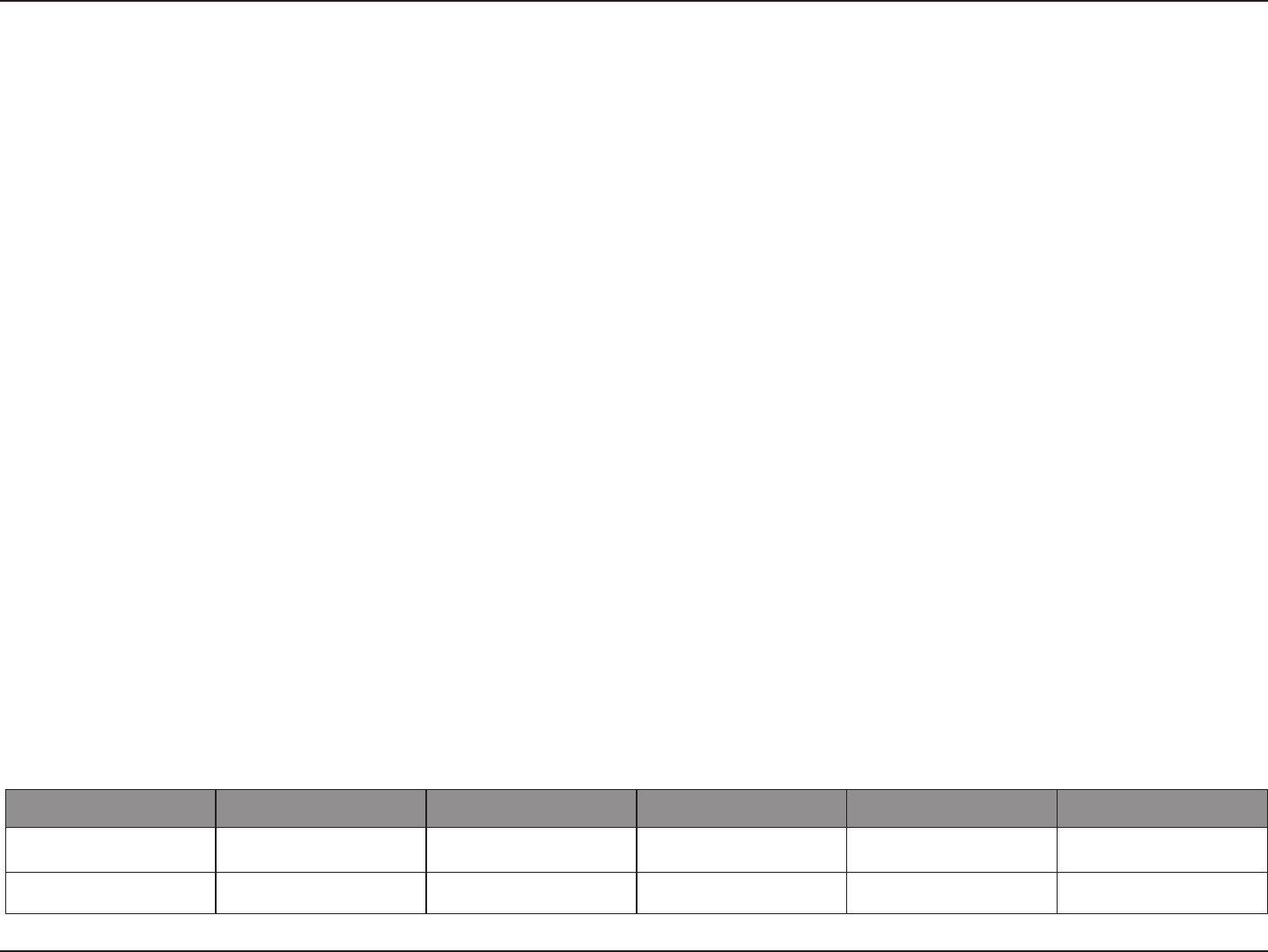
76D-Link DAP-3320 User Manual
Appendix E - Warranty
IC Statement
This device complies with Industry Canada license-exempt RSS standard(s). Operation is subject to the following two conditions: (1) this device may
not cause interference, and (2) this device must accept any interference, including interference that may cause undesired operation of the device.
Le présent appareil est conforme aux CNR d’Industrie Canada applicables aux appareils radio exempts de licence. L’exploitation est autorisée aux deux
conditions suivantes : (1) l’appareil ne doit pas produire de brouillage, et (2) l’utilisateur de l’appareil doit accepter tout brouillage radioélectrique
subi, même si le brouillage est susceptible d’en compromettre le fonctionnement.
For product available in the USA/Canada market, only channel 1~11 can be operated. Selection of other channels is not possible.
Pour les produits disponibles aux États-Unis / Canada du marché, seul le canal 1 à 11 peuvent être exploités. Sélection d’autres canaux n’est pas
possible.
This device and it’s antennas(s) must not be co-located or operating in conjunction with any other antenna or transmitter except in accordance
with IC multi-transmitter product procedures.
Cet appareil et son antenne (s) ne doit pas être co-localisés ou fonctionnement en association avec une autre antenne ou transmetteur.
IMPORTANT NOTE:
IC Radiation Exposure Statement:
This equipment complies with IC RSS-102 radiation exposure limits set forth for an uncontrolled environment. This equipment should be installed
and operated with minimum distance 20 cm between the radiator & your body.
Cet équipement est conforme aux limites d’exposition aux rayonnements IC établies pour un environnement non contrôlé. Cet équipement doit
être installé et utilisé avec un minimum de 20 cm de distance entre la source de rayonnement et votre corps.
This radio transmitter (Model: DAP-3320A1) has been approved by Industry Canada to operate with the antenna types listed below with the
maximum permissible gain and required antenna impedance for each antenna type indicated. Antenna types not included in this list, having a
gain greater than the maximum gain indicated for that type, are strictly prohibited for use with this device.
Le présent émetteur radio (Model: DAP-3320A1) a été approuvé par Industrie Canada pour fonctionner avec les types d’antenne énumérés ci-
dessous et ayant un gain admissible maximal et l’impédance requise pour chaque type d’antenne. Les types d’antenne non inclus dans cette liste,
ou dont le gain est supérieur au gain maximal indiqué, sont strictement interdits pour l’exploitation de l’émetteur.
Ant. Brand Model Name Antenna Type Connector Gain(dBi)
1 HL 290-20201 PIFA Antenna I-PEX 2
2 HL 290-20200 PIFA Antenna I-PEX 2